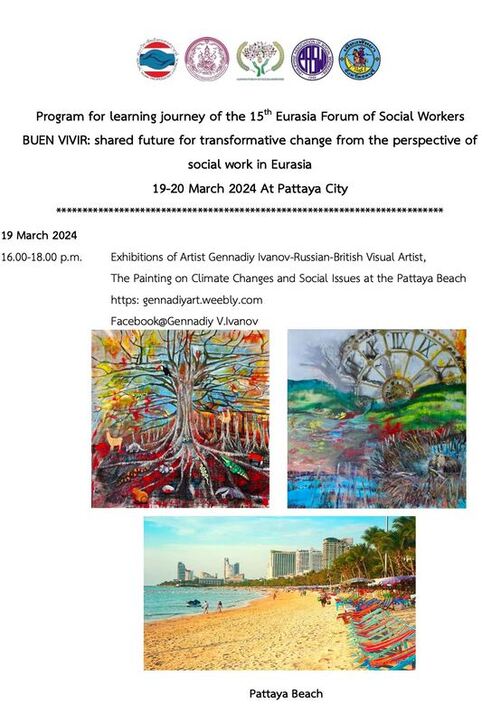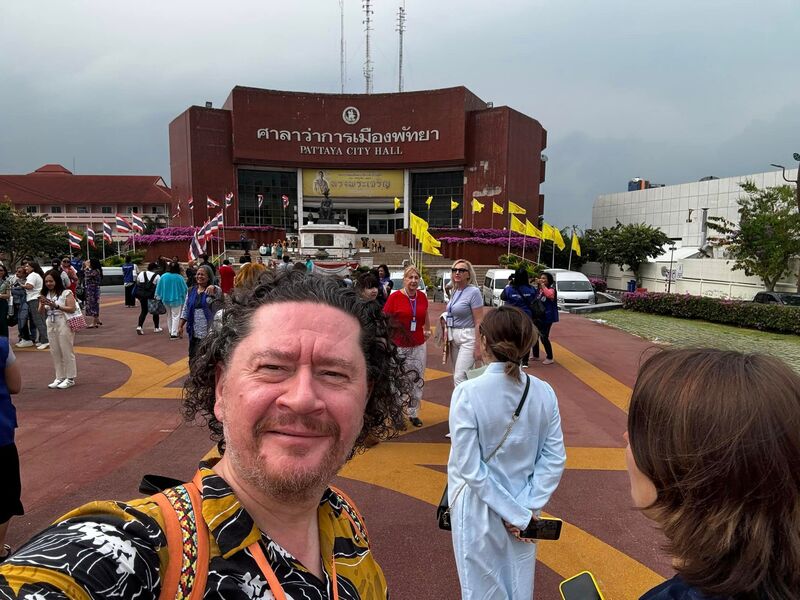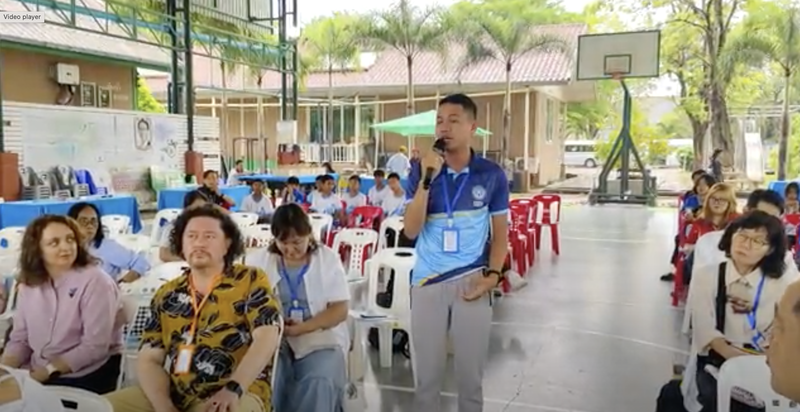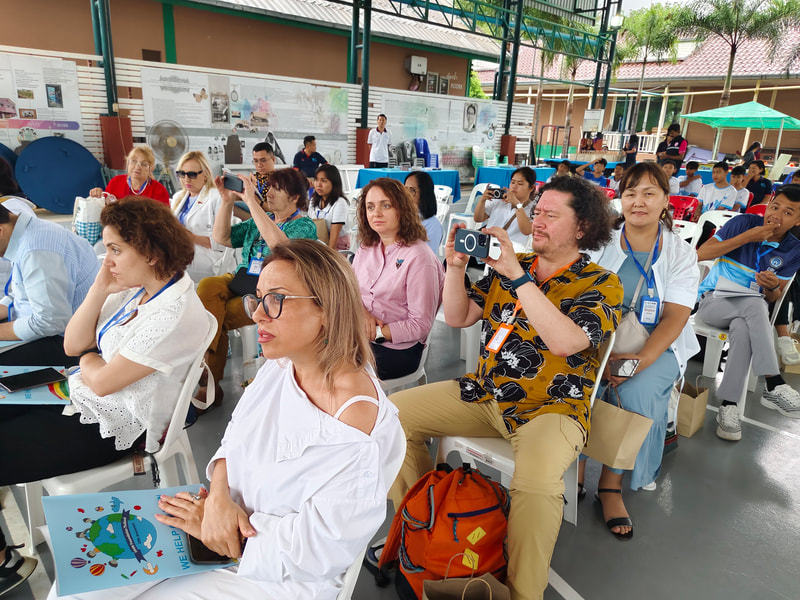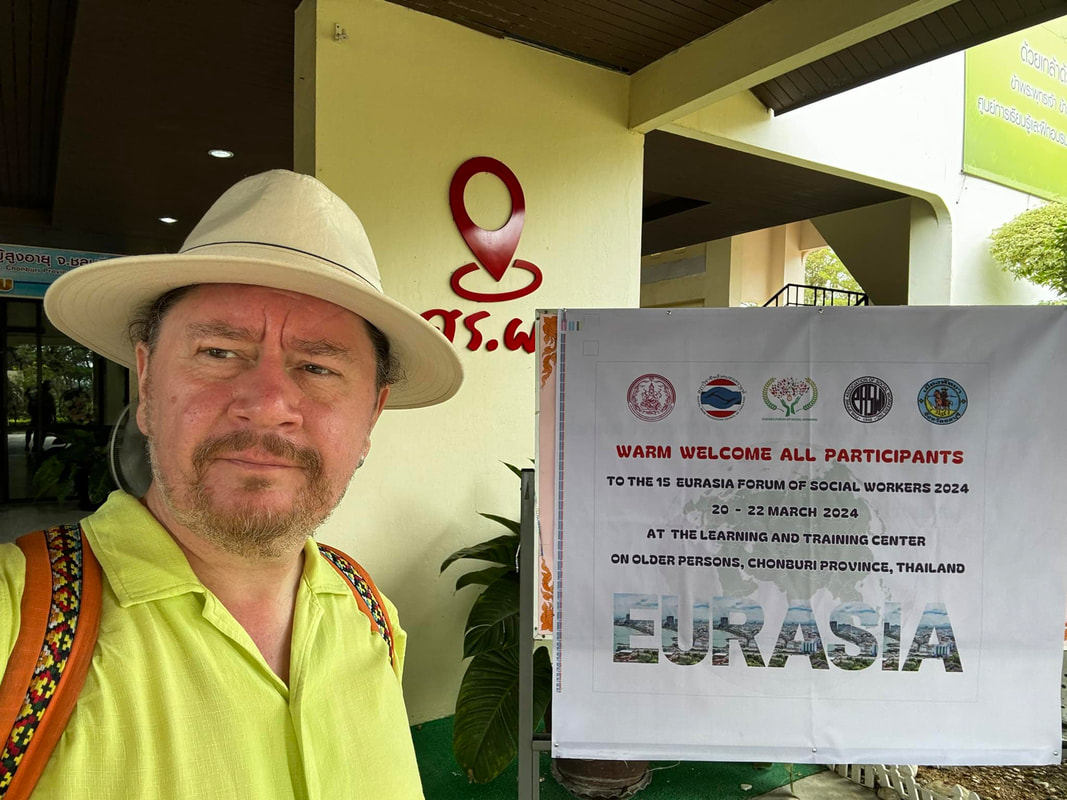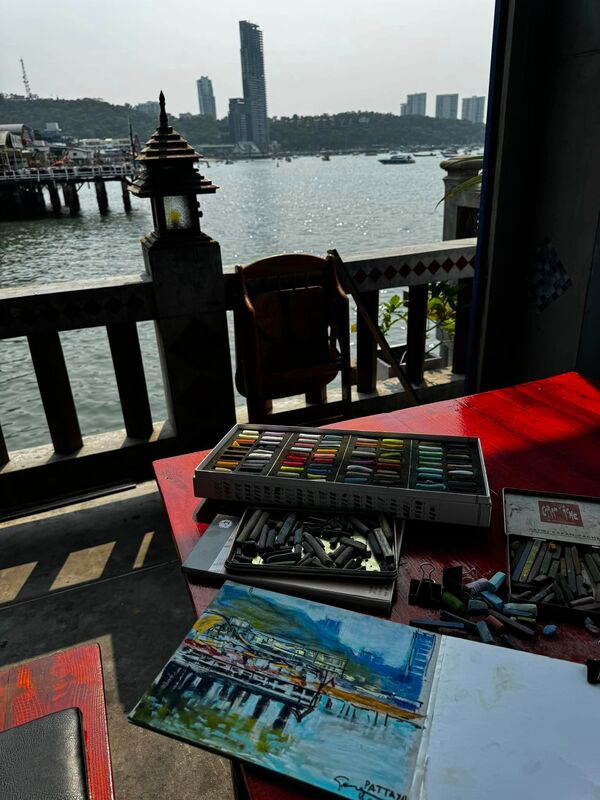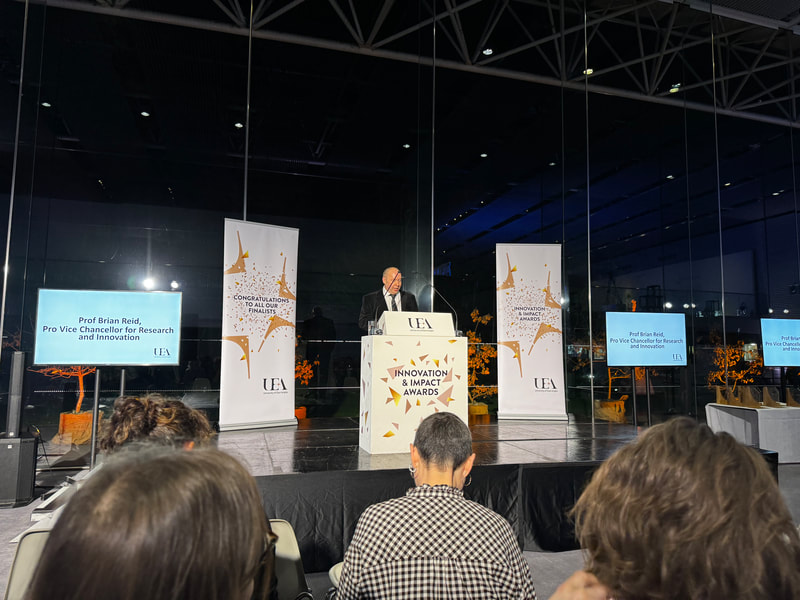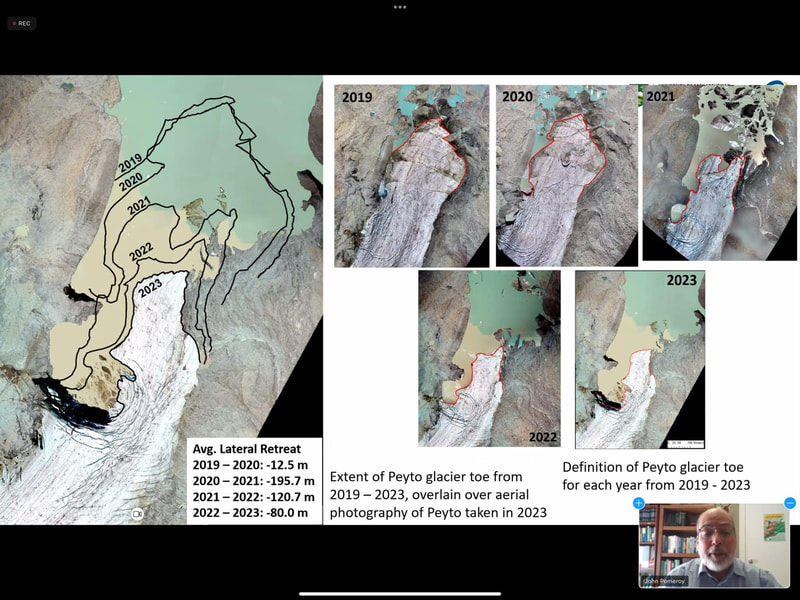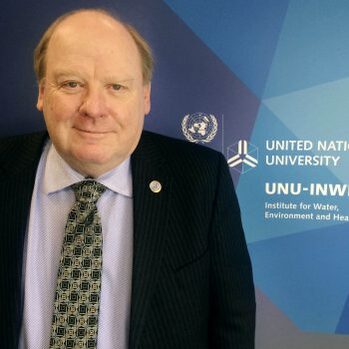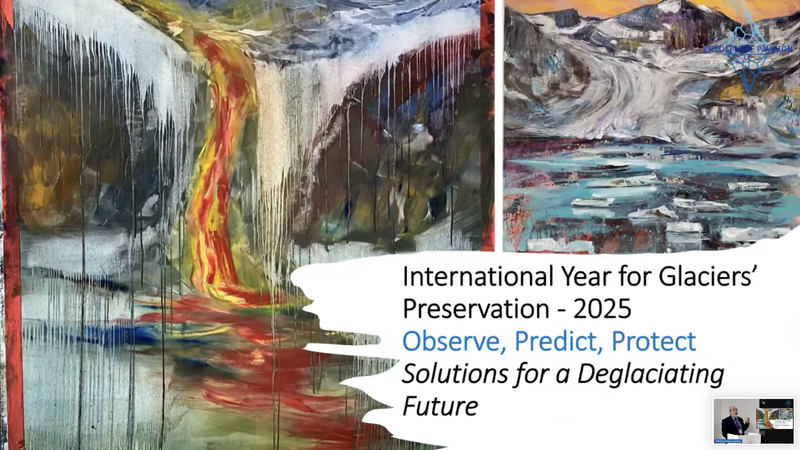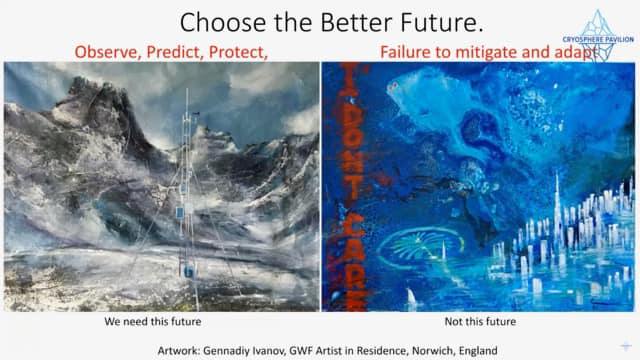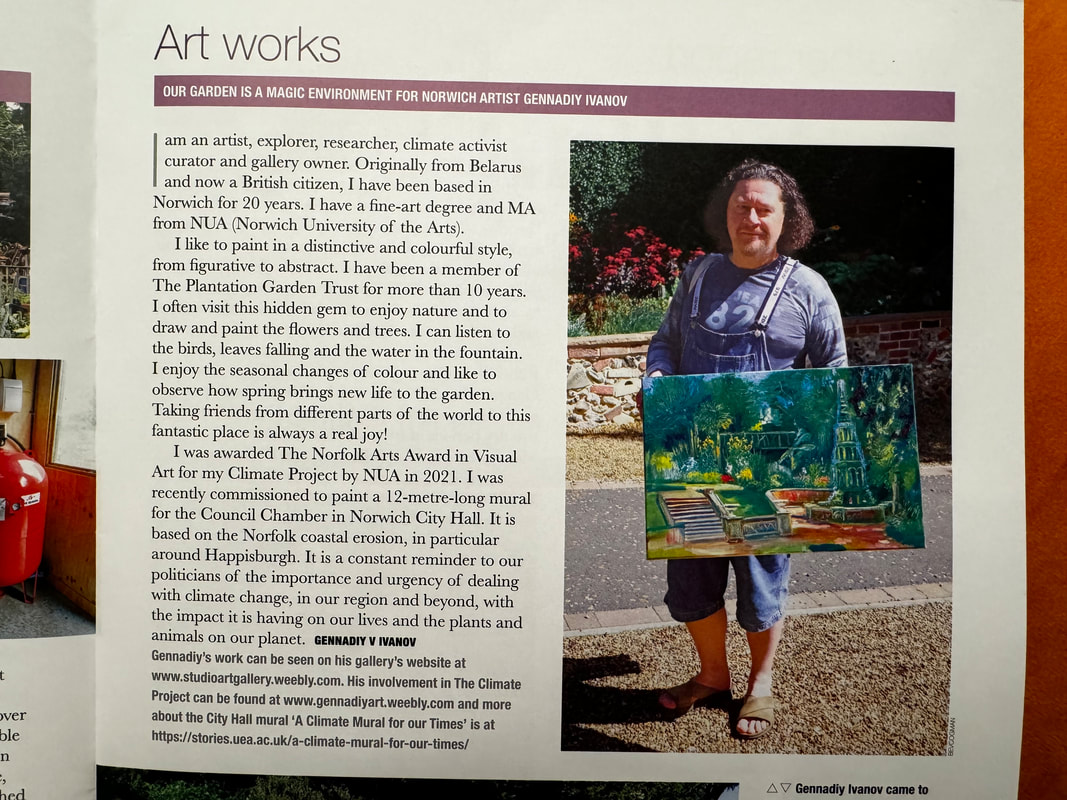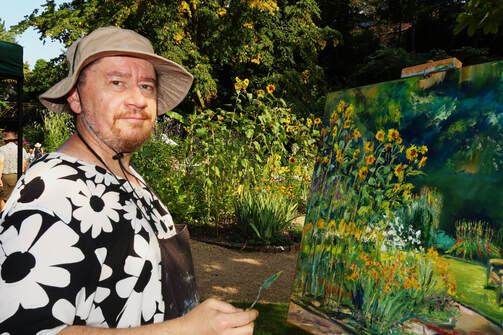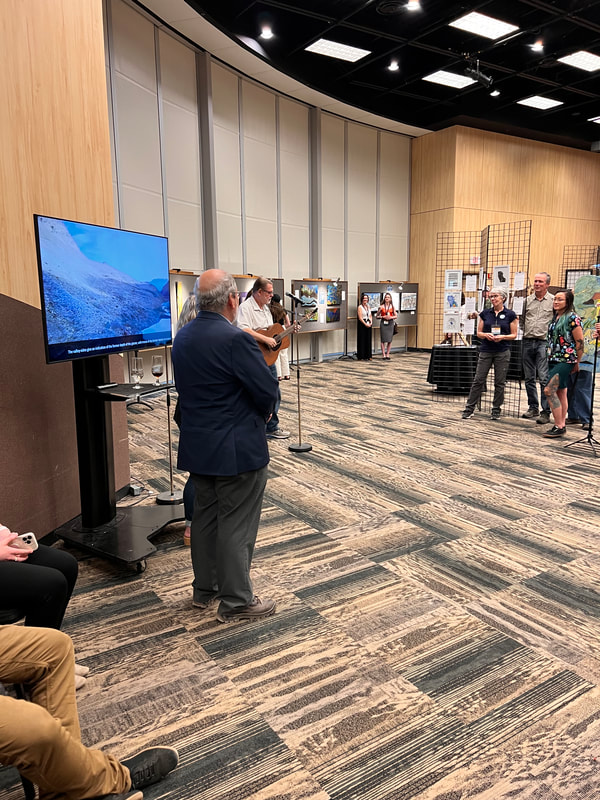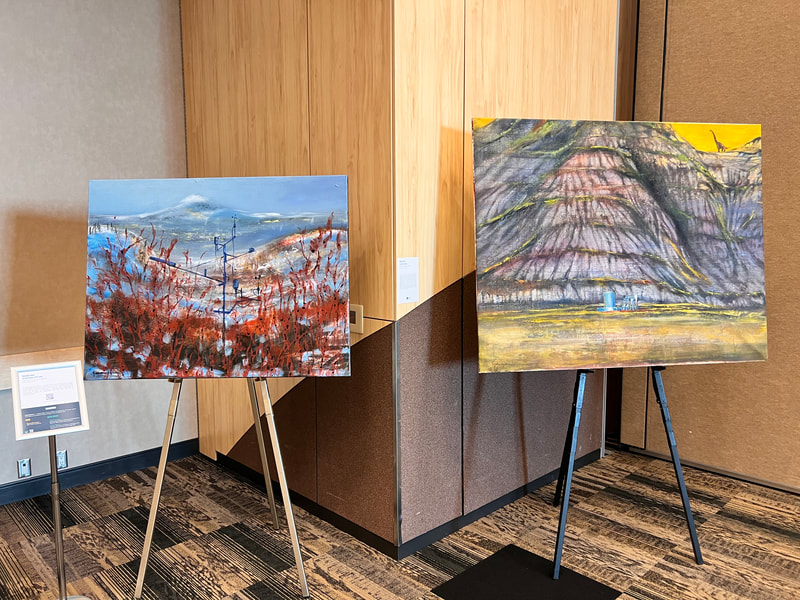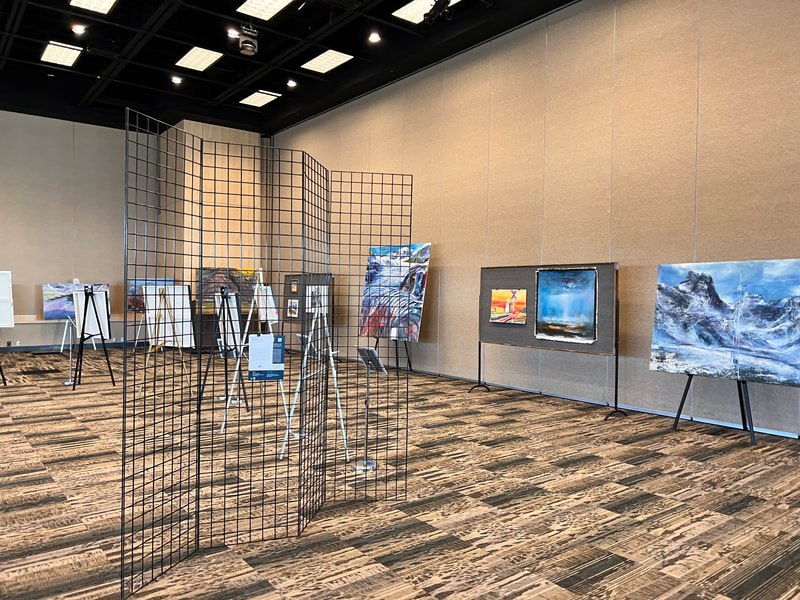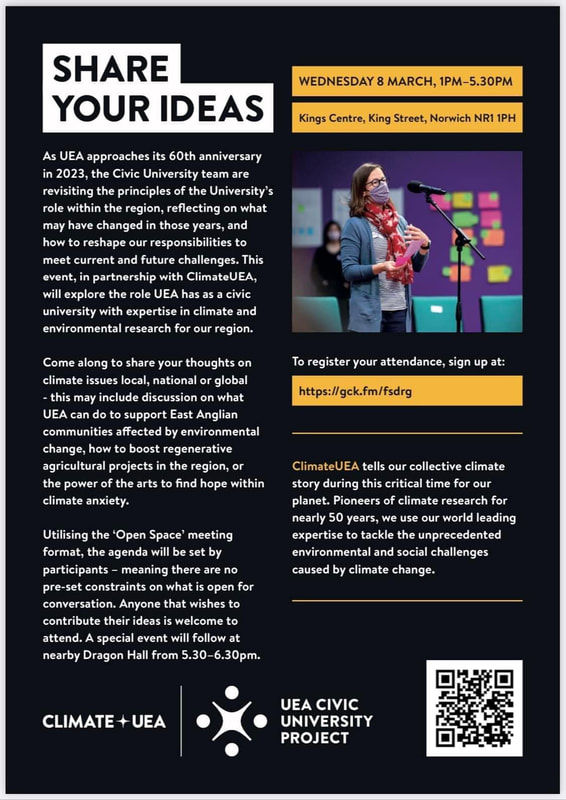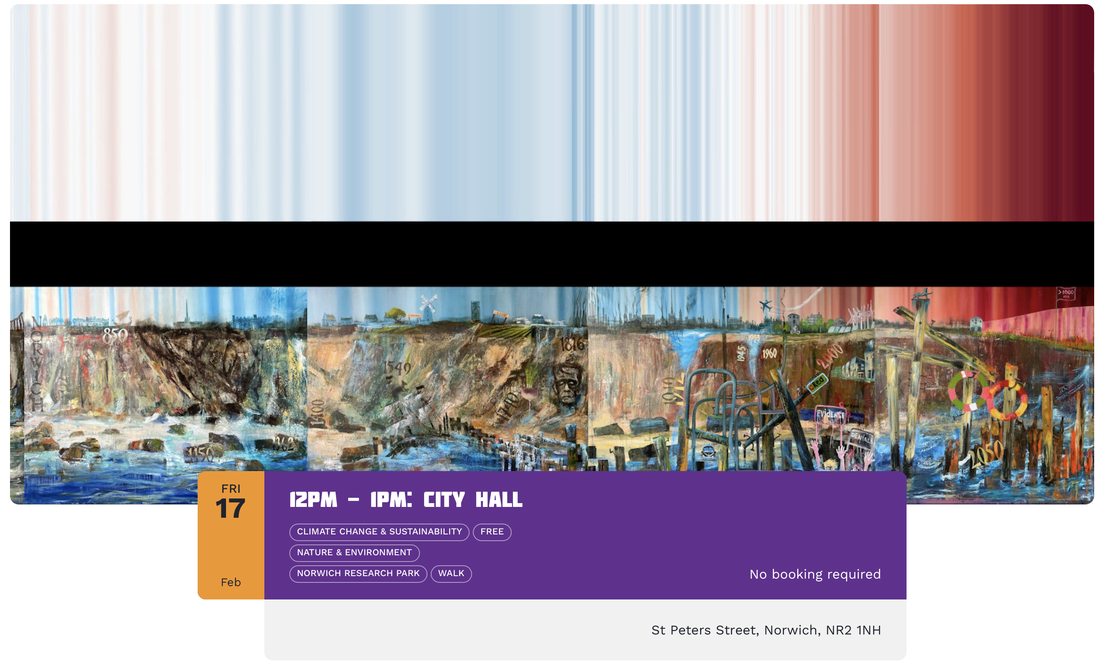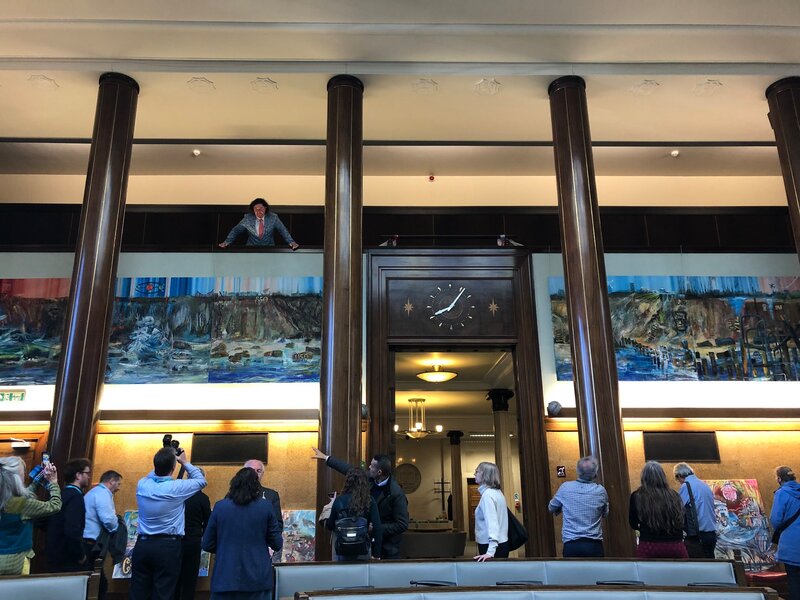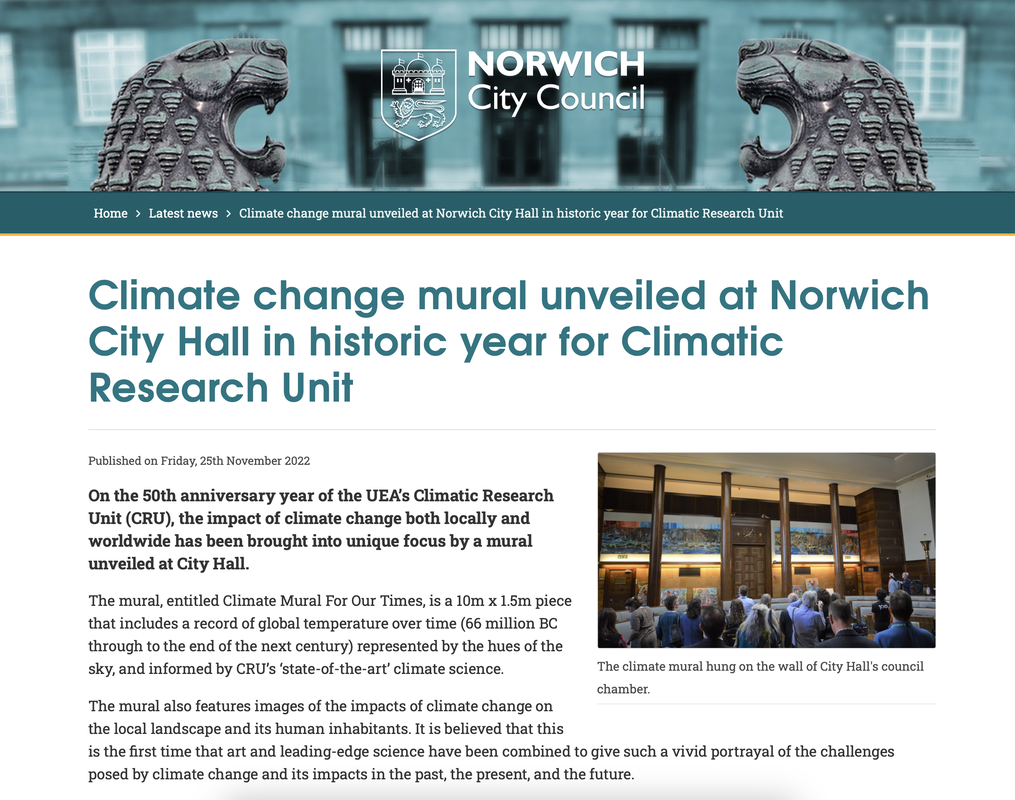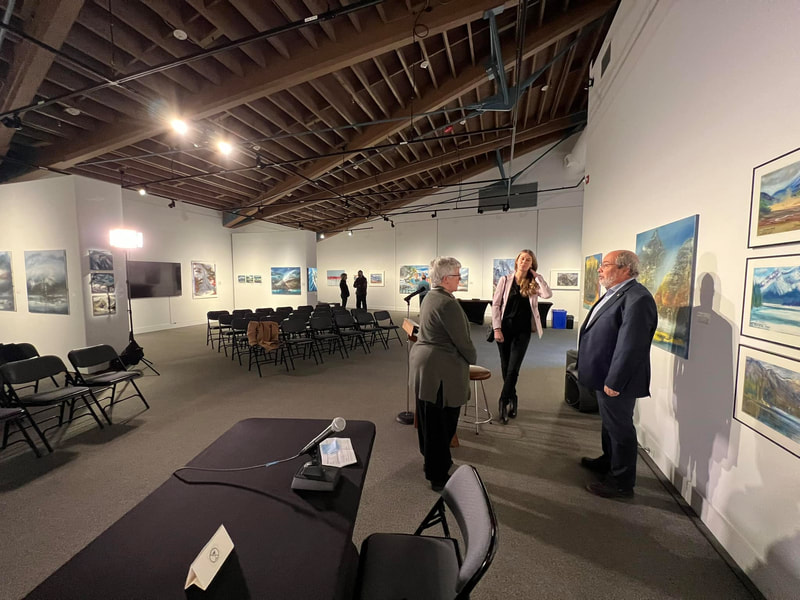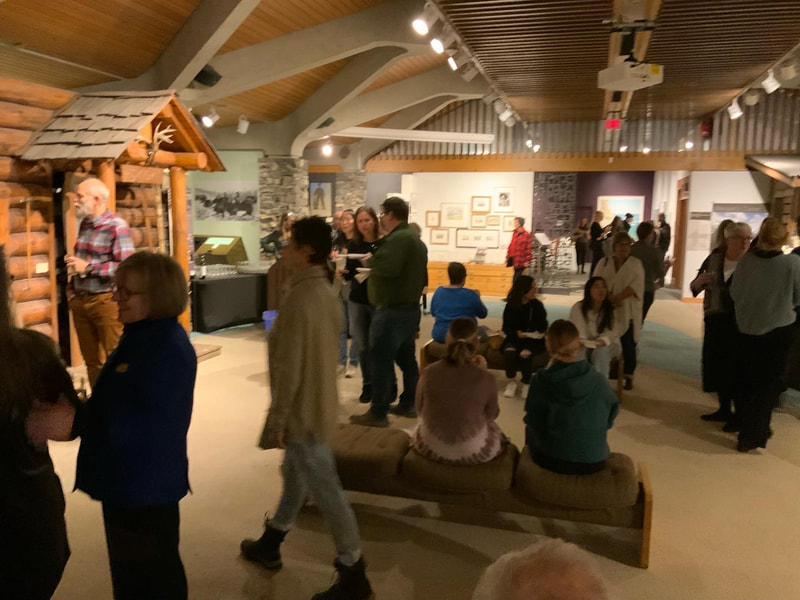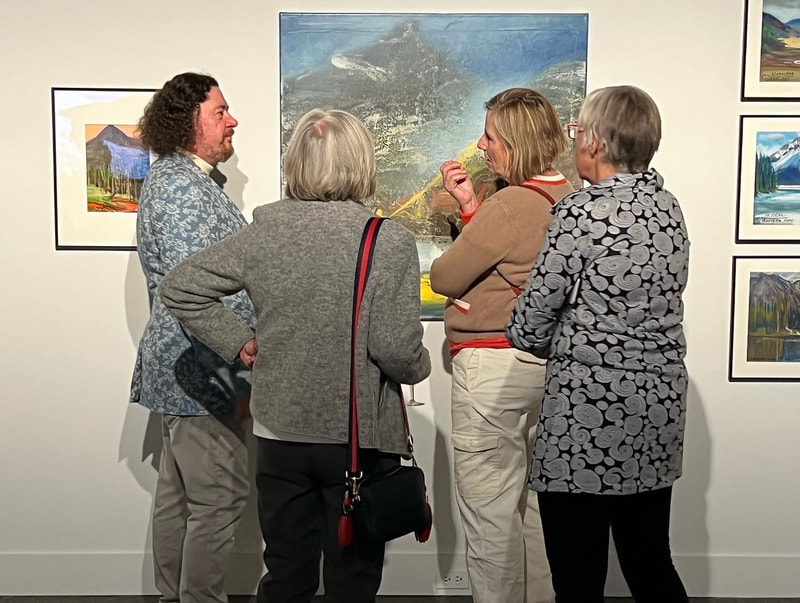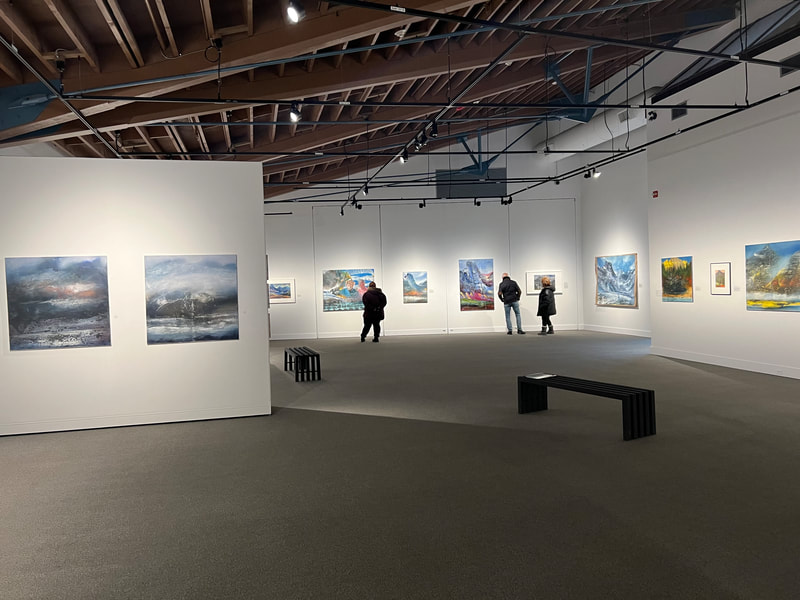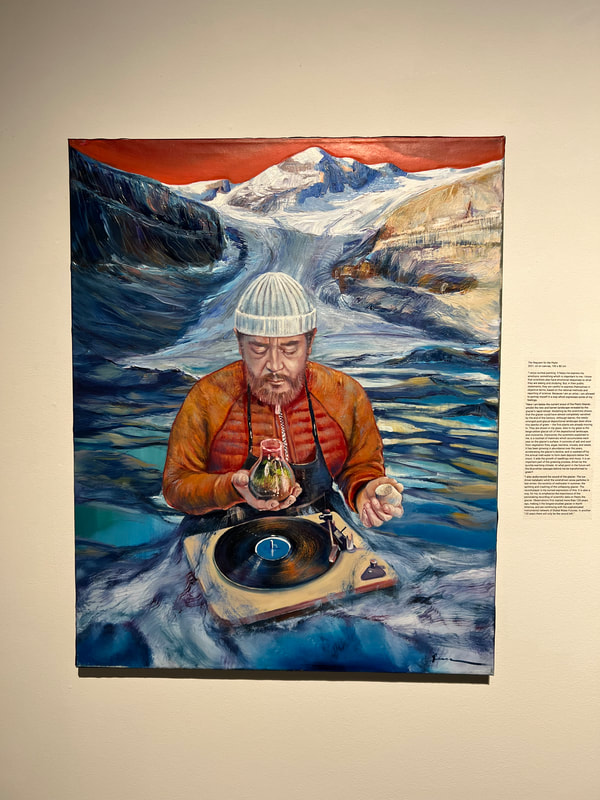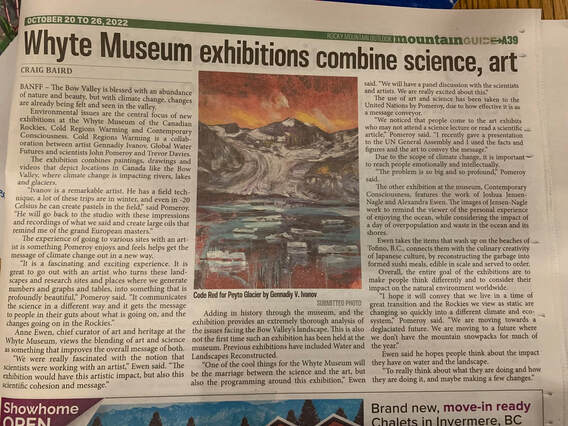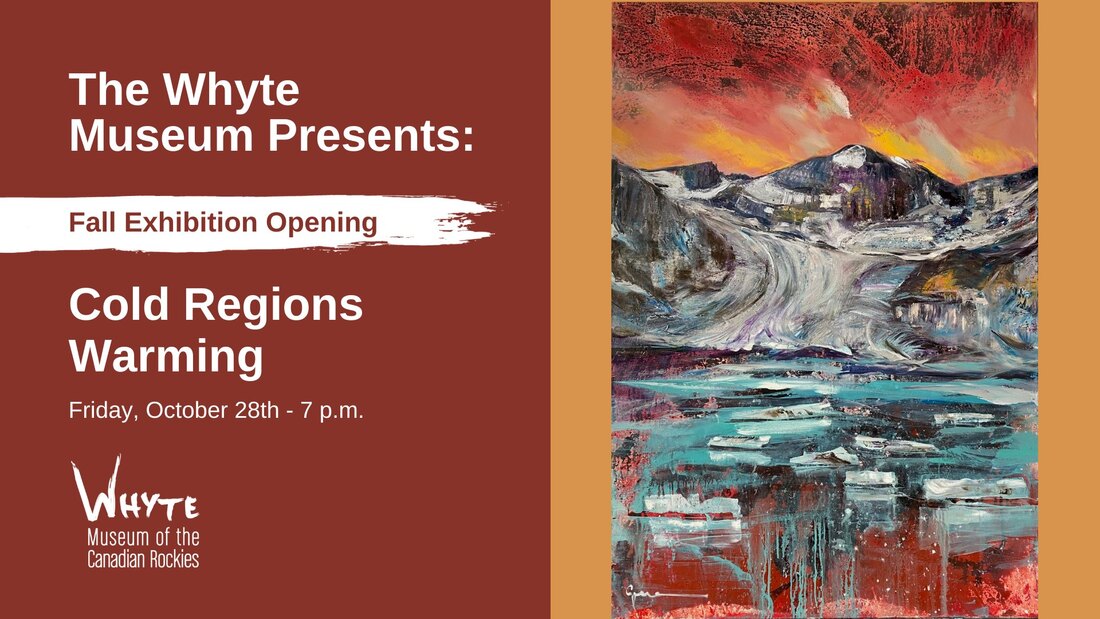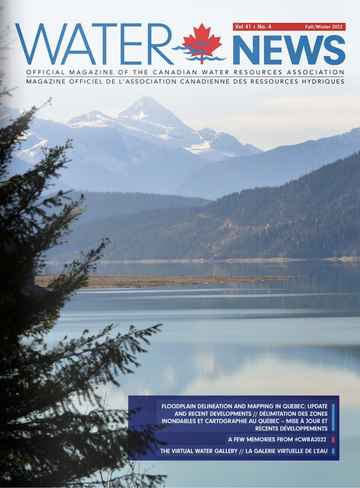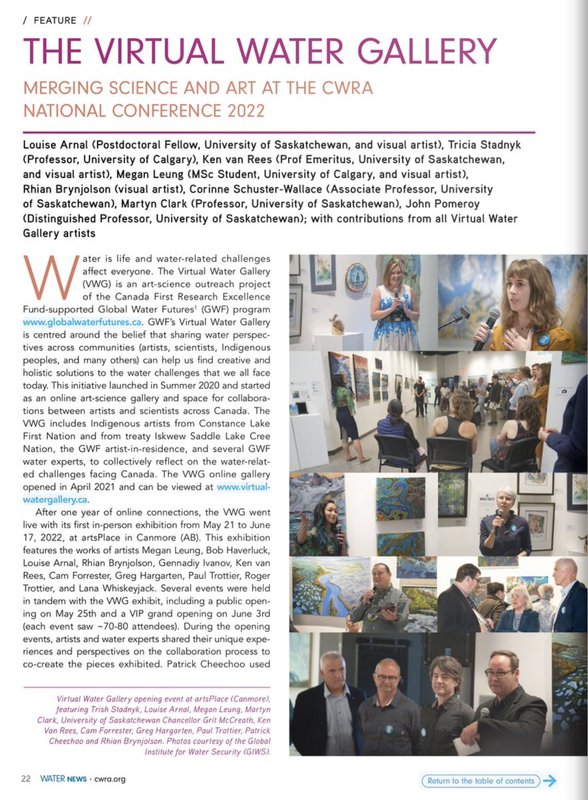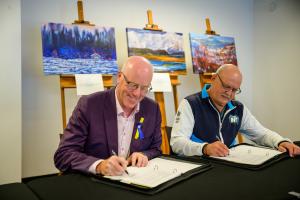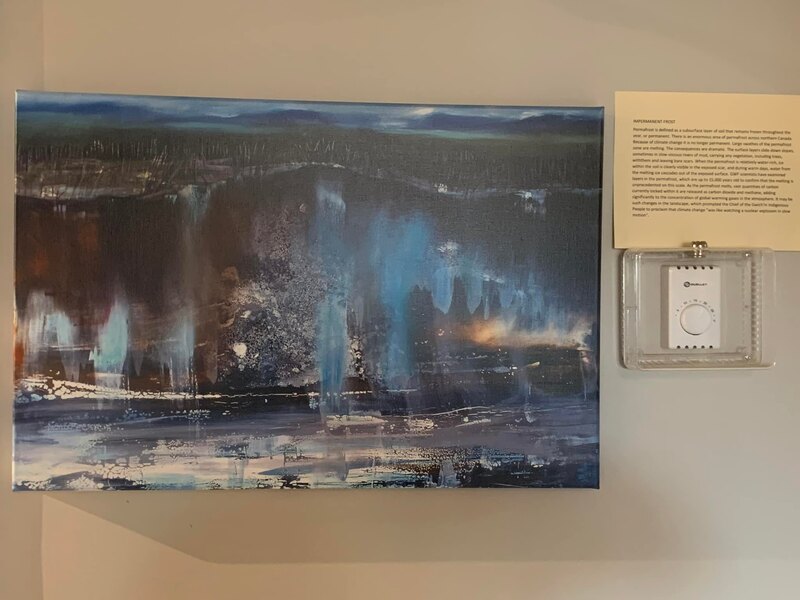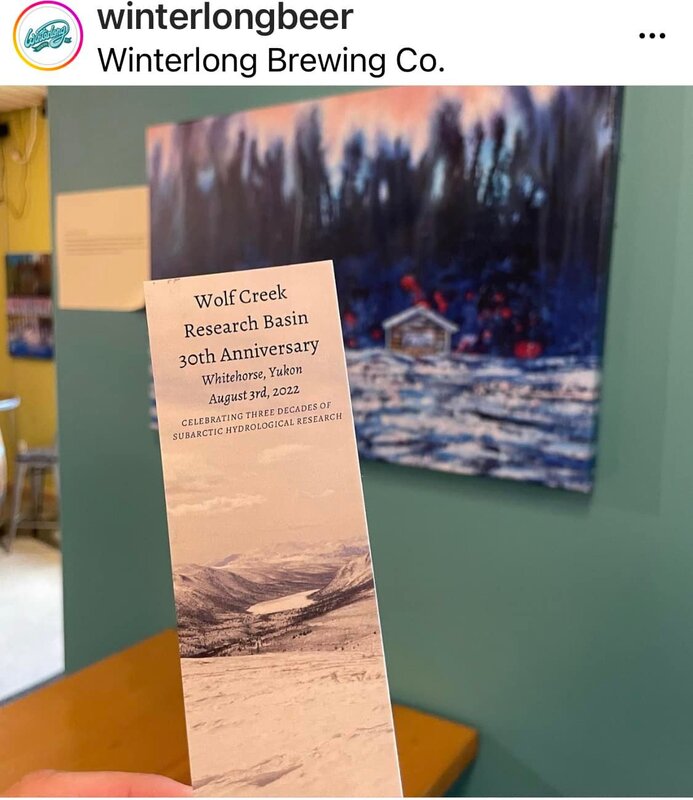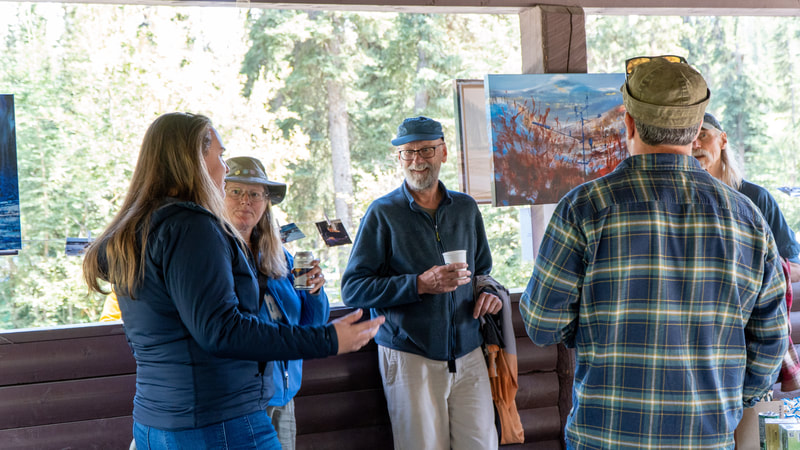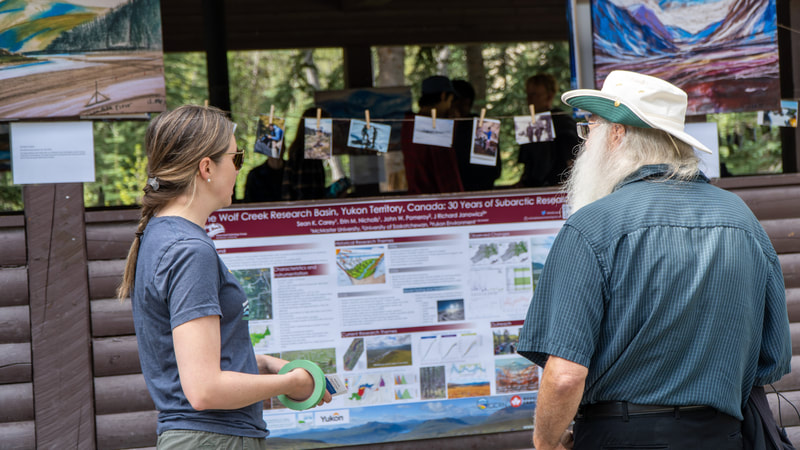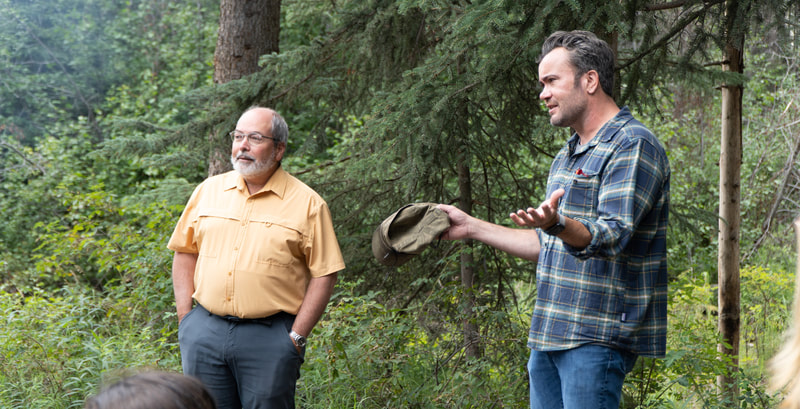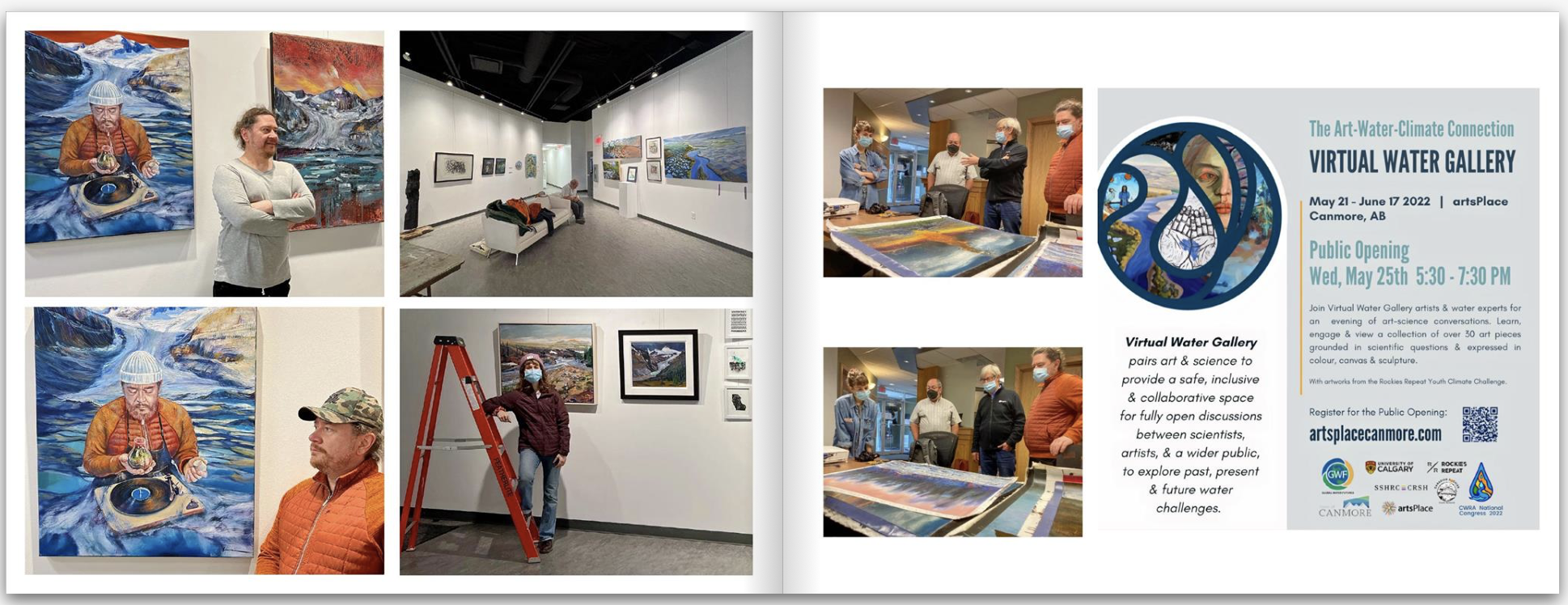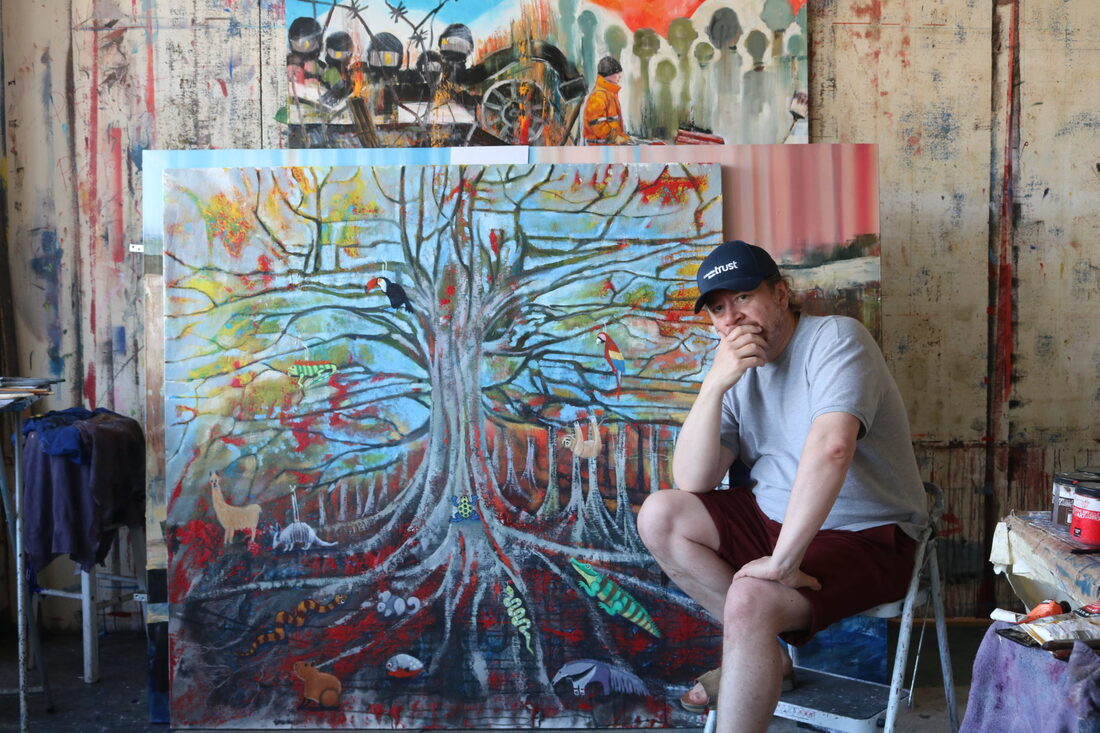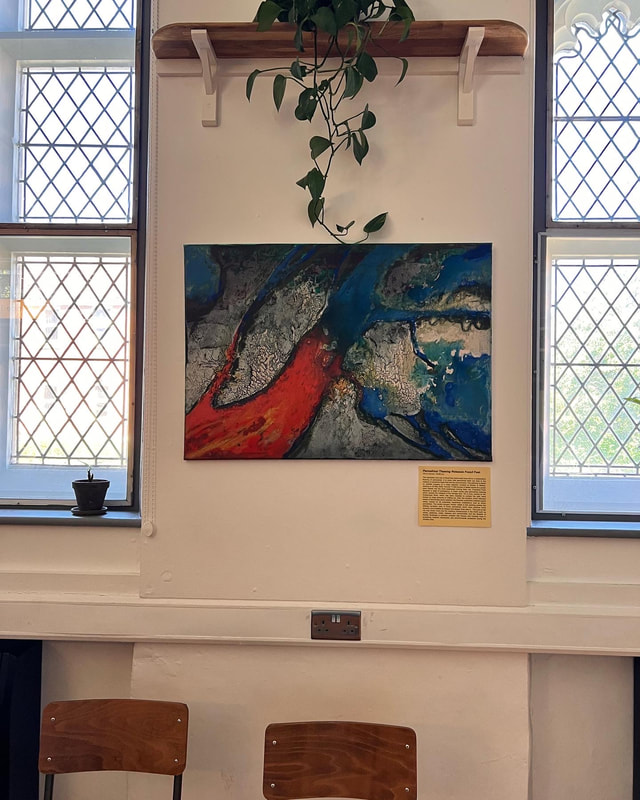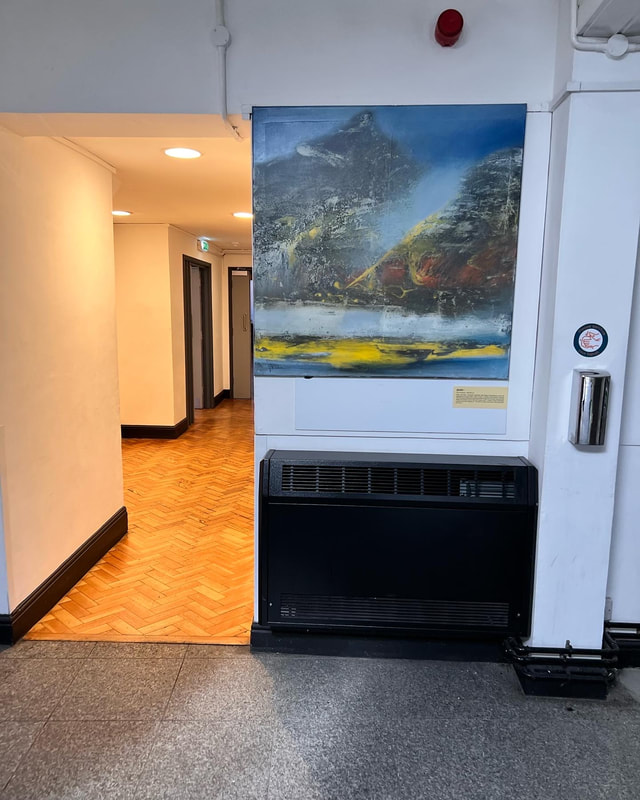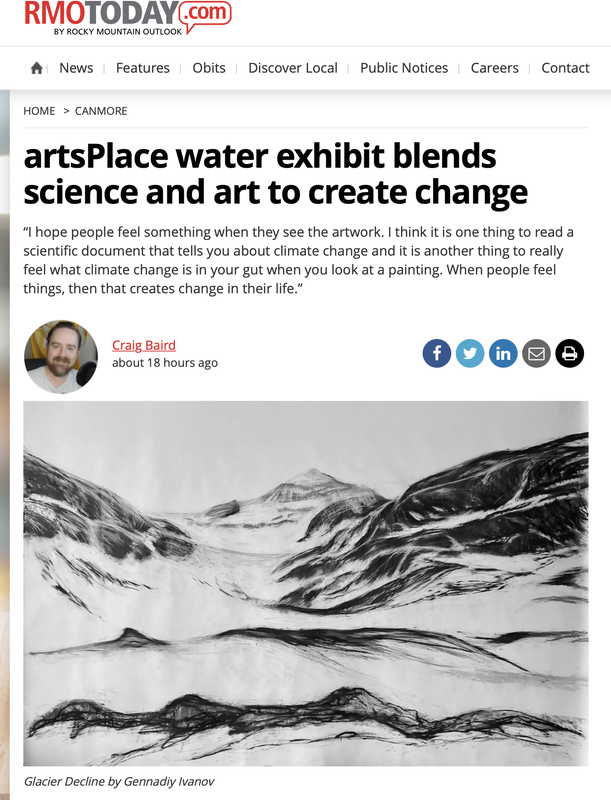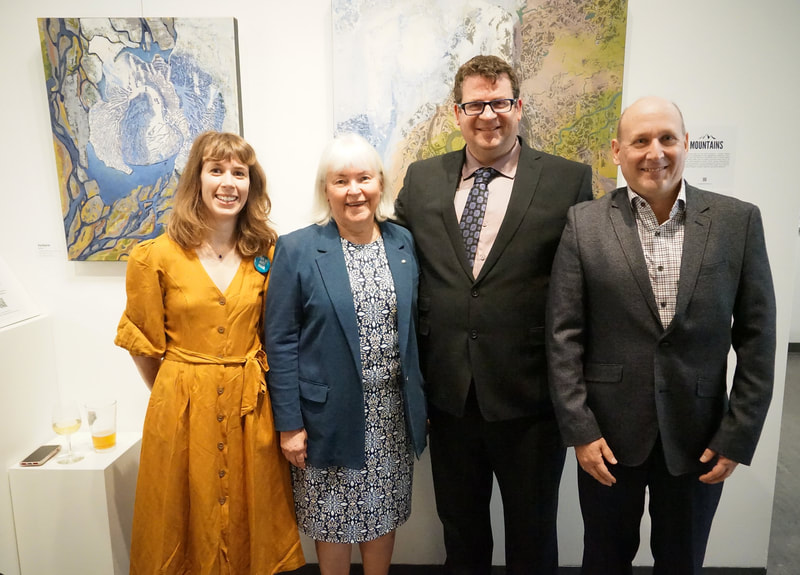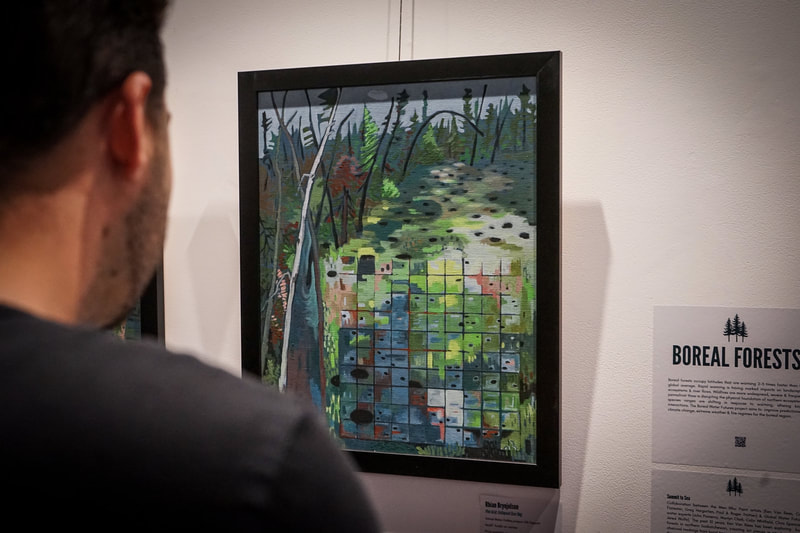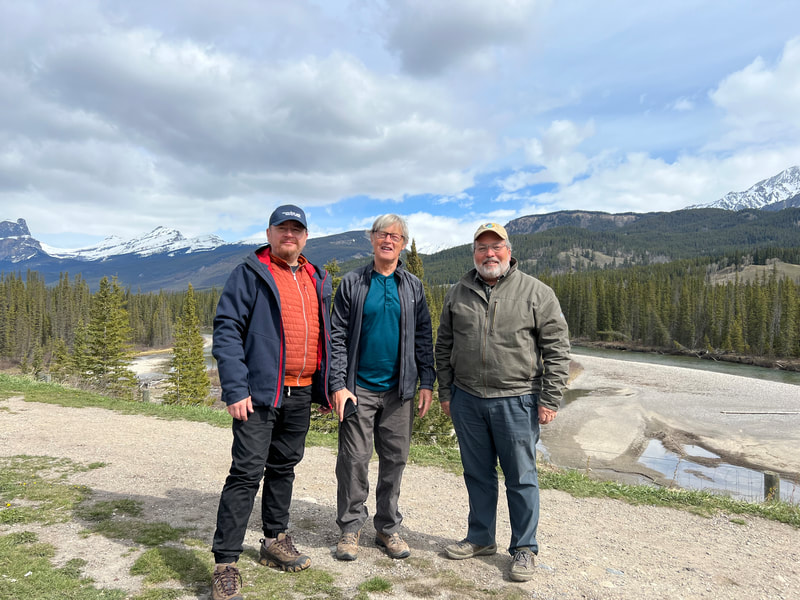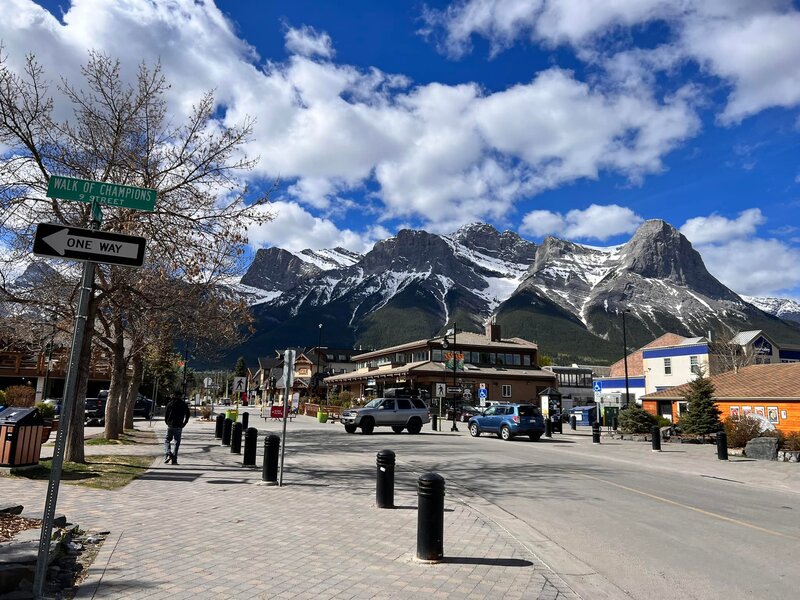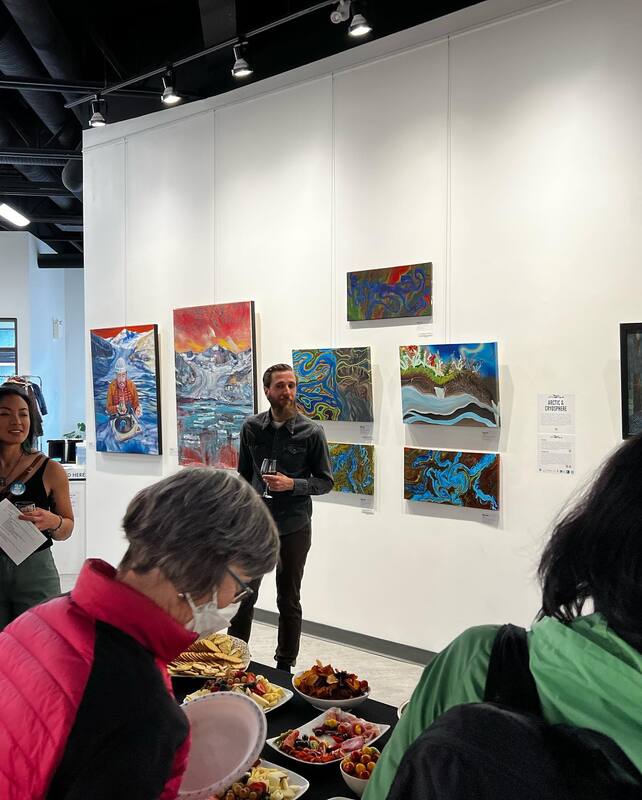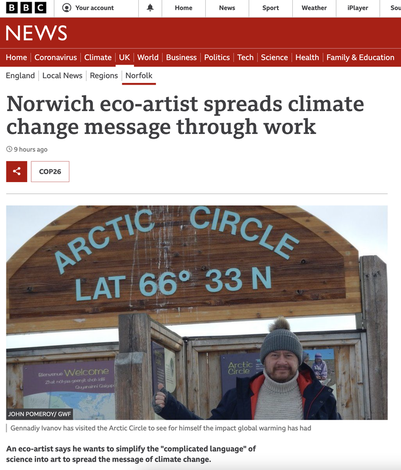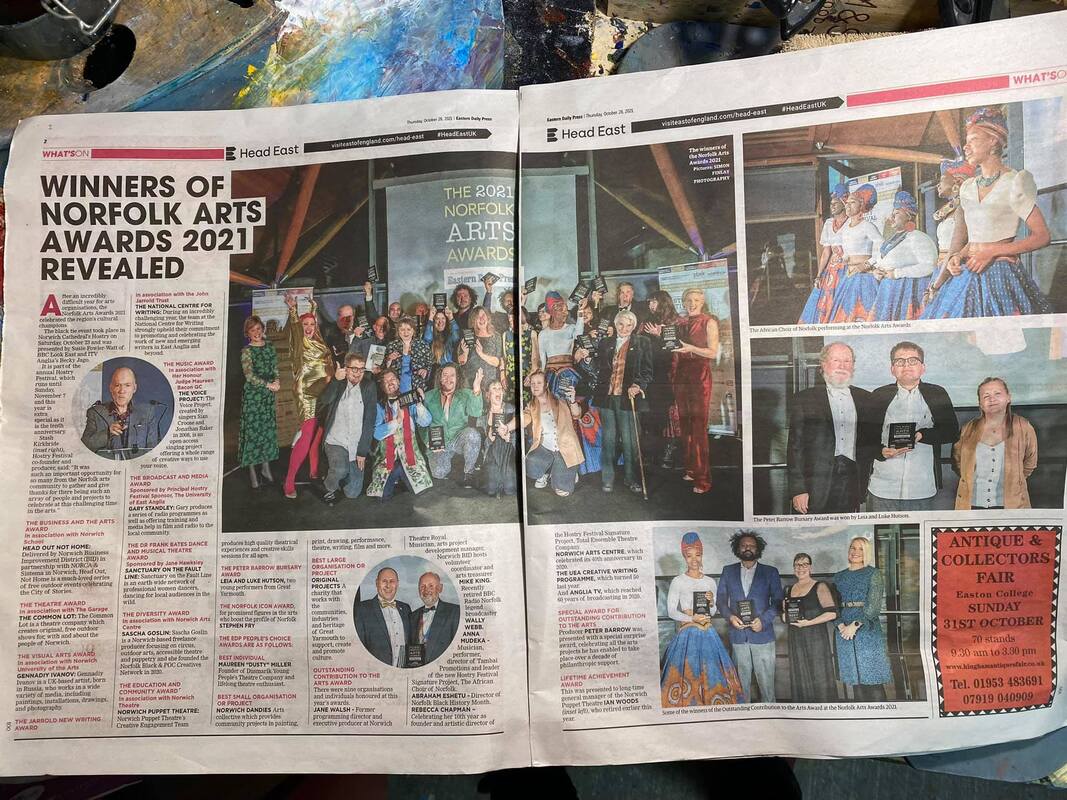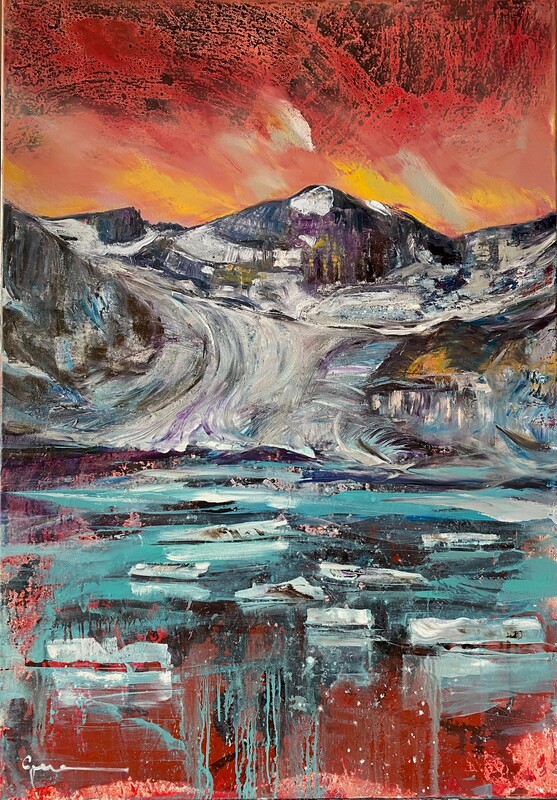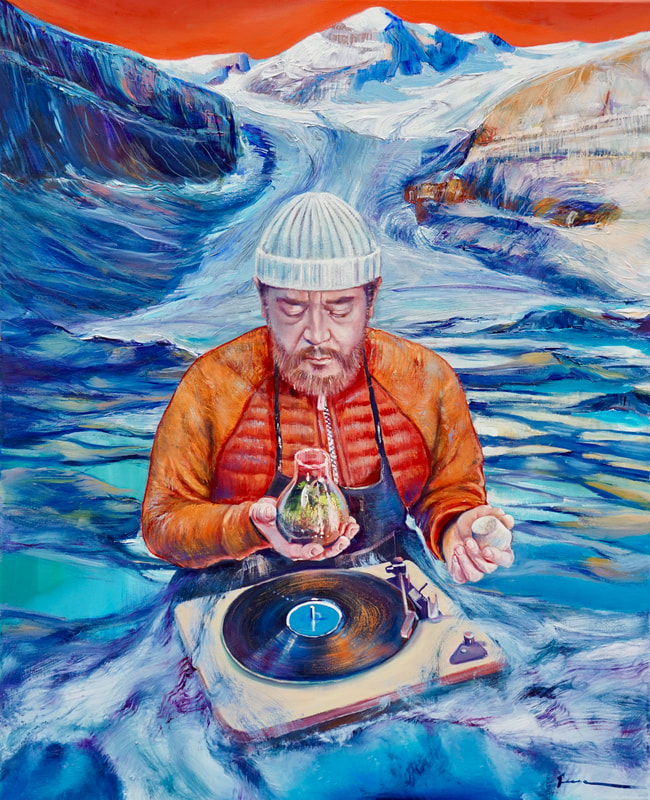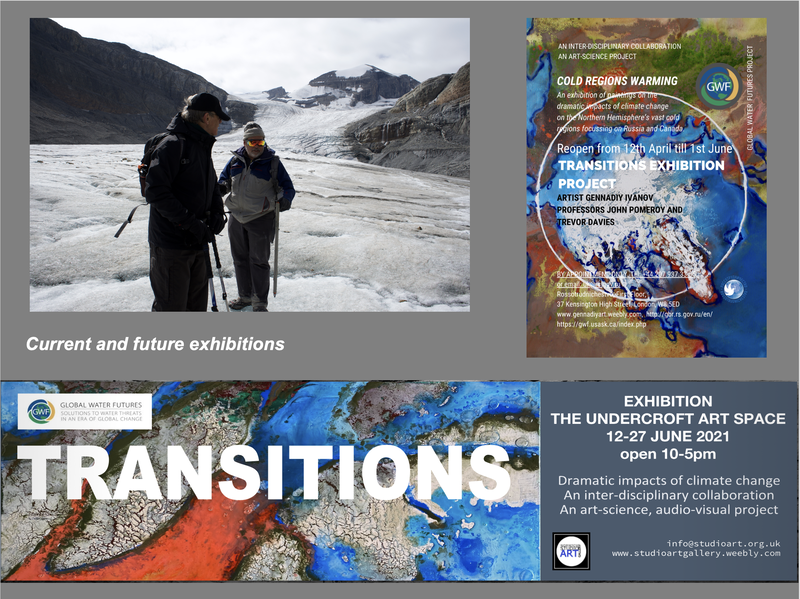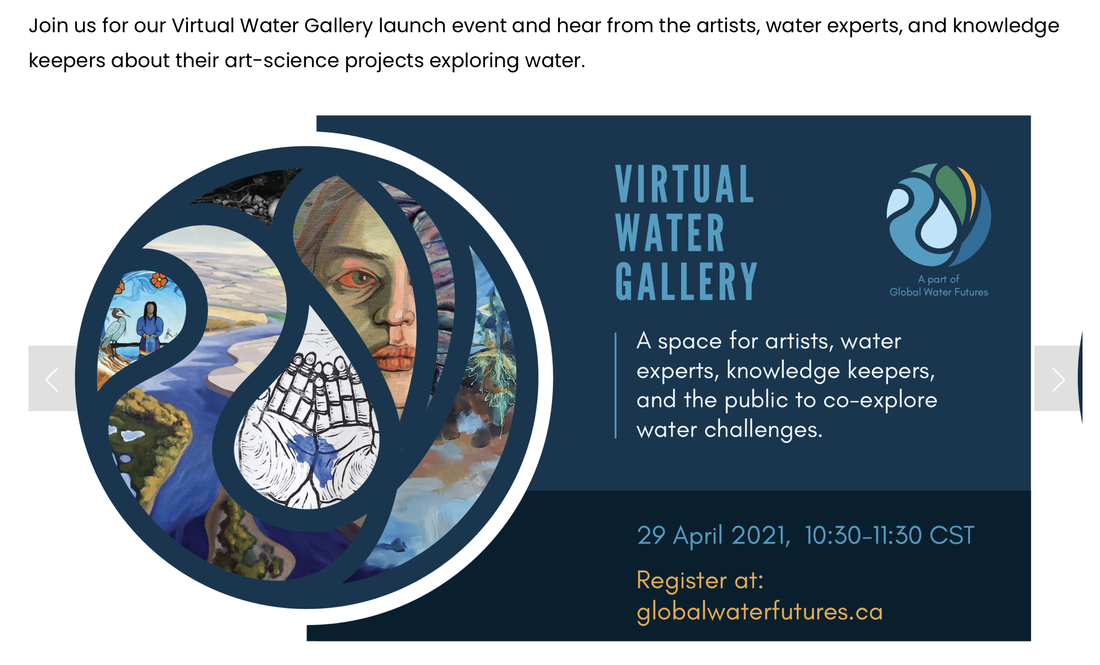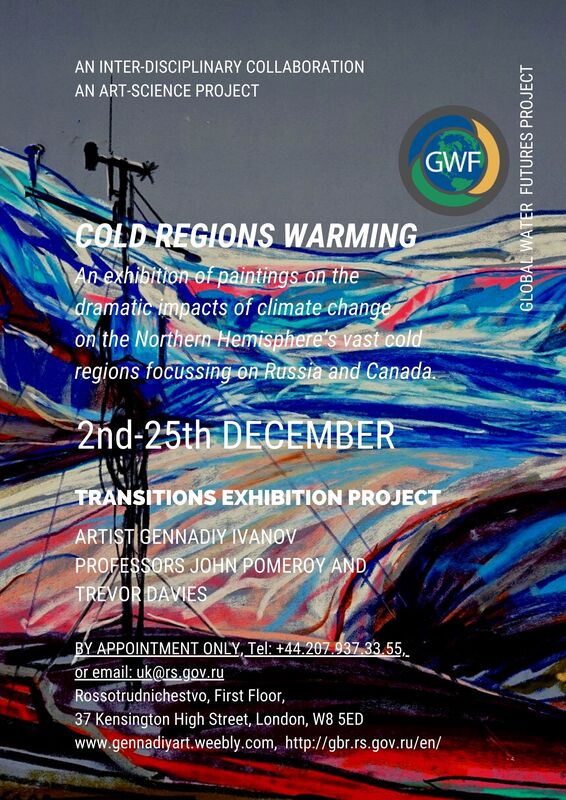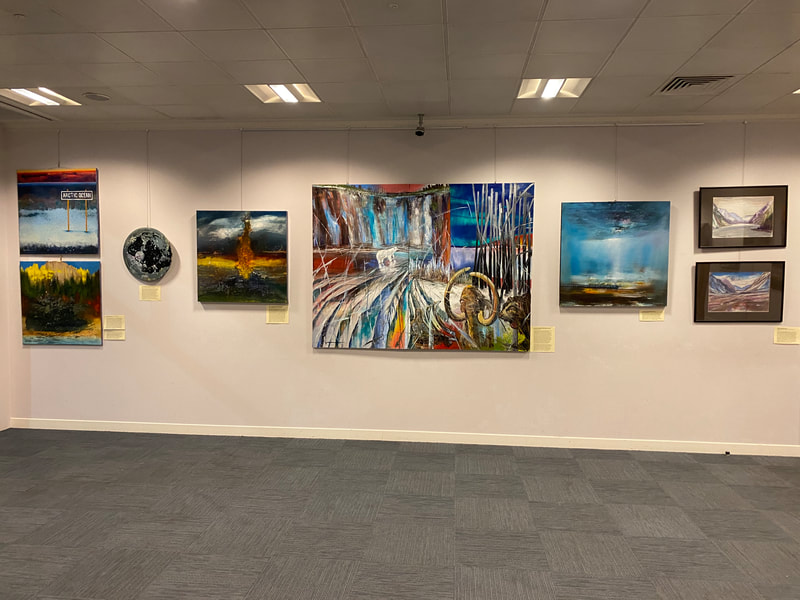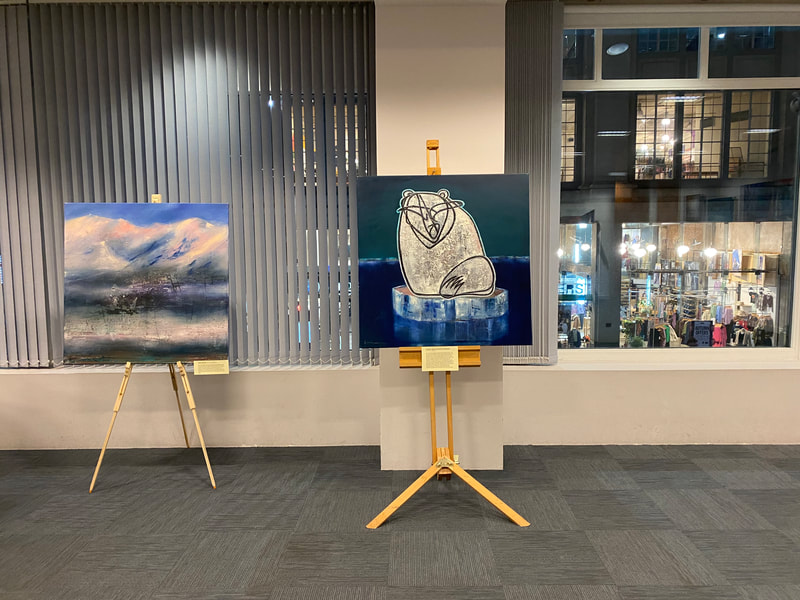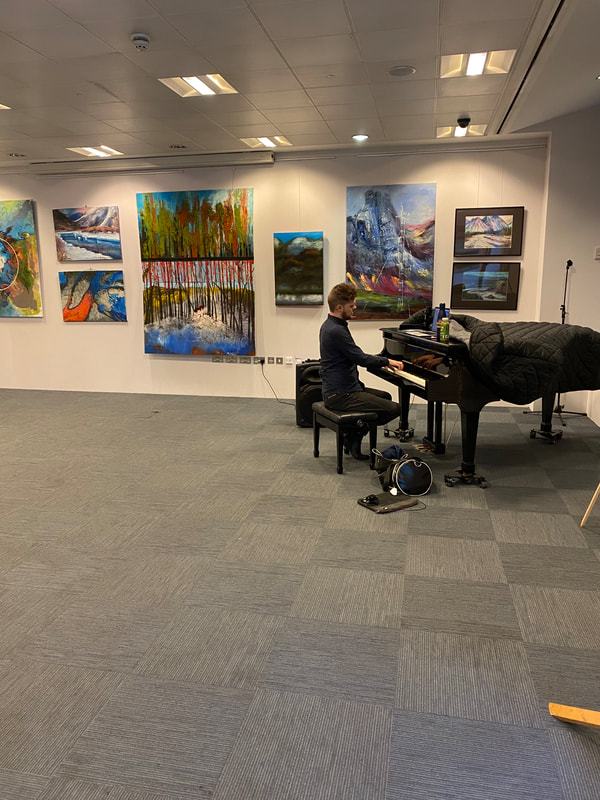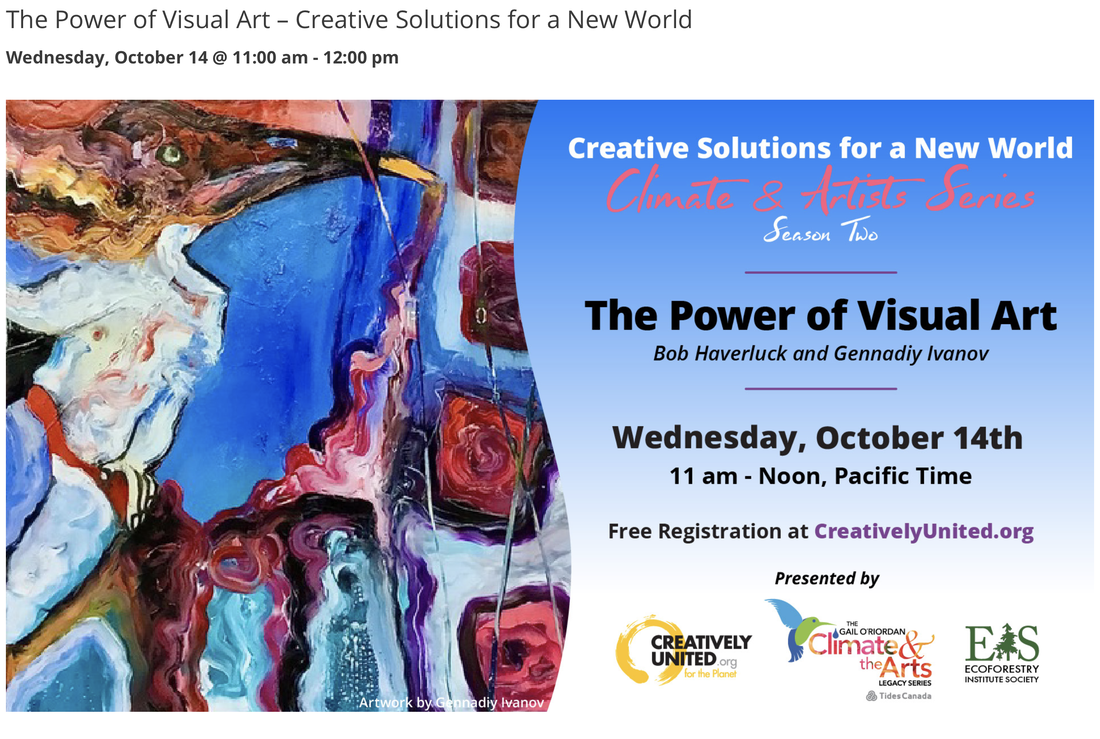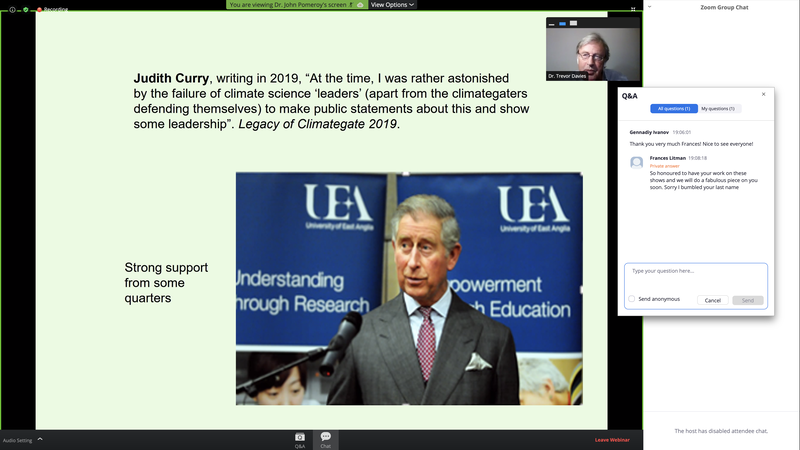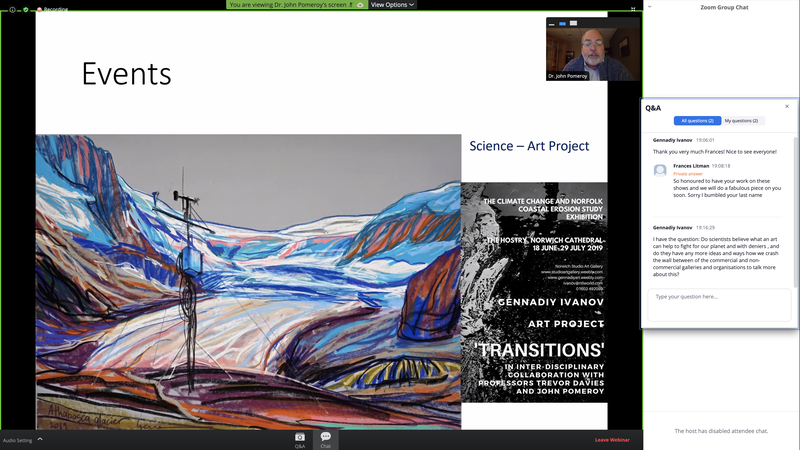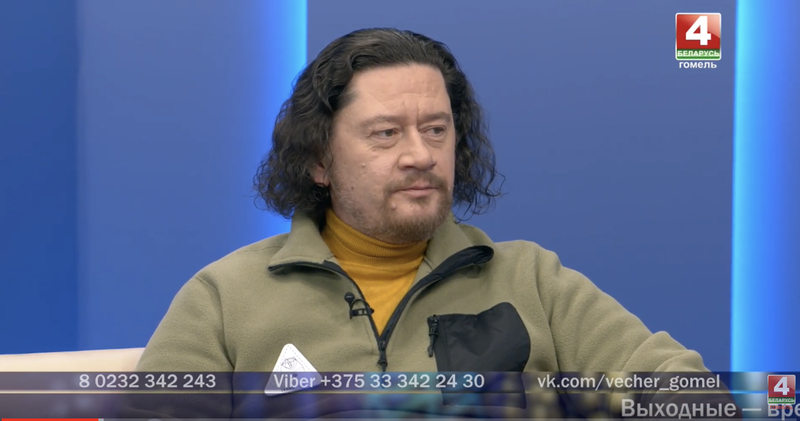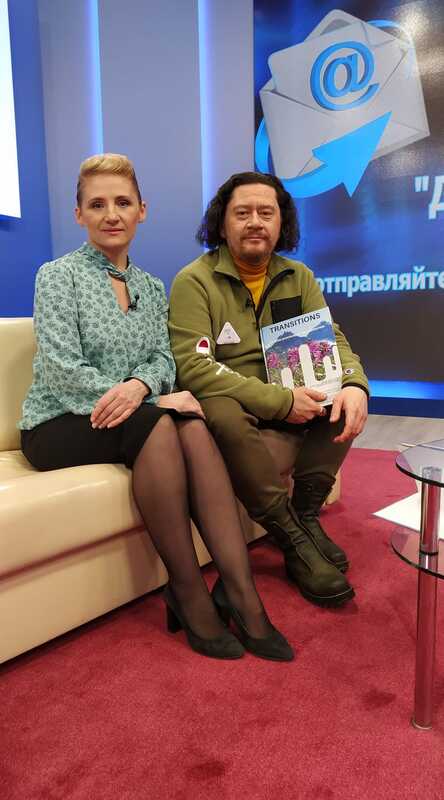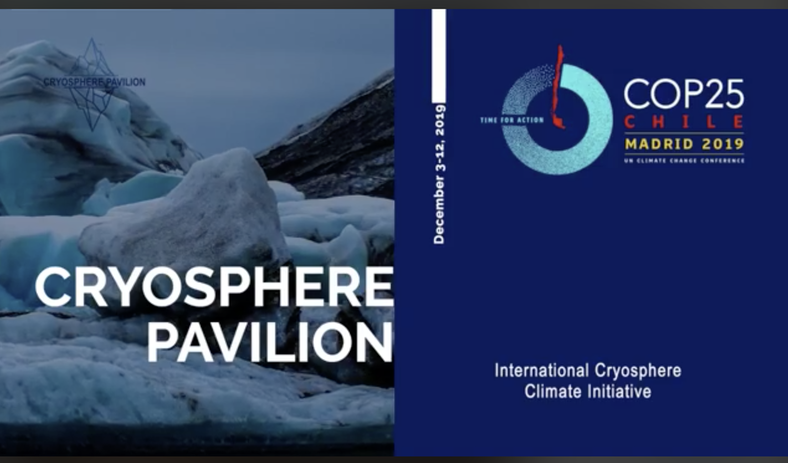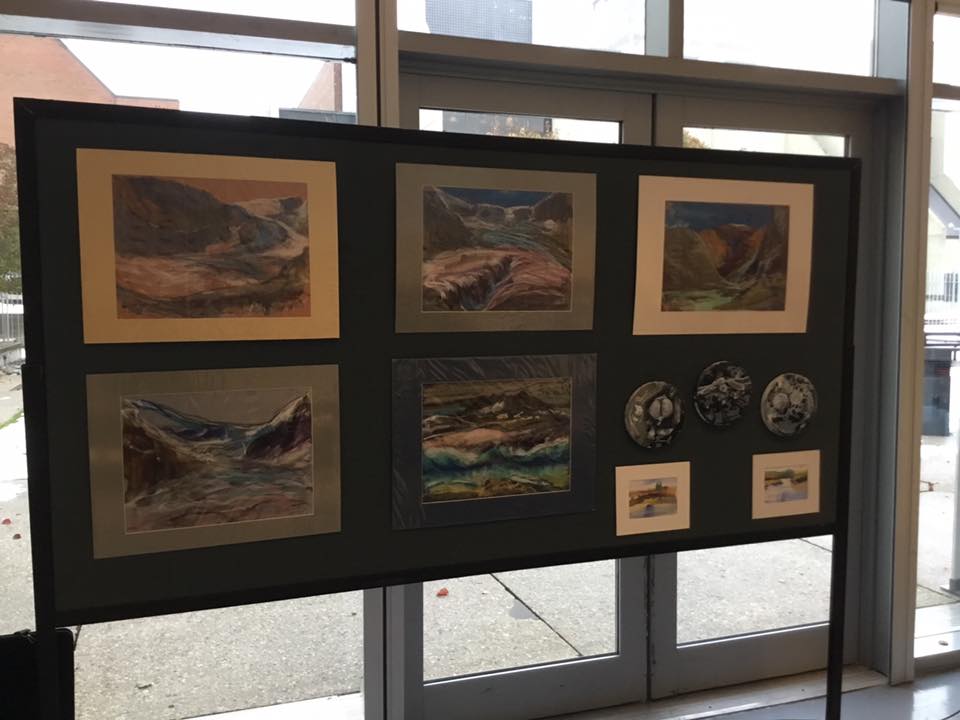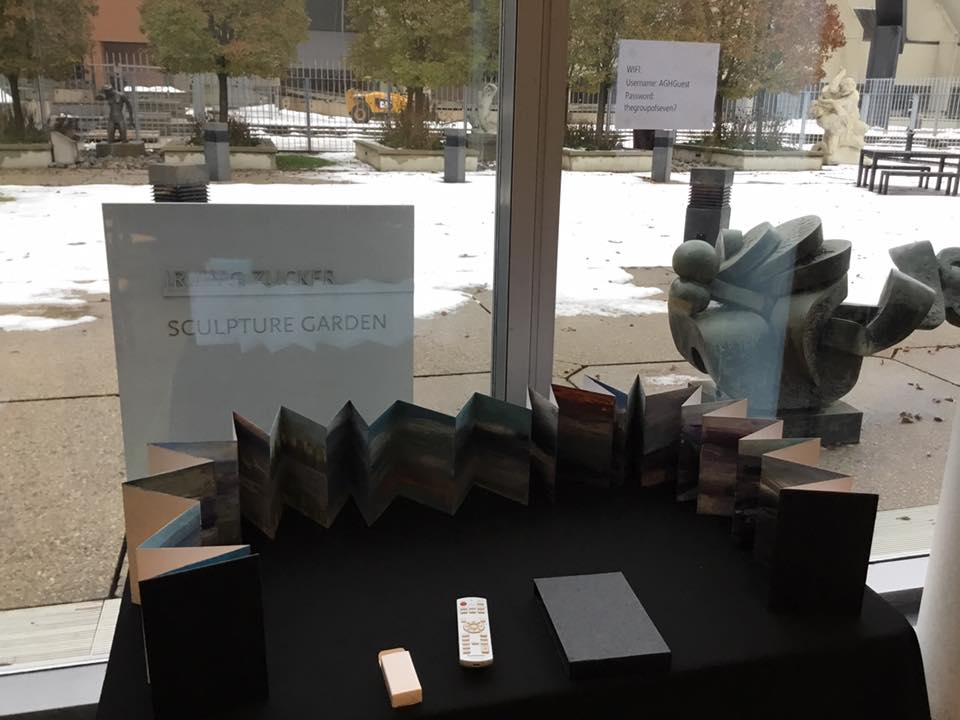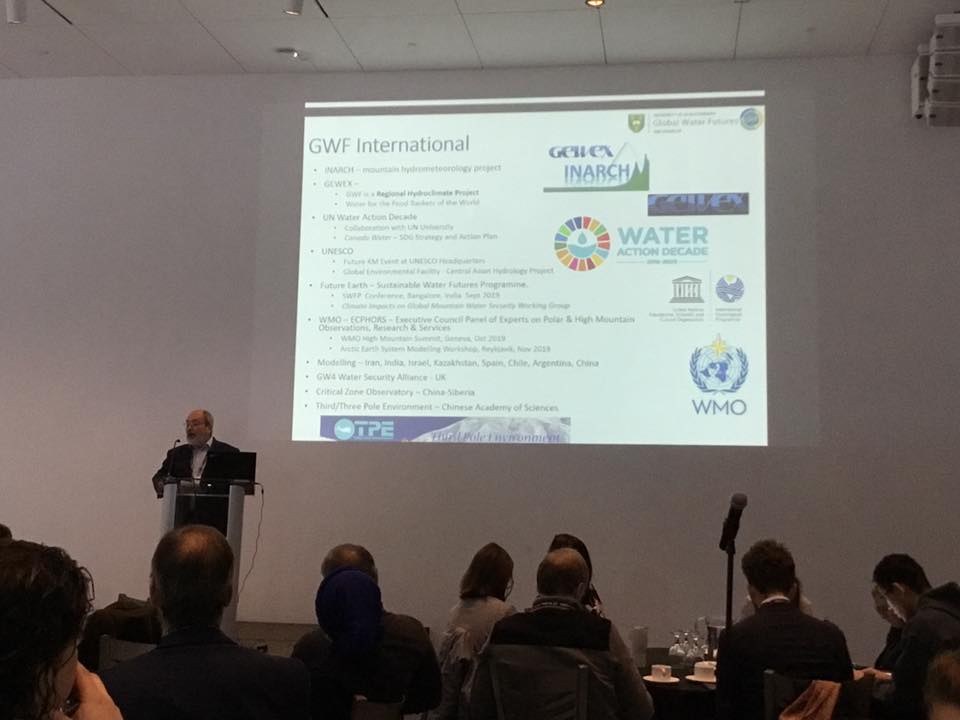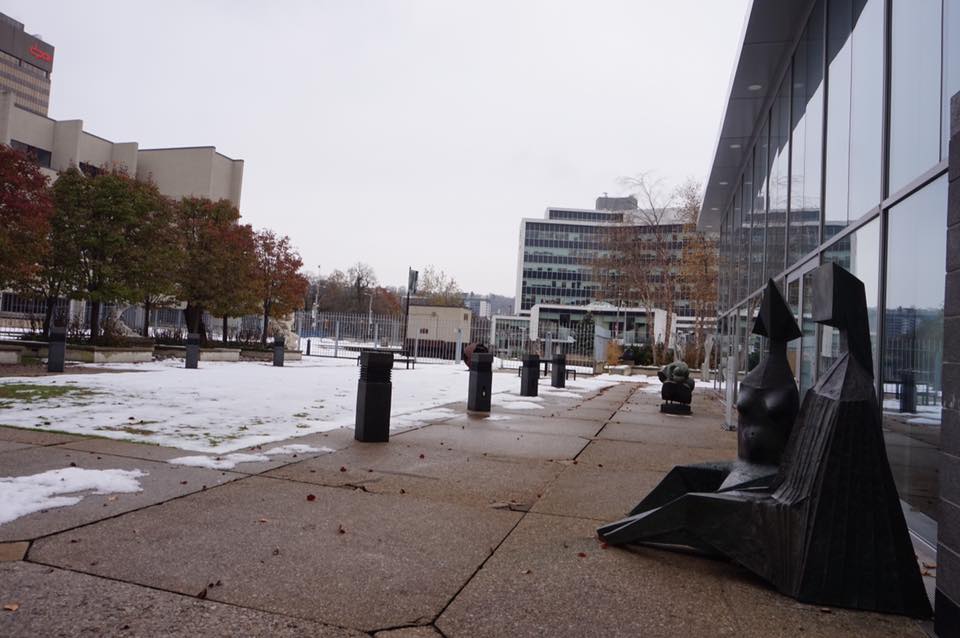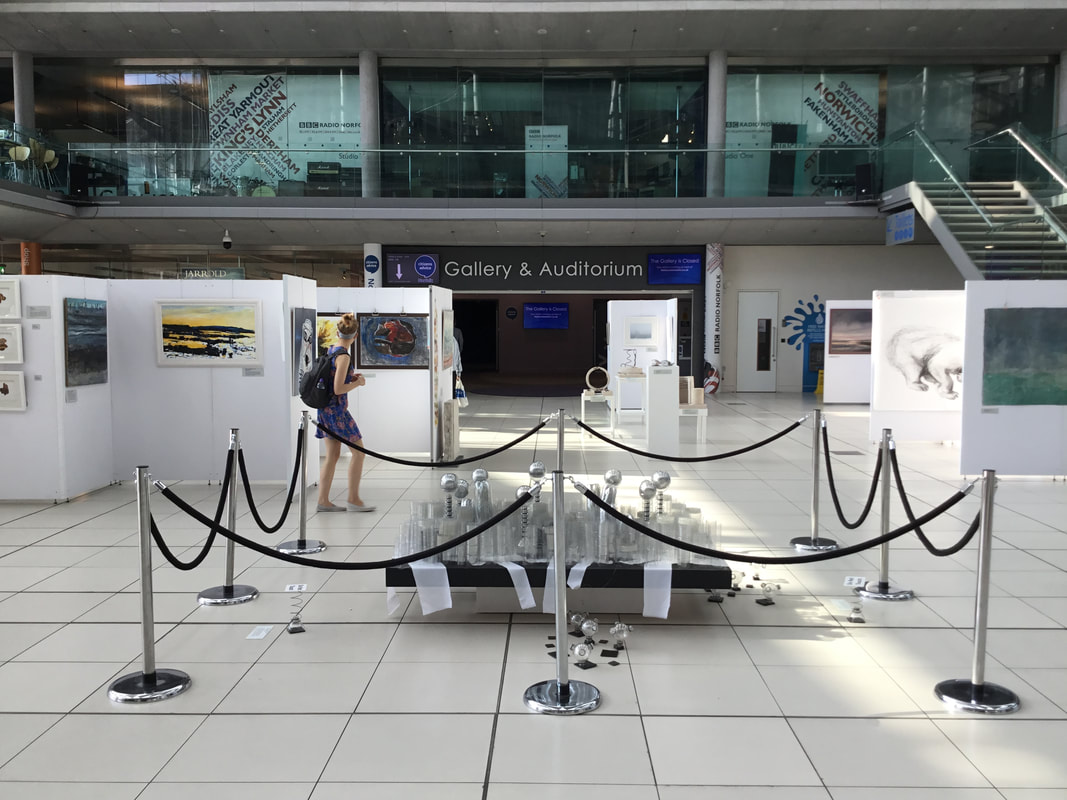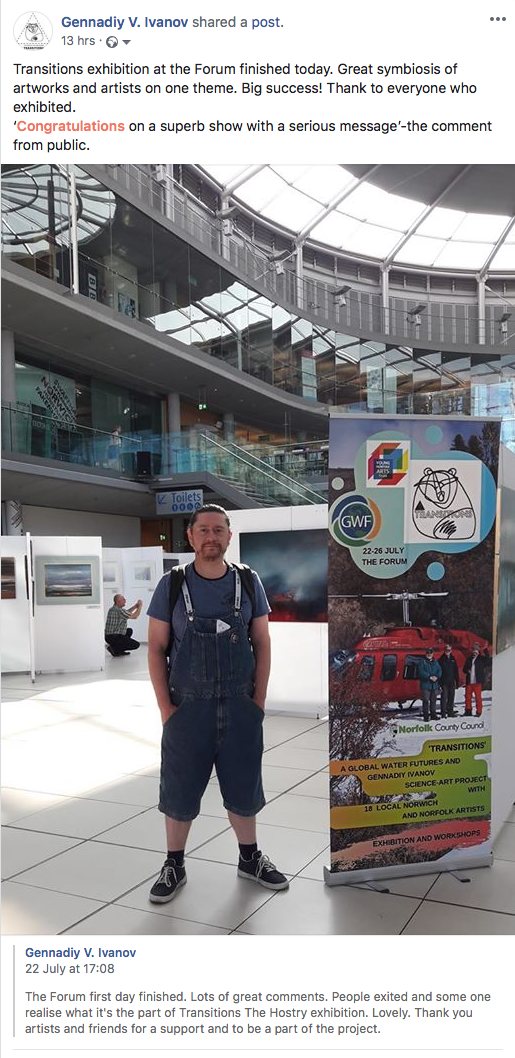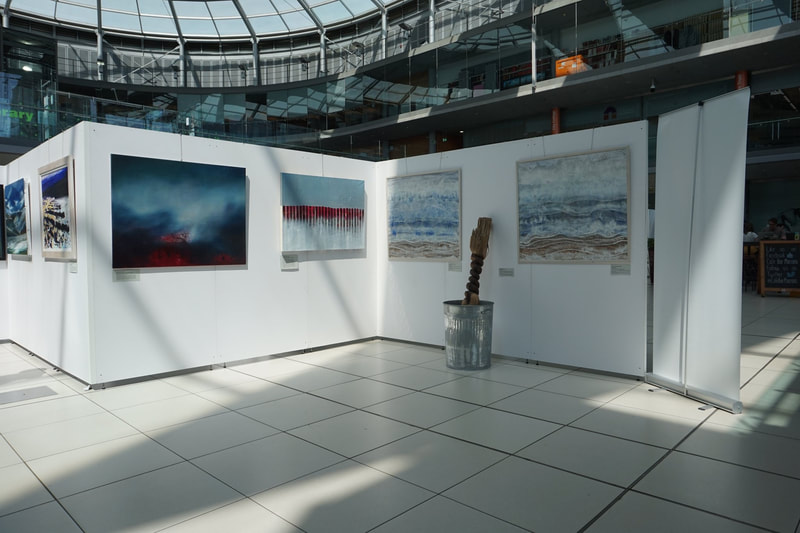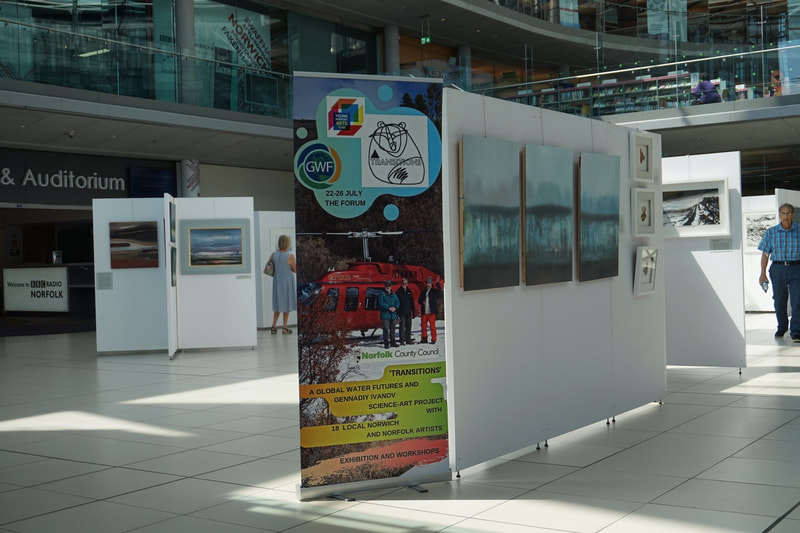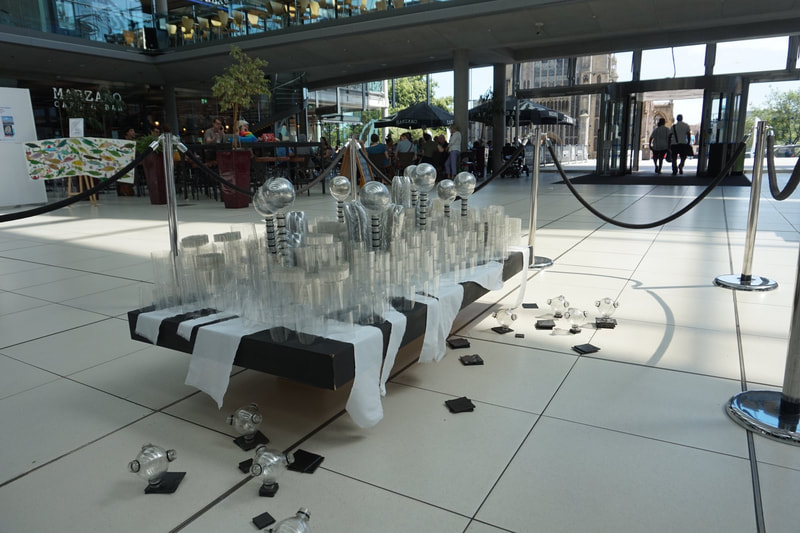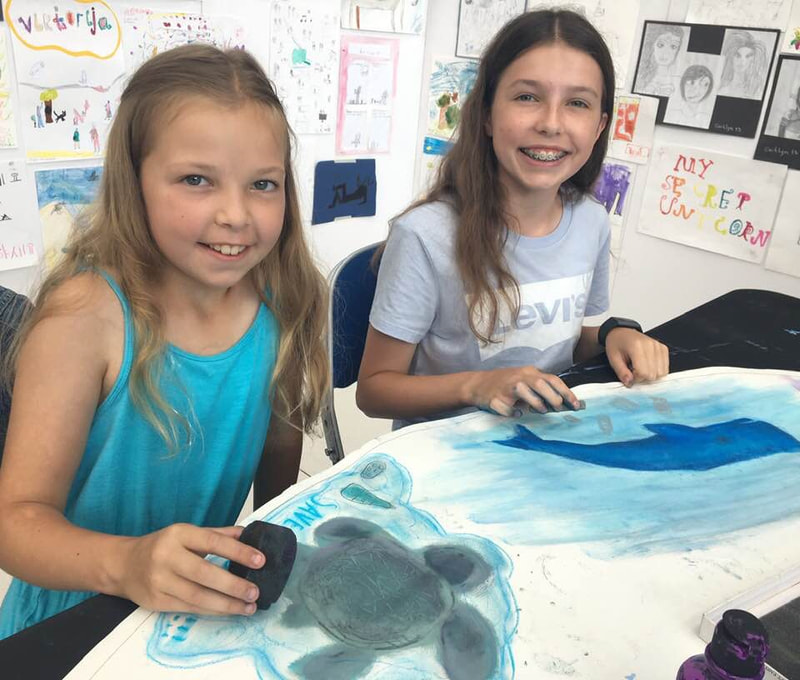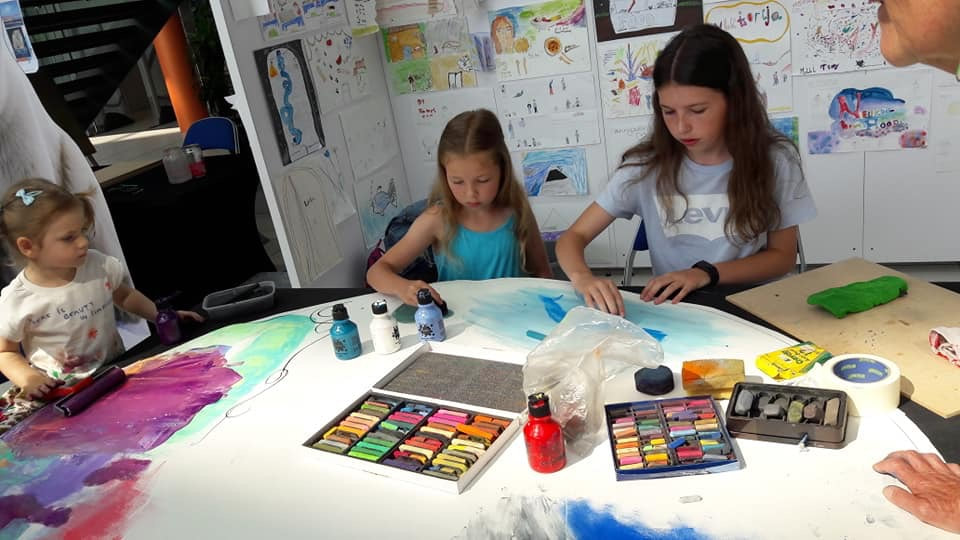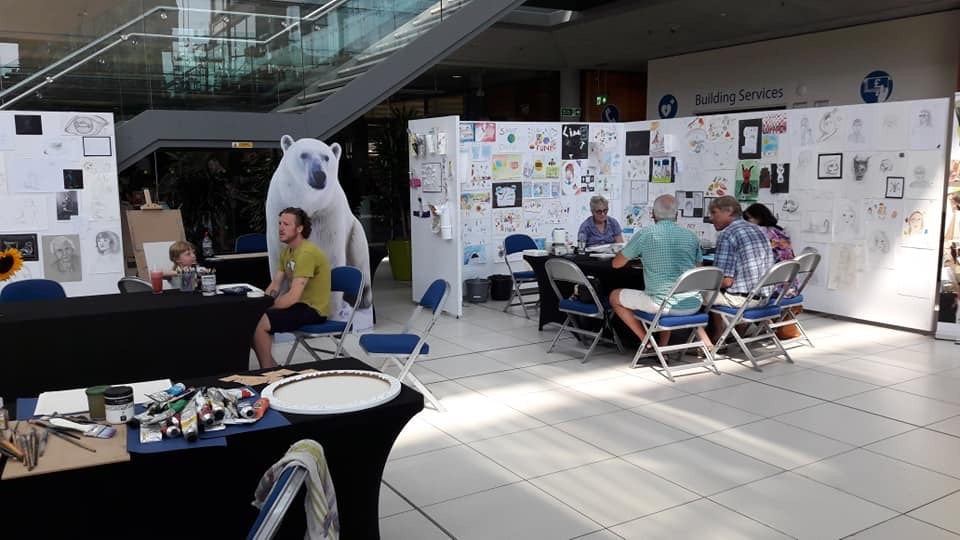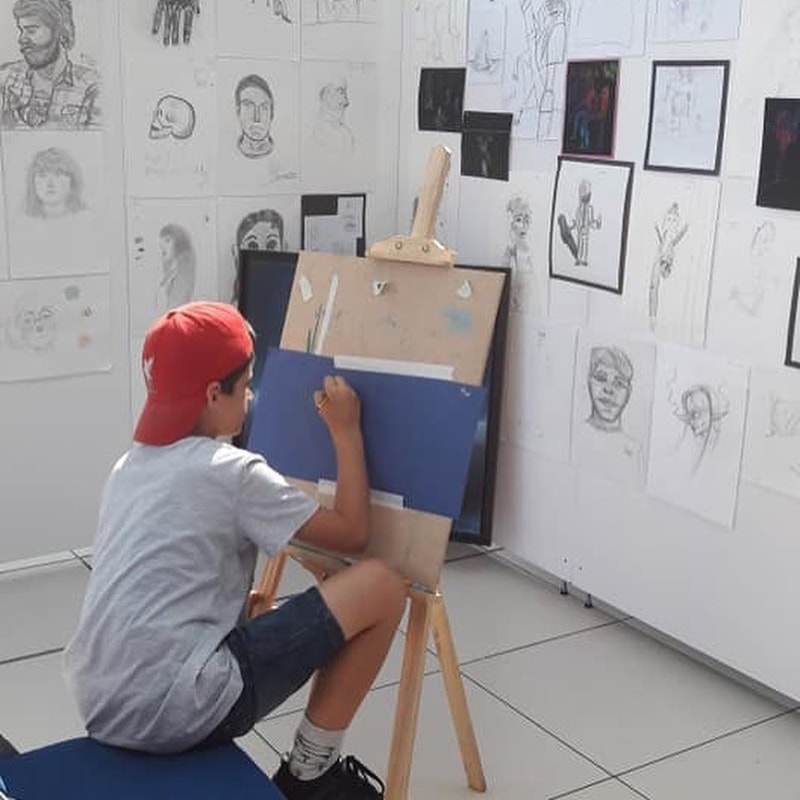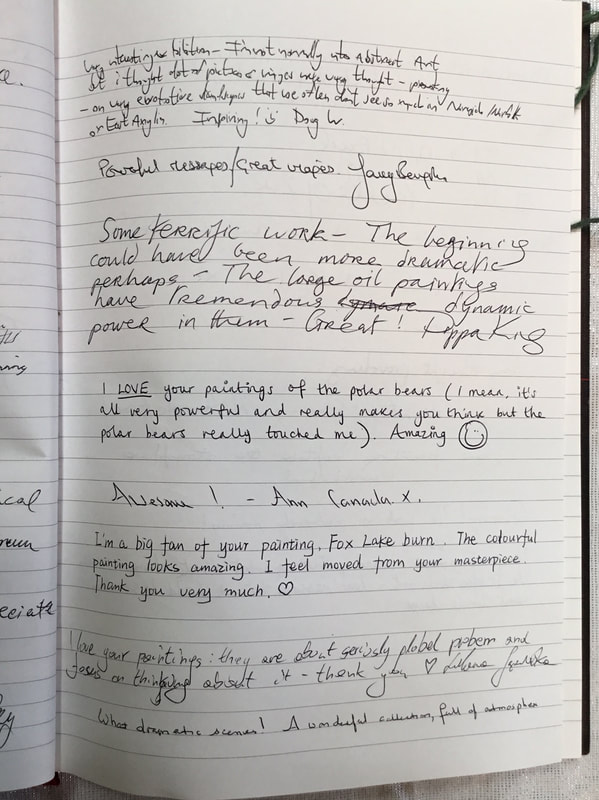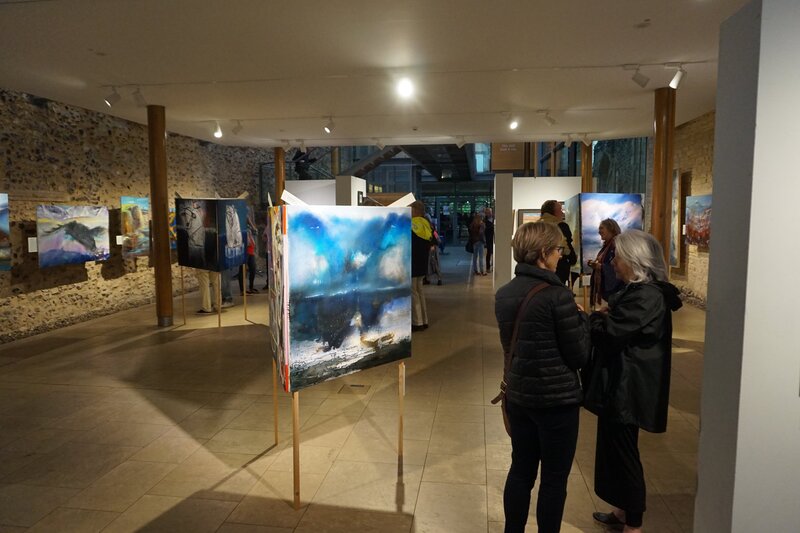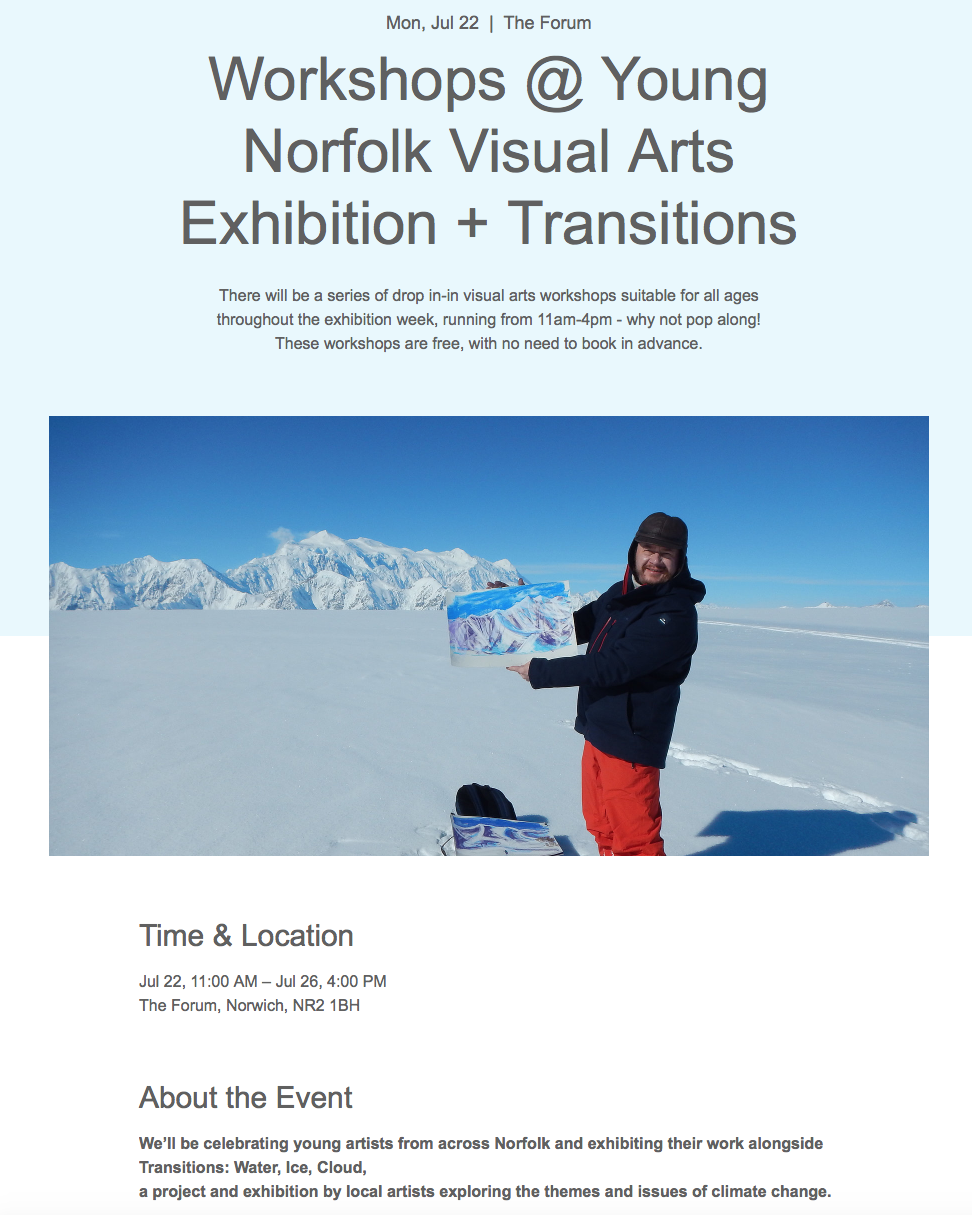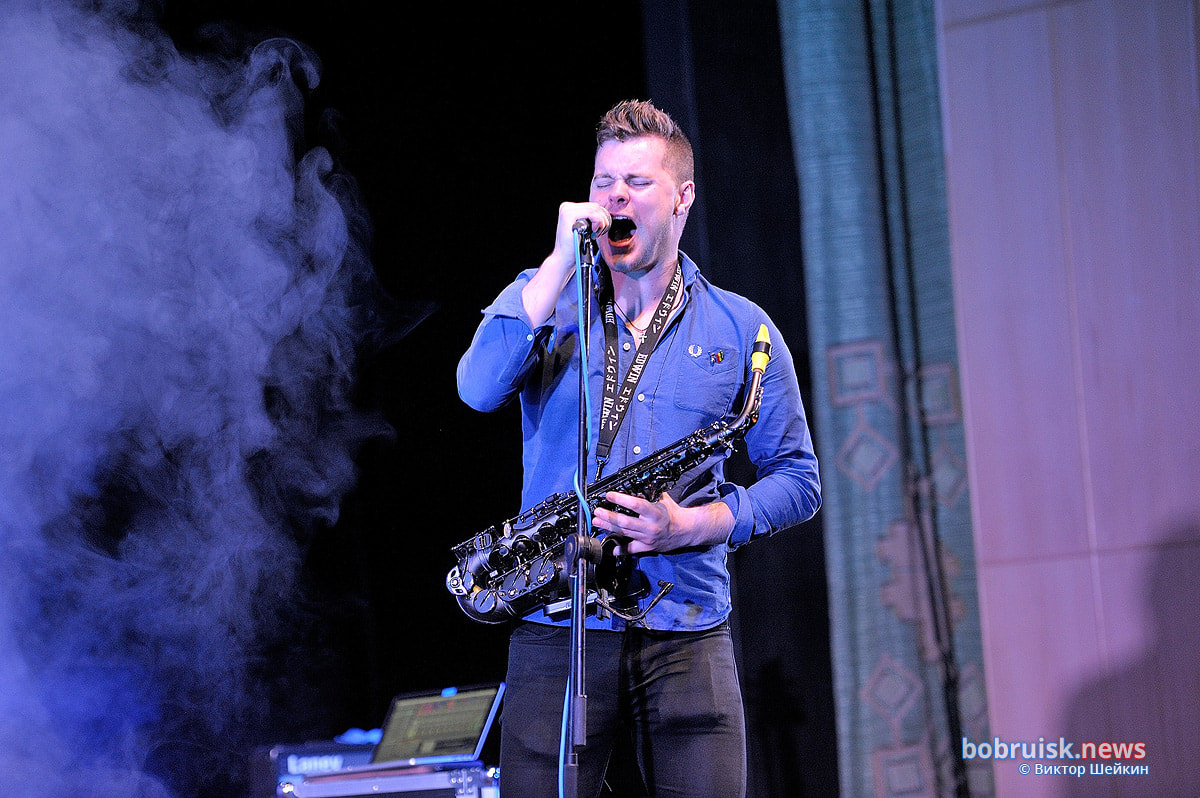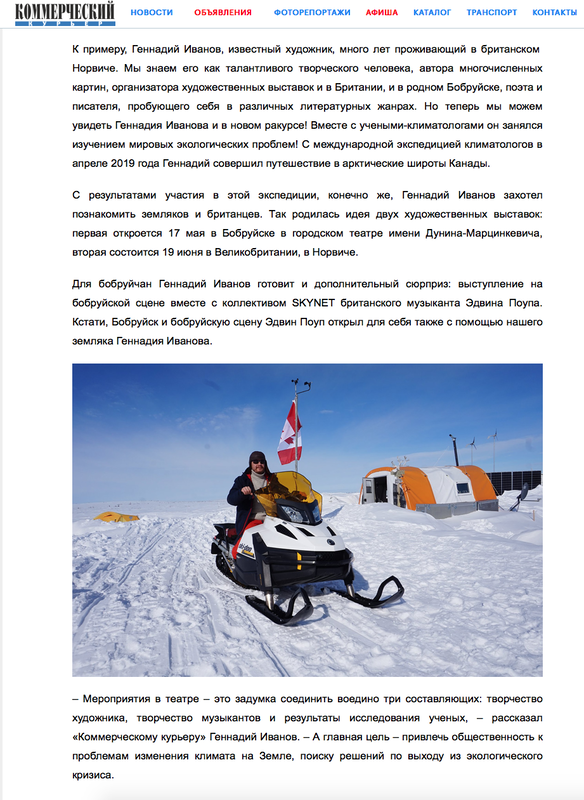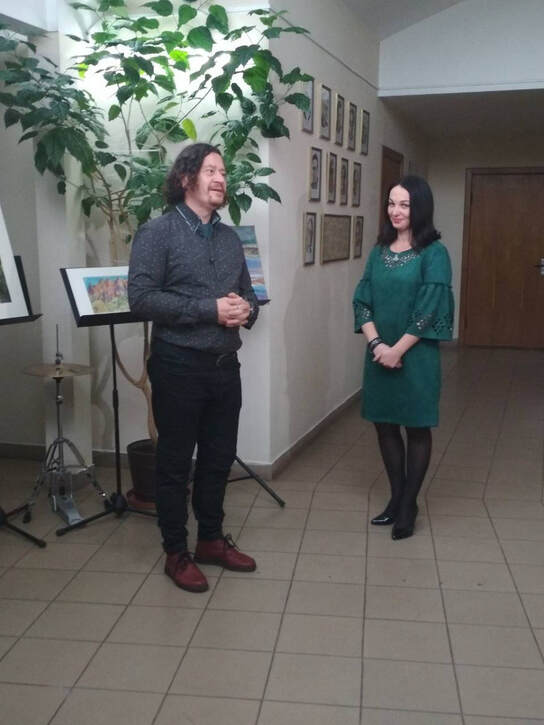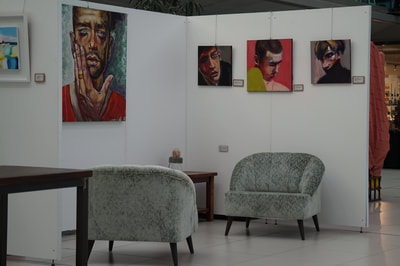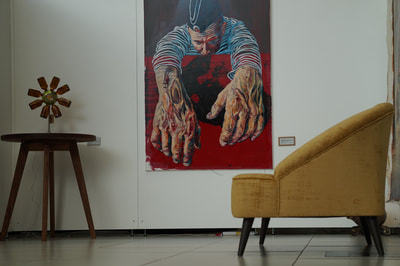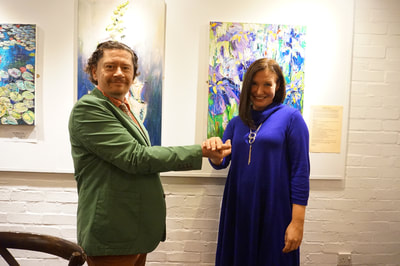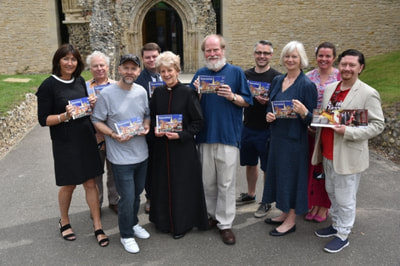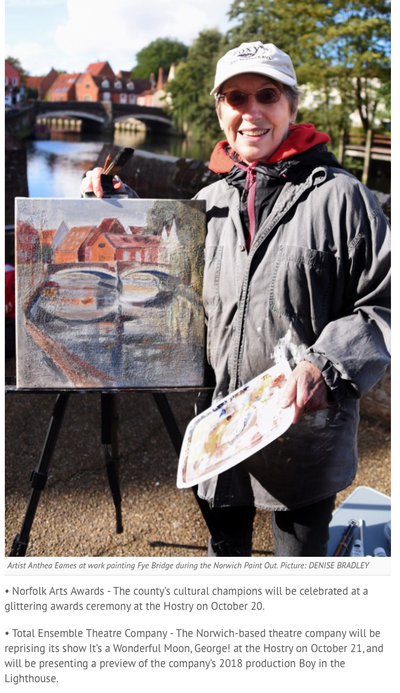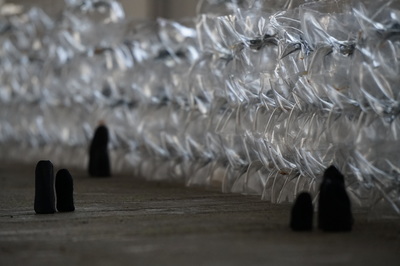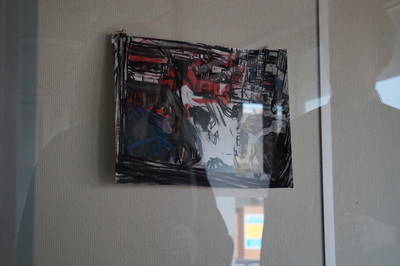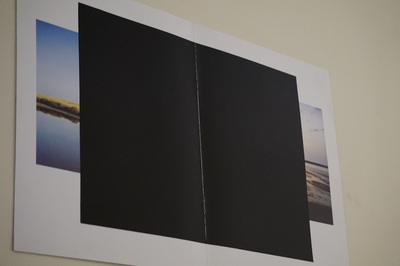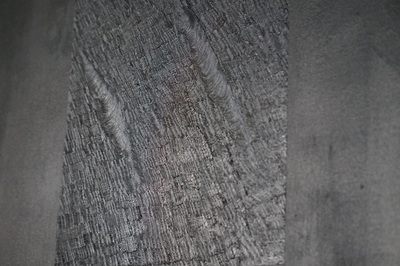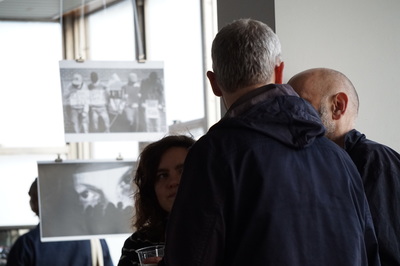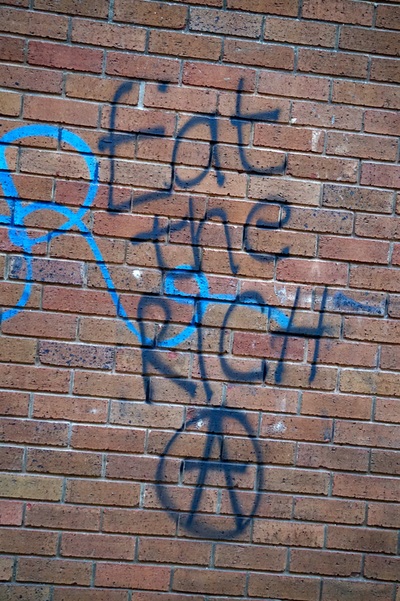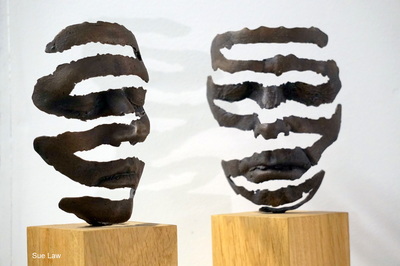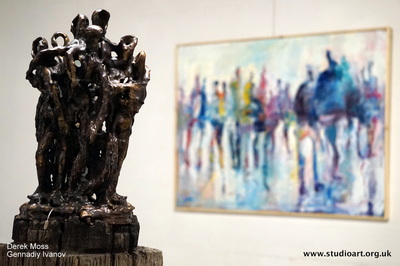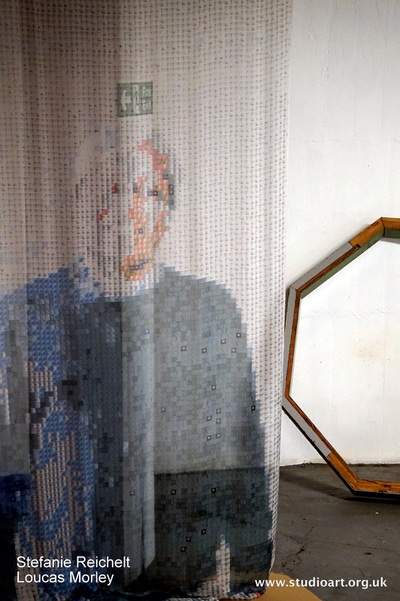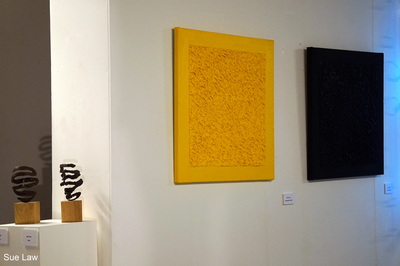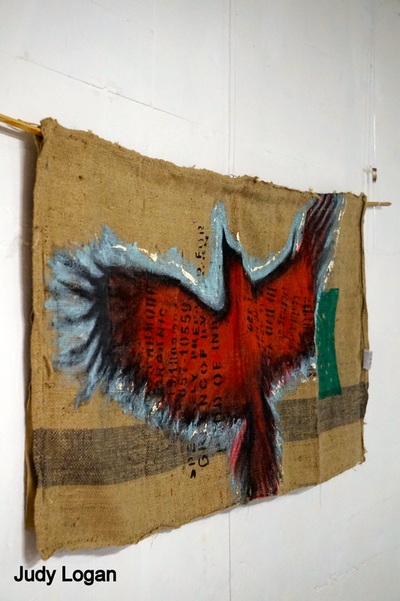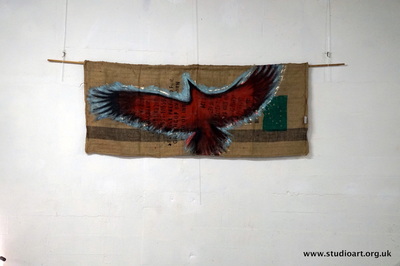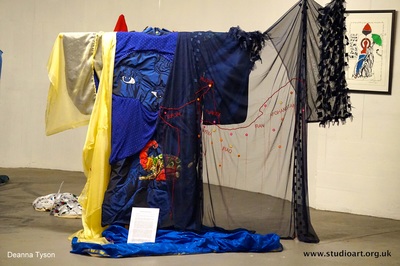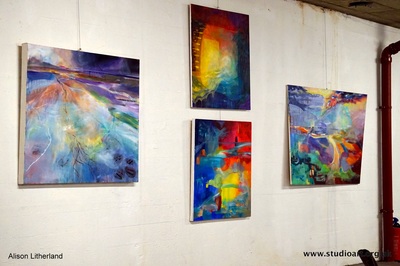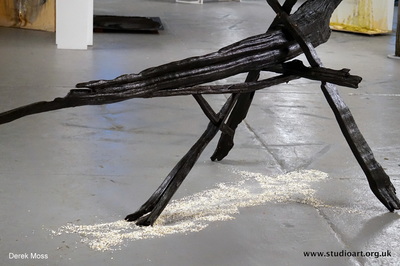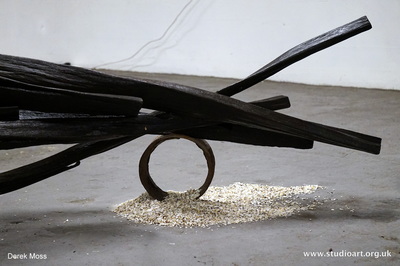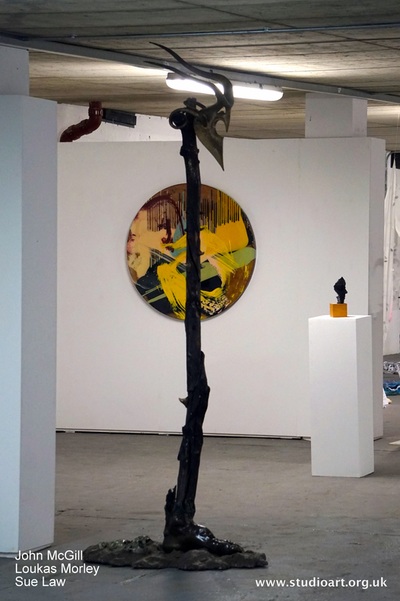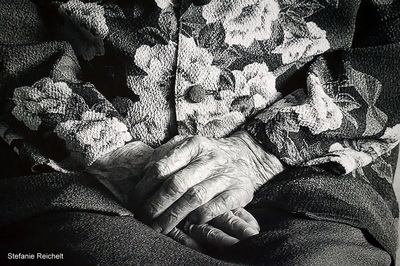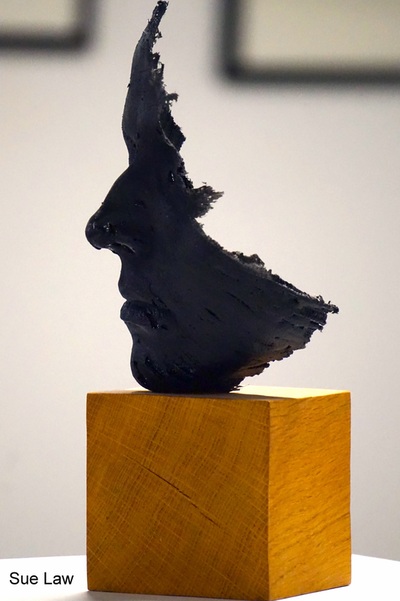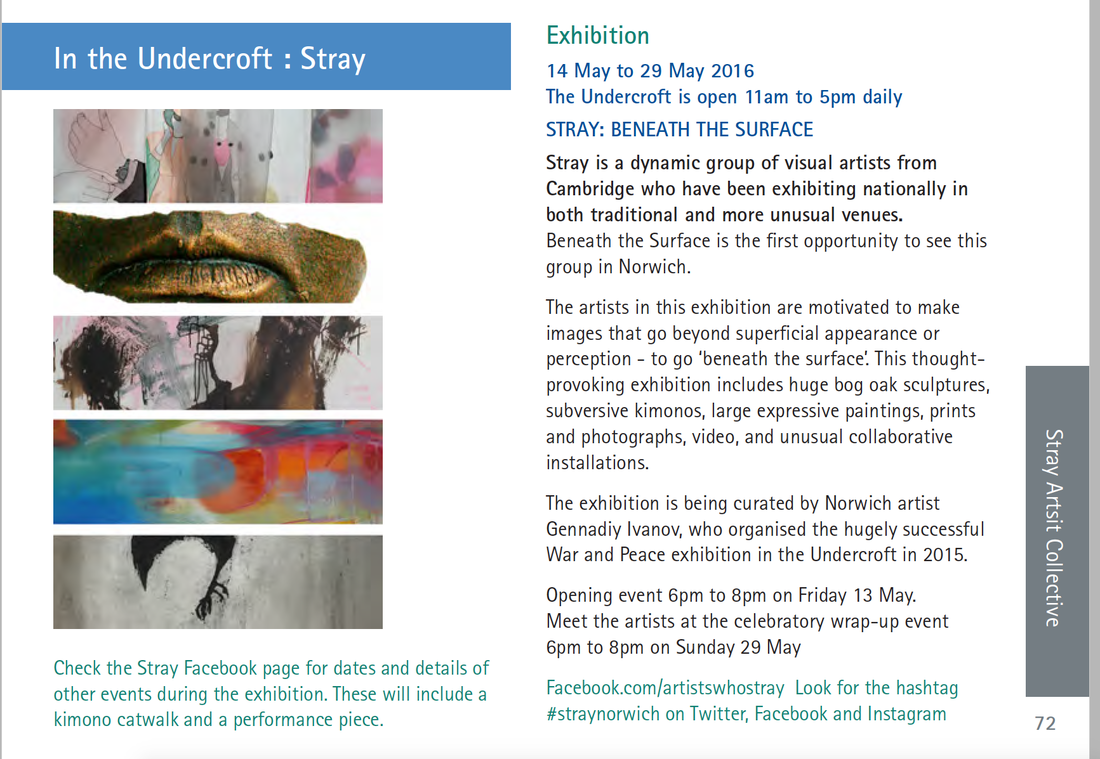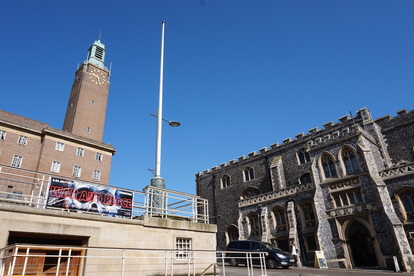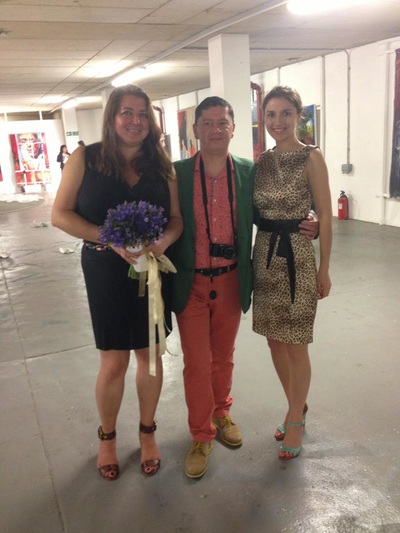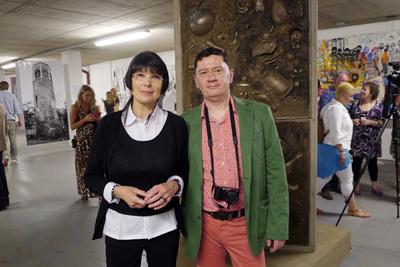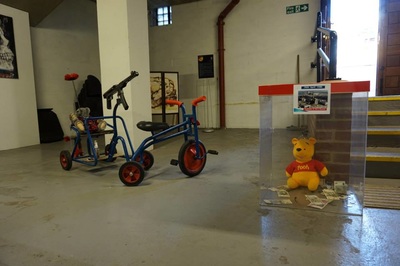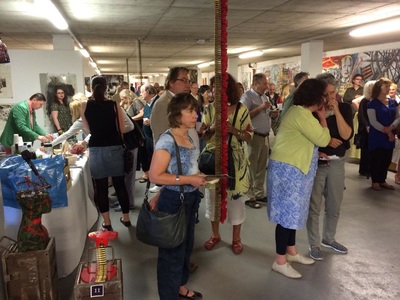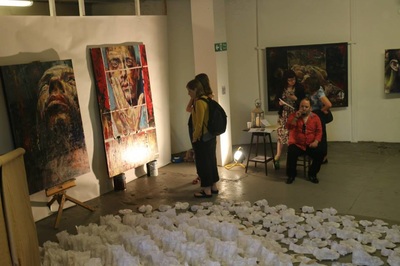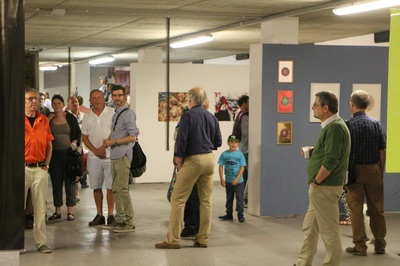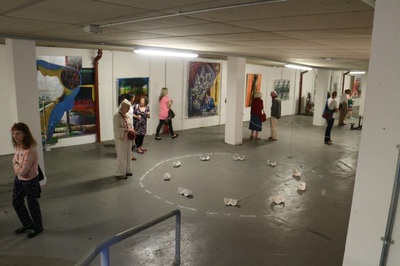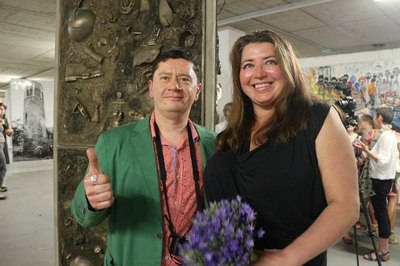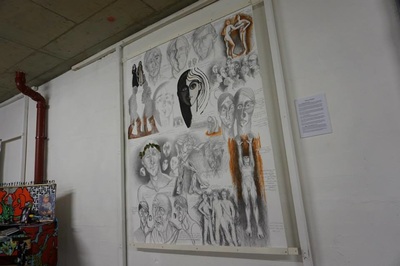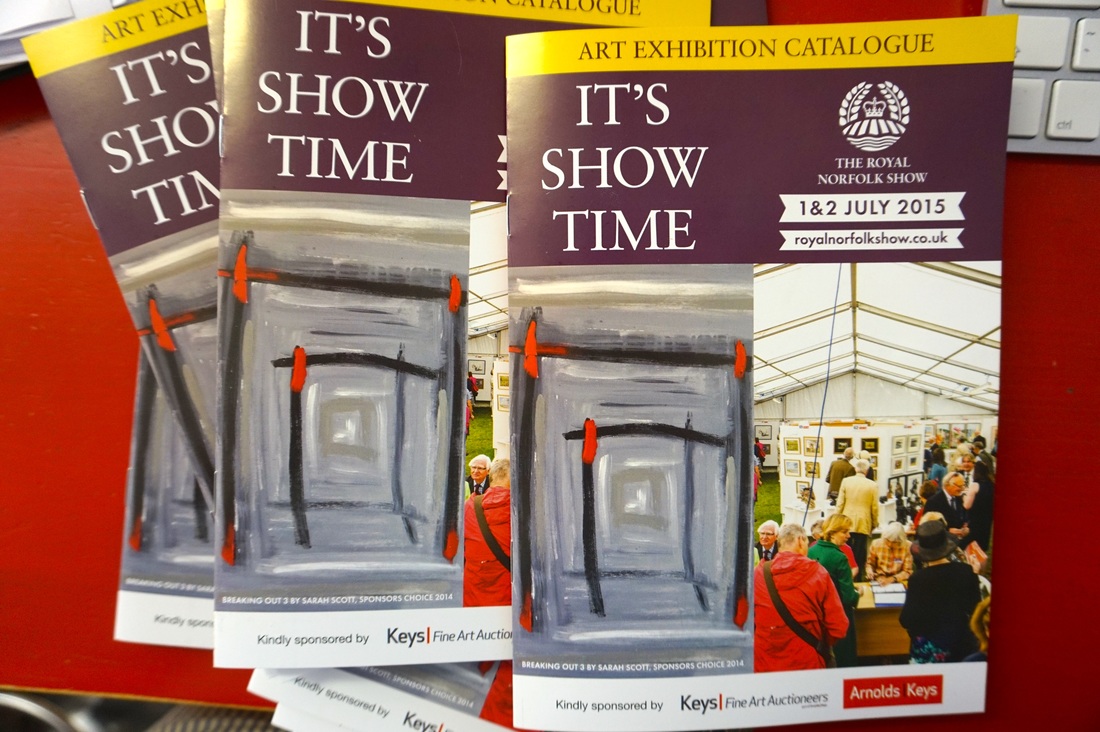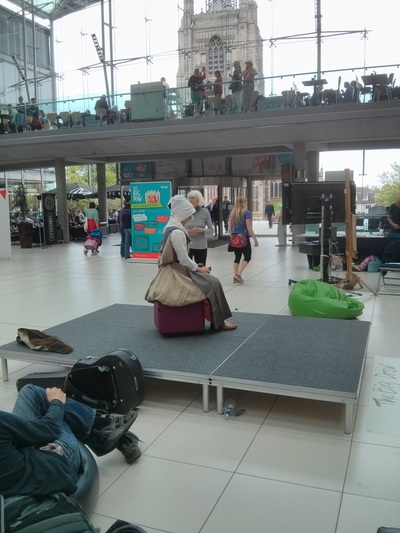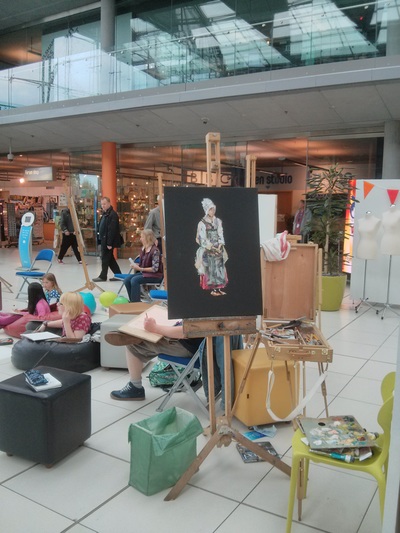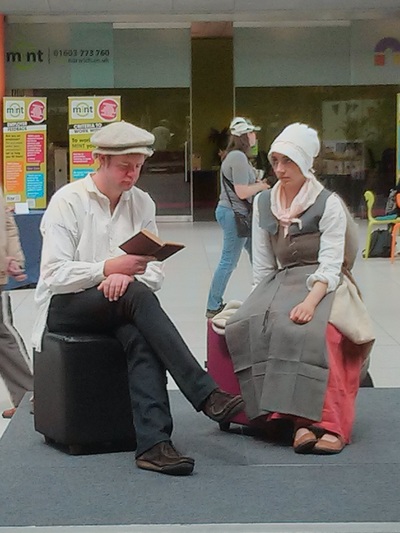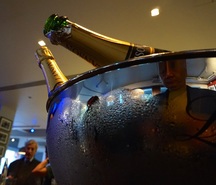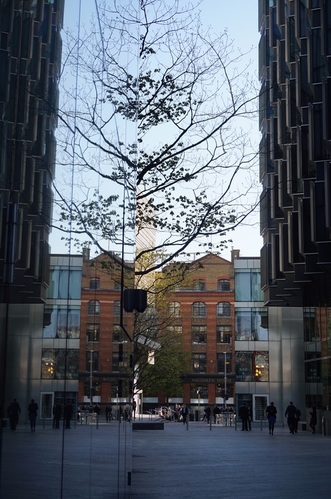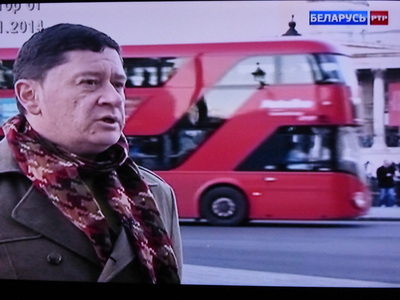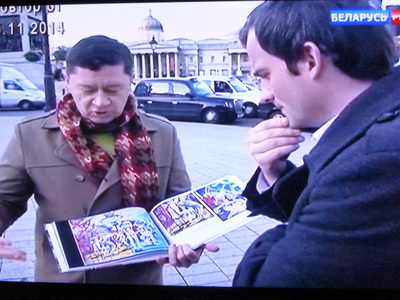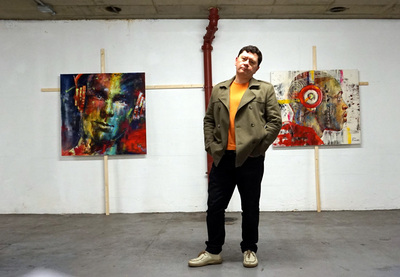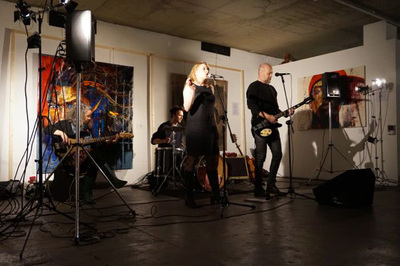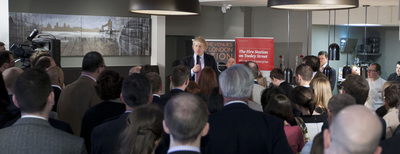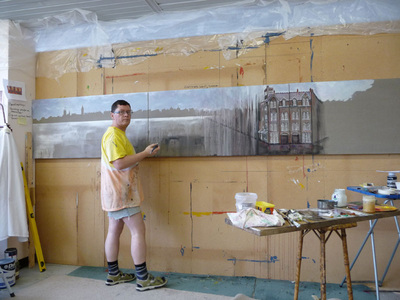Кто предвидел наводнение в Дубае? Как бывший бобруйчанин предсказал эту катастрофу. 22 Апр 2024, 14:51. Newspapers Komkur.info, Bobruisk. ru
Couple articles in my hometown newspapers. And more information by the links below. Easy to translate via google. . @probobruisk @bobruisk.news @gwf_water https://komkur.info/.../kto-predvidel-navodnenie-v-dubae... https://bobruisk.ru/.../navodnenie-v-dubae-bylo... For more information follow the links please. Thanks to Galina Chiruk for the great interviews.
Наш земляк, художник Геннадий Иванов на своей картине предсказал погодные катаклизмы в Дубае.
Мировые СМИ в нынешнем апреле пестрят заголовками: «Дубай ушел под воду!», «В Дубае апокалипсис!». Сильнейшие ливни и ураганы обрушились на Ближний Восток. Интернет наполнен видеороликами о катастрофе в Дубае, где затоплены нижние этажи зданий, ушли под воду дороги, а по улицам крупнейшего города ОАЭ плавают автомобили. Непогода затронула Катар, Бахрейн и Оман, но основной удар обрушился Дубай. Информационное агентство WAM назвало эти катаклизмы «историческим погодным явлением», выпало рекордное количество осадков за последние 75 лет.
Невероятно, но эти катаклизмы в пустыне еще год назад предвидел наш земляк художник Геннадий Иванов, сегодня проживающий в британском Норидже.
Дубай уходит под воду Вот уже несколько лет Геннадий Иванов работает в уникальном новаторском партнерстве с канадским ученым-климатологом Джоном Помероем и британским ученым Тревором Дэвисом в рамках исследовательского проекта «Глобальное будущее воды», посвященного изменению климата. В ноябре 2023 года к международному климатическому саммиту COP28, проходившему в Дубае в декабре, художник нарисовал картину «Нас не беспокоит». Этот холст оказался пророческим!О том, как художник Геннадий Иванов смог предвидеть будущее за пять месяцев до реальных событий, мы поинтересовались у него по телефону.— Да, действительно, я маслом на холсте изобразил Дубай, затопленный водой, — рассказывает художник. — Название картины взял из ответа одного из арабских шейхов на вопрос о его мнении о последствиях изменения климата. Наводнение в пустыне казалось невероятным в тот момент, когда я работал над картиной. Никак не ожидал, что моя интерпретация результатов исследований ученых окажется столь актуальной.Геннадий отметил, что идея изобразить наводнение в крупнейшем городе ОАЭ появилась в связи с тем, что он хотел проиллюстрировать влияние на Дубай повышения уровня моря примерно к концу столетия. Художник хотел показать, что могло случиться, если бы мир не стал сокращать выбросы парниковых газов в атмосферу. Геннадий Иванов ошибся в сроках, но стал провидцем, об этом сейчас говорят ученые-климатологи. Мурал в мэрии Нориджа За время работы с профессорами Тревором Дэвисом и Джоном Помероем художник Геннадий Иванов создал более 300 картин, посвященных последствиям изменения климата.Экстремальные погодные явления являются неотъемлемой частью глобального потепления, считают климатологи, их нельзя предсказать точно, но они будут происходить чаще и чаще по всему земному шару.На многих картинах Геннадия изображены последствия изменения климата на побережье Норфолка, в том числе на фреске о проблемах изменения климата, размещенной в мэрии Нориджа в зале заседаний городского совета. За создание этого мурала художник получил награду Университета Восточной Англии.Геннадий Иванов поделился и планами на будущий год: выставках своих картин в Южной Корее, на Филлипинах, в Малайзии и Сингапуре.О творчестве художника и как бывший бобруйчанин помогает решать мировые экологические проблемы, можно прочитать ЗДЕСЬ.
Our countryman, the artist Gennady Ivanov, predicted weather disasters in Dubai in his painting.
The world's media this April are full of headlines: "Dubai has gone under water!", "The apocalypse in Dubai!". Heavy rains and hurricanes hit the Middle East. The Internet is filled with videos about the disaster in Dubai, where the lower floors of buildings are flooded, roads are submerged, and cars float along the streets of the largest city in the UAE. Bad weather affected Qatar, Bahrain and Oman, but Dubai took the brunt. The WAM news agency called these cataclysms a "historic weather phenomenon", with record rainfall over the past 75 years.
Incredibly, these cataclysms in the desert were foreseen a year ago by our fellow countryman, the artist Gennady Ivanov, who now lives in British Norwich.
For several years now, Gennady Ivanov has been working in a unique, innovative partnership with Canadian climate scientist John Pomeroy and British scientist Trevor Davis as part of the Global Future of Water research project on climate change. In November 2023, for the COP28 International climate summit, held in Dubai in December, the artist painted a picture "It doesn't bother us." This canvas turned out to be prophetic!We asked him on the phone how the artist Gennady Ivanov was able to foresee the future five months before the real events.— Yes, indeed, I painted Dubai flooded with water in oil on canvas, — says the artist. — I took the title of the painting from the answer of one of the Arab sheikhs to a question about his opinion on the consequences of climate change. The flood in the desert seemed incredible at the moment when I was working on the painting. I did not expect that my interpretation of the results of scientists' research would be so relevant.Gennady noted that the idea to depict flooding in the largest city of the UAE appeared due to the fact that he wanted to illustrate the impact of sea level rise on Dubai by about the end of the century. The artist wanted to show what could have happened if the world had not started reducing greenhouse gas emissions into the atmosphere. Gennady Ivanov made a mistake in the timing, but became a visionary, climate scientists are now talking about this. Mural at the Norwich City Hall During his work with Professors Trevor Davis and John Pomeroy, the artist Gennady Ivanov created more than 300 paintings dedicated to the effects of climate change.Extreme weather events are an integral part of global warming, according to climatologists, they cannot be predicted accurately, but they will occur more and more often around the globe.Many of Gennady's paintings depict the effects of climate change on the Norfolk coast, including a mural on climate change issues placed at Norwich City Hall in the City Council meeting room. For the creation of this mural, the artist received an award from the University of East Anglia.Gennady Ivanov also shared his plans for the next year: exhibitions of his paintings in South Korea, the Philippines, Malaysia and Singapore.You can read about the artist's work and how a former Bobruisk resident helps solve global environmental problems HERE.komkur.info/obshchestvo/kak-byvshij-bobrujchanin-pomogaet-reshat-mirovye-ekologicheskie-problemy
Мировые СМИ в нынешнем апреле пестрят заголовками: «Дубай ушел под воду!», «В Дубае апокалипсис!». Сильнейшие ливни и ураганы обрушились на Ближний Восток. Интернет наполнен видеороликами о катастрофе в Дубае, где затоплены нижние этажи зданий, ушли под воду дороги, а по улицам крупнейшего города ОАЭ плавают автомобили. Непогода затронула Катар, Бахрейн и Оман, но основной удар обрушился Дубай. Информационное агентство WAM назвало эти катаклизмы «историческим погодным явлением», выпало рекордное количество осадков за последние 75 лет.
Невероятно, но эти катаклизмы в пустыне еще год назад предвидел наш земляк художник Геннадий Иванов, сегодня проживающий в британском Норидже.
Дубай уходит под воду Вот уже несколько лет Геннадий Иванов работает в уникальном новаторском партнерстве с канадским ученым-климатологом Джоном Помероем и британским ученым Тревором Дэвисом в рамках исследовательского проекта «Глобальное будущее воды», посвященного изменению климата. В ноябре 2023 года к международному климатическому саммиту COP28, проходившему в Дубае в декабре, художник нарисовал картину «Нас не беспокоит». Этот холст оказался пророческим!О том, как художник Геннадий Иванов смог предвидеть будущее за пять месяцев до реальных событий, мы поинтересовались у него по телефону.— Да, действительно, я маслом на холсте изобразил Дубай, затопленный водой, — рассказывает художник. — Название картины взял из ответа одного из арабских шейхов на вопрос о его мнении о последствиях изменения климата. Наводнение в пустыне казалось невероятным в тот момент, когда я работал над картиной. Никак не ожидал, что моя интерпретация результатов исследований ученых окажется столь актуальной.Геннадий отметил, что идея изобразить наводнение в крупнейшем городе ОАЭ появилась в связи с тем, что он хотел проиллюстрировать влияние на Дубай повышения уровня моря примерно к концу столетия. Художник хотел показать, что могло случиться, если бы мир не стал сокращать выбросы парниковых газов в атмосферу. Геннадий Иванов ошибся в сроках, но стал провидцем, об этом сейчас говорят ученые-климатологи. Мурал в мэрии Нориджа За время работы с профессорами Тревором Дэвисом и Джоном Помероем художник Геннадий Иванов создал более 300 картин, посвященных последствиям изменения климата.Экстремальные погодные явления являются неотъемлемой частью глобального потепления, считают климатологи, их нельзя предсказать точно, но они будут происходить чаще и чаще по всему земному шару.На многих картинах Геннадия изображены последствия изменения климата на побережье Норфолка, в том числе на фреске о проблемах изменения климата, размещенной в мэрии Нориджа в зале заседаний городского совета. За создание этого мурала художник получил награду Университета Восточной Англии.Геннадий Иванов поделился и планами на будущий год: выставках своих картин в Южной Корее, на Филлипинах, в Малайзии и Сингапуре.О творчестве художника и как бывший бобруйчанин помогает решать мировые экологические проблемы, можно прочитать ЗДЕСЬ.
Our countryman, the artist Gennady Ivanov, predicted weather disasters in Dubai in his painting.
The world's media this April are full of headlines: "Dubai has gone under water!", "The apocalypse in Dubai!". Heavy rains and hurricanes hit the Middle East. The Internet is filled with videos about the disaster in Dubai, where the lower floors of buildings are flooded, roads are submerged, and cars float along the streets of the largest city in the UAE. Bad weather affected Qatar, Bahrain and Oman, but Dubai took the brunt. The WAM news agency called these cataclysms a "historic weather phenomenon", with record rainfall over the past 75 years.
Incredibly, these cataclysms in the desert were foreseen a year ago by our fellow countryman, the artist Gennady Ivanov, who now lives in British Norwich.
For several years now, Gennady Ivanov has been working in a unique, innovative partnership with Canadian climate scientist John Pomeroy and British scientist Trevor Davis as part of the Global Future of Water research project on climate change. In November 2023, for the COP28 International climate summit, held in Dubai in December, the artist painted a picture "It doesn't bother us." This canvas turned out to be prophetic!We asked him on the phone how the artist Gennady Ivanov was able to foresee the future five months before the real events.— Yes, indeed, I painted Dubai flooded with water in oil on canvas, — says the artist. — I took the title of the painting from the answer of one of the Arab sheikhs to a question about his opinion on the consequences of climate change. The flood in the desert seemed incredible at the moment when I was working on the painting. I did not expect that my interpretation of the results of scientists' research would be so relevant.Gennady noted that the idea to depict flooding in the largest city of the UAE appeared due to the fact that he wanted to illustrate the impact of sea level rise on Dubai by about the end of the century. The artist wanted to show what could have happened if the world had not started reducing greenhouse gas emissions into the atmosphere. Gennady Ivanov made a mistake in the timing, but became a visionary, climate scientists are now talking about this. Mural at the Norwich City Hall During his work with Professors Trevor Davis and John Pomeroy, the artist Gennady Ivanov created more than 300 paintings dedicated to the effects of climate change.Extreme weather events are an integral part of global warming, according to climatologists, they cannot be predicted accurately, but they will occur more and more often around the globe.Many of Gennady's paintings depict the effects of climate change on the Norfolk coast, including a mural on climate change issues placed at Norwich City Hall in the City Council meeting room. For the creation of this mural, the artist received an award from the University of East Anglia.Gennady Ivanov also shared his plans for the next year: exhibitions of his paintings in South Korea, the Philippines, Malaysia and Singapore.You can read about the artist's work and how a former Bobruisk resident helps solve global environmental problems HERE.komkur.info/obshchestvo/kak-byvshij-bobrujchanin-pomogaet-reshat-mirovye-ekologicheskie-problemy
The 15th Eurasia Forum of Social Workers in Thailand in Pattaya. 19-23 March.
Talk at the Forum: Plenary Session 2: Social Work and Sustainability 2.1 Green social work and ESG towards sustainable development. 21st March |
I was tremendously interesting for me as an artist , because I am very interested the social thoughtful art, and it was great to share with my artworks to the other audience in the other side of the planet. it was a lot of interest to my artworks and I had a great chats with Professors in social work. Filipinos, Malaysia, South Korea, Mongolia, India, Bangladesh, Thailand and many more countries were interested to chat with me as an artist, asking some questions about my feelings about people, politics and wars.
And in my speech I said: I admire the very important work of social workers; it is one of the most Humane jobs -taking care of a person. In my work, I have always raised and continue to raise the issues of man, his life, environment, politics, history, present and future. Without the past, people have no understanding of the future. And for me, as an artist who is interested in history, it is important to show the processes that unite us in the past, present and how they lead us into the future. Today's forum is an excellent example of how people from all over the world, from different countries with different cultures, can unite the most important humanitarian issues of the same kind. These are issues of stability of life and raising its level. If you look at my paintings, they raise the main human issues-love, hate, fear, problems of various dependence on drugs, alcohol, climate, hunger, homelessness. All this is expressed through visual art, sometimes it shocks some people, but at the same time it makes them look at themselves from the outside and ask questions about themselves, their behaviour, the behaviour of others, ask politicians and elites where they are leading us, into what kind of life and with what life attitudes and goals. It is important for me to realize that my paintings work in the right direction and for any audience. You can't dismiss such a thing like an annoying fly, such a picture, if you saw it once, will remain in front of your eyes forever. I have seen many times at exhibitions how people cried and asked questions. And this is the main value for an artist, that he understands that he is creating and working for a reason. You can see several papers on climate change. This is one of the most important issues of our time, because almost every region in the world has suffered and is suffering, sometimes from drought and heat, then from floods and terrible cold and hunger. And some more great moments from exhibition on the Pattaya beach, visit the children's home, a special concert for the social workers by Thai people and kids. It was lovely! Next year exhibition in South Korea! |
Plain air in Pattaya, Pastel Drawings
2023 UEA Innovation & Impact Award , Norwich, 15 February, Finalist

Partnership of the Year.
A climate mural for our times: global science, local expression.
Dr Michael Taylor and Prof Trevor Davies (School of Environmental Sciences), artist Gennadiy Ivanov.
A powerful combination of scientific and artistic creativity, involving continuous dialogue between scientists, artist and civic leader over two years. The soul of the mural was created from innovative analysis and visualisation of climate data.
Prof Davies’s suggestion of a painting for City Hall, featuring the work of CRU, was enthusiastically welcomed by Alan Waters (then leader of Norwich City Council). A mural was commissioned for the Council Chamber to constantly remind decision-makers to address climate change. It is also the focus of continuing community projects and a rallying call for other local authorities.
Although artist Gennadiy Ivanov’s mind would motivate his brushstrokes,it was agreed that interpretation would be based on – and depict – the very latest science.
The keystone of the mural is its skyline; the temperature record from 65 million years ago through two possible scenarios for the next 200 years. The cataclysm of the Chicxulub asteroid is the starting point because of the relevance of the resulting mass extinction of species and the next 200 years may see temperatures climb towards the highs of this geological period.
This presented huge scientific challenges. The resolution/range of temperature reconstructions vary enormously over time. Information for periods of societal experience and future needed to be represented in detail. One of the six mural panels would span 62 million years and >10oC; another only centuries and 1oC, yet still enough to have enormous impacts on human societies.
Dr Taylor sourced temperature reconstructions for each panel, including the CRU instrumental record for the 1850-present panel, compiled/combined them, and iterated with Ivanov to represent them as coloured stripes but with novel choices of gradations to account for disparate resolutions/ranges. Ivanov used these to remarkable effect in his skyline above the Norfolk coastline. This crucial information makes the mural a powerful messenger for the impact of climate change and pinpoints the now-or-never moment for action.
https://innovationandimpactawards.uea.ac.uk/2023-finalists/
A climate mural for our times: global science, local expression.
Dr Michael Taylor and Prof Trevor Davies (School of Environmental Sciences), artist Gennadiy Ivanov.
A powerful combination of scientific and artistic creativity, involving continuous dialogue between scientists, artist and civic leader over two years. The soul of the mural was created from innovative analysis and visualisation of climate data.
Prof Davies’s suggestion of a painting for City Hall, featuring the work of CRU, was enthusiastically welcomed by Alan Waters (then leader of Norwich City Council). A mural was commissioned for the Council Chamber to constantly remind decision-makers to address climate change. It is also the focus of continuing community projects and a rallying call for other local authorities.
Although artist Gennadiy Ivanov’s mind would motivate his brushstrokes,it was agreed that interpretation would be based on – and depict – the very latest science.
The keystone of the mural is its skyline; the temperature record from 65 million years ago through two possible scenarios for the next 200 years. The cataclysm of the Chicxulub asteroid is the starting point because of the relevance of the resulting mass extinction of species and the next 200 years may see temperatures climb towards the highs of this geological period.
This presented huge scientific challenges. The resolution/range of temperature reconstructions vary enormously over time. Information for periods of societal experience and future needed to be represented in detail. One of the six mural panels would span 62 million years and >10oC; another only centuries and 1oC, yet still enough to have enormous impacts on human societies.
Dr Taylor sourced temperature reconstructions for each panel, including the CRU instrumental record for the 1850-present panel, compiled/combined them, and iterated with Ivanov to represent them as coloured stripes but with novel choices of gradations to account for disparate resolutions/ranges. Ivanov used these to remarkable effect in his skyline above the Norfolk coastline. This crucial information makes the mural a powerful messenger for the impact of climate change and pinpoints the now-or-never moment for action.
https://innovationandimpactawards.uea.ac.uk/2023-finalists/
The Status and Future of Freshwater Supply in Canada, 06-03-2024
|
Nice to see the new presentation by Professor Pomeroy. And also it’s great to see my art works he used. Great thanks for this.
Speaker: Dr. John Pomeroy Subject: The Status and Future of Freshwater Supply in Canada Summary: Climate change, land cover change and changing water management are altering the supply of freshwater in Canada such that it is no longer reliable in some regions of the country. This talk will review the expected implications for Canadian hydrology of changes to climate, land cover and water management and then zero in on a few regions where water stress due to semi-arid climates or circumpolar climates are expected to increase this century. Predicted changes to the hydrology and water supply of the Mackenzie, Saskatchewan and Okanagan River basins will be reviewed. Then, the impacts of deglaciation, permafrost thaw and reduced snow cover as well as impacts of loss of forest cover will be discussed along with adaptation and management options that need to be considered in these river basins and across Canada. Bio: Dr. John Pomeroy is Director of the Global Water Futures Programme – the largest, and most published university-led freshwater research project in the world and its follow-on the Global Water Futures Observatories Project. At the University of Saskatchewan, he is the Canada Research Chair in Water Resources and Climate Change, UNESCO Chair in Mountain Water Sustainability, Distinguished Professor of Geography, Director of the Centre for Hydrology, and Director of the Coldwater Laboratory, Canmore, AB. He is a Fellow of the Royal Society of Canada, the American Geophysical Union and the Royal Geographical Society and serves as Institute Professor of the Biogeoscience Institute of the University of Calgary and Adjunct Professor of the University of Waterloo and of Wilfrid Laurier University. For the World Climate Research Programme, Pomeroy leads the International Network for Alpine Research Catchment Hydrology project. He was elected to represent Academia on the Steering Committee of the Water and Climate Coalition of UN agencies. Dr. Pomeroy was the 2021 recipient of the Walter Langbein Lecture Award for hydrology from the American Geophysical Union, 2019 recipient of the Miroslaw Romanowski Medal for environmental science from the Royal Society of Canada, and the 2017 recipient of the J Tuzo Wilson Medal for geophysics from the Canadian Geophysical Union. He has served as the founder and President of the International Commission on Snow and Ice Hydrology, Chair of the International Decade for Predictions in Ungauged Basins, President of the Canadian Geophysical Union, the first Professor of Hydrology in Wales at the University of Wales, Aberystwyth, Research Scientist with Environment Canada and the USDA Forest Service and a NATO Science Fellow at the University of East Anglia, England. His primary research interests are snow hydrology, the impact of land use and climate change on hydrology and water quality, and improved observation and prediction of climate change impacts, especially floods and droughts. He has developed several hydrological models and a network of hydrological research basins. Dr. Pomeroy has authored over 400 research articles and reports and several books that have been cited over 25,000 times. Administration: – The CACOR Sponsor is Jean Dougherty |
|
Incredible feelings about future exhibition in Thailand in Pattaya city during the Eurasia Forum of Social Workers 19-22 March 2024.
It nice to feel what my works important and will be presented in the other side of the planet and it doesn't matter if its Canada or Thailand , most important to show and rise the voice , talk about the world and humanity problems. In my work, I have always raised and continue to raise the issues of human & humanity, our life, environment, politics, history, present and future. Without the past, people have no understanding of the future. And for me, as an artist who is interested in history, it is important to show the processes that unite us in the past, present and how this processes lead us into the future. With Антонина Дашкина and Tony Widmer Chinchai Cheecharoen thank you ! |
Couple articles in Belarus mass and social media , February 2024
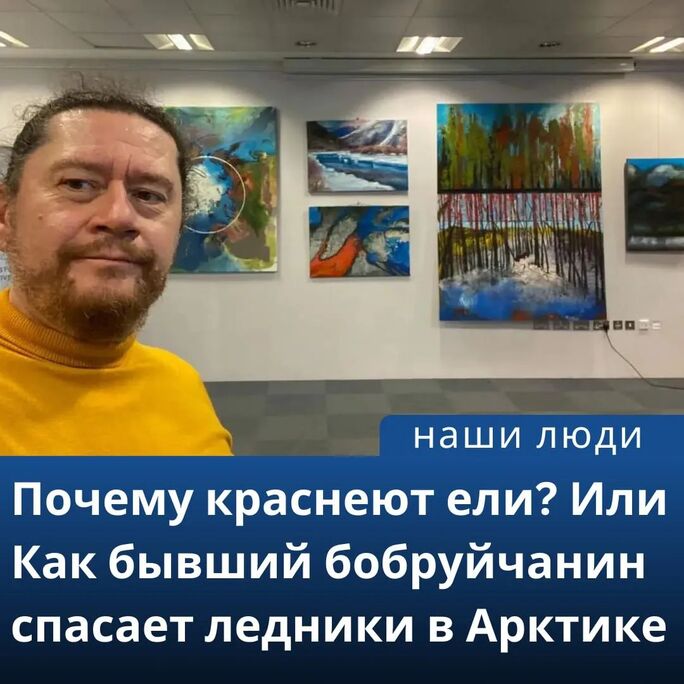
www.instagram.com/p/C3UQXdaoVlA/?utm_source=ig_web_copy_link&igsh=MzRlODBiNWFlZA==Художник Геннадий Иванов работал на разных континентах, а также на ледниках, которые постоянно находятся в движении, и там, где снимались многие голливудские фильмы.
Генеральная Ассамблея ООН объявила 2025-й Международным годом сохранения ледников. А 21 марта каждого года, начиная с 2025-го, будет отмечаться как Всемирный день ледников. К Международному году сохранения ледников уже готовится книга репродукций работ бывшего бобруйчанина Геннадия Иванова по климатическому проекту при поддержке ЮНЕСКО.
💦 Цель Международного года сохранения ледников и Всемирного дня — повышение осведомленности во всем мире о решающей роли ледников, снега и льда в климатической системе и гидрологическом цикле, об экономических, социальных и экологических последствиях надвигающихся изменений в криосфере Земли.
Художник Геннадий Иванов ныне проживает британском Норидже, вместе с канадским ученым-климатологом Джоном Помероем и британским ученым Тревором Дэвисом уже пять лет активно участвует в международном климатическом исследовательском проекте «Глобальное будущее воды». Это научные экспедиции по изучению пресноводных ресурсов в арктических широтах Канады, подверженных самым высоким темпам потепления на планете.
📱Мы созвонились с Геннадием Ивановым, чтобы подробнее узнать о его будущей книге и планах на дальнейшую работу.
👨🏻🎨– Вы застали меня в Марокко, тут я много работаю, рисую, — рассказал художник. – Скоро улетаю в Италию, где тоже планирую рисовать. В марте мне предстоит художественная выставка в Таиланде. Но работа в климатическом проекте «Переходы» в рамках более объемного новаторского исследовательского проекта «Глобальное будущее воды» также будет продолжаться!
Проект поддерживается Канадским исследовательским фондом передового опыта правительства Канады и управляется Университетом Саскачевана с тремя основными партнерами (университеты Ватерлоо, Макмастер, Лорье) и еще 14 канадскими университетами.
По словам Геннадия Иванова, в будущую книгу вошли его работы из трех экспедиций.
Вместе с учеными-климатологами в 2019 году художник побывал на Скалистых горах Альберто, увидел завораживающие красотой пейзажи, национальные заповедники, горы…
More , follow the link below:
https://www.instagram.com/p/C3UQXdaoVlA/?utm_source=ig_web_copy_link&igsh=MzRlODBiNWFlZA==
Генеральная Ассамблея ООН объявила 2025-й Международным годом сохранения ледников. А 21 марта каждого года, начиная с 2025-го, будет отмечаться как Всемирный день ледников. К Международному году сохранения ледников уже готовится книга репродукций работ бывшего бобруйчанина Геннадия Иванова по климатическому проекту при поддержке ЮНЕСКО.
💦 Цель Международного года сохранения ледников и Всемирного дня — повышение осведомленности во всем мире о решающей роли ледников, снега и льда в климатической системе и гидрологическом цикле, об экономических, социальных и экологических последствиях надвигающихся изменений в криосфере Земли.
Художник Геннадий Иванов ныне проживает британском Норидже, вместе с канадским ученым-климатологом Джоном Помероем и британским ученым Тревором Дэвисом уже пять лет активно участвует в международном климатическом исследовательском проекте «Глобальное будущее воды». Это научные экспедиции по изучению пресноводных ресурсов в арктических широтах Канады, подверженных самым высоким темпам потепления на планете.
📱Мы созвонились с Геннадием Ивановым, чтобы подробнее узнать о его будущей книге и планах на дальнейшую работу.
👨🏻🎨– Вы застали меня в Марокко, тут я много работаю, рисую, — рассказал художник. – Скоро улетаю в Италию, где тоже планирую рисовать. В марте мне предстоит художественная выставка в Таиланде. Но работа в климатическом проекте «Переходы» в рамках более объемного новаторского исследовательского проекта «Глобальное будущее воды» также будет продолжаться!
Проект поддерживается Канадским исследовательским фондом передового опыта правительства Канады и управляется Университетом Саскачевана с тремя основными партнерами (университеты Ватерлоо, Макмастер, Лорье) и еще 14 канадскими университетами.
По словам Геннадия Иванова, в будущую книгу вошли его работы из трех экспедиций.
Вместе с учеными-климатологами в 2019 году художник побывал на Скалистых горах Альберто, увидел завораживающие красотой пейзажи, национальные заповедники, горы…
More , follow the link below:
https://www.instagram.com/p/C3UQXdaoVlA/?utm_source=ig_web_copy_link&igsh=MzRlODBiNWFlZA==
|
https://komkur.info/obshchestvo/kak-byvshij-bobrujchanin-pomogaet-reshat-mirovye-ekologicheskie-problemy?fbclid=IwAR3wi643Rj5EKFE-JQ6kt2gyB5LQjpjxKdUhmdVaiqyPX_bsyYfznukKUMk
Художник Геннадий Иванов работал на разных континентах, а также на ледниках, которые постоянно находятся в движении, и там, где снимались многие голливудские фильмы. Генеральная Ассамблея ООН объявила 2025-й Международным годом сохранения ледников. А 21 марта каждого года, начиная с 2025-го, будет отмечаться как Всемирный день ледников. К Международному году сохранения ледников уже готовится книга репродукций работ бывшего бобруйчанина Геннадия Иванова по климатическому проекту при поддержке ЮНЕСКО. Цель Международного года сохранения ледников и Всемирного дня — повышение осведомленности во всем мире о решающей роли ледников, снега и льда в климатической системе и гидрологическом цикле, об экономических, социальных и экологических последствиях надвигающихся изменений в криосфере Земли. Почему краснеют ели и приходят пожары? Напомним читателям, художник Геннадий Иванов ныне проживает британском Норидже, вместе с канадским ученым-климатологом Джоном Помероем и британским ученым Тревором Дэвисом уже пять лет активно участвует в международном климатическом исследовательском проекте «Глобальное будущее воды». Это научные экспедиции по изучению пресноводных ресурсов в арктических широтах Канады, подверженных самым высоким темпам потепления на планете. For more information, follow the link above. |
|
Very Proud to receive message with 'THANKS' from famous Canadian Explorer, Scientist and Author a lot of books Robert Sanford. He have my Polar Bear painting as for the great memories for our collaboration and work during the Transitions an art-science project. Thanks to him for a lot of support and to be a nice and kind men. Used to love to listen him. Very interesting and wise scientist and writer. Thanks for the great friendship!
Robert is author or co-author of a number of books on a range of Canadian and global water issues, including “Cold Matters: The State & Fate of Canada's Snow and Ice”; “Flood Forecast: Climate Risk & Resilience in Canada”; “The Columbia River Treaty: A Primer”, “The Climate Nexus: Water, Food, Energy and Biodiversity” ... https://livinglakescanada.ca/.../advisors/robert-sandford/ |
Robert SandfordAdvisors | All Living Lakes Canada Programs
Bob Sandford holds the Global Water Futures Chair in Water and Climate Security at the United Nations University Institute for Water, Environment and Health. In this capacity Bob was the co-author of the UN Water in the World We Want report on post-2015 global sustainable development goals relating to water. He is also lead author of Canada in the Global World, a new United Nations expert report examining the capacity of Canada’s water sector to meet and help others meet the United Nations 2030 Transforming Our World water-related Sustainable Development Goals.
In his work Bob is committed to translating scientific research outcomes into language decision-makers can use to craft timely and meaningful public policy and to bringing international example to bear on local water issues. To this end, Bob is also senior advisor on water issues for the Interaction Council, a global public policy forum composed of more than thirty former Heads of State including Canadian Prime Minister Jean Chretien, U.S. President Bill Clinton and the former Prime Minister of Norway, Gro Brundtland. Bob is also a Fellow of the Centre for Hydrology at the University of Saskatchewan and a Fellow of the Biogeoscience Institute at the University of Calgary. He is also a member of Canada’s Forum for Leadership on Water (FLOW), a national water policy research group centred in Toronto.
Bob is also the author, co-author or editor of more than thirty books including Cold Matters: The State & Fate of Canada’s Snow and Ice; Saving Lake Winnipeg; Flood Forecast: Climate Risk & Resilience in Canada; and The Columbia River Treaty: A Primer. Storm Warning: Water & Climate Security in a Changing Canada and The Climate Nexus: Water, Food, Energy and Biodiversity, which he co-authored with former Deputy Minister of Environment Jon O’Riordan. The Columbia Icefield and North America in the Anthropocene, The Hard Work of Hope: Climate Change in the Trump Era, co-authored again with Jon O’Riordan. Our Vanishing Glaciers:The Snows of Yesteryear and the Future Climate of the Mountain West recently won the prestigious $10,000 Lane Anderson Award for the best science writing in Canada in 2017. Recent titles include Quenching the Dragon: The China-Canada Water Crisis, Rain Comin’ Down and The Anthropocene Disruption.
Books by Robert (Bob) Sanford: https://www.goodreads.com/author/list/1731854.Robert_W_Sandford
Bob Sandford holds the Global Water Futures Chair in Water and Climate Security at the United Nations University Institute for Water, Environment and Health. In this capacity Bob was the co-author of the UN Water in the World We Want report on post-2015 global sustainable development goals relating to water. He is also lead author of Canada in the Global World, a new United Nations expert report examining the capacity of Canada’s water sector to meet and help others meet the United Nations 2030 Transforming Our World water-related Sustainable Development Goals.
In his work Bob is committed to translating scientific research outcomes into language decision-makers can use to craft timely and meaningful public policy and to bringing international example to bear on local water issues. To this end, Bob is also senior advisor on water issues for the Interaction Council, a global public policy forum composed of more than thirty former Heads of State including Canadian Prime Minister Jean Chretien, U.S. President Bill Clinton and the former Prime Minister of Norway, Gro Brundtland. Bob is also a Fellow of the Centre for Hydrology at the University of Saskatchewan and a Fellow of the Biogeoscience Institute at the University of Calgary. He is also a member of Canada’s Forum for Leadership on Water (FLOW), a national water policy research group centred in Toronto.
Bob is also the author, co-author or editor of more than thirty books including Cold Matters: The State & Fate of Canada’s Snow and Ice; Saving Lake Winnipeg; Flood Forecast: Climate Risk & Resilience in Canada; and The Columbia River Treaty: A Primer. Storm Warning: Water & Climate Security in a Changing Canada and The Climate Nexus: Water, Food, Energy and Biodiversity, which he co-authored with former Deputy Minister of Environment Jon O’Riordan. The Columbia Icefield and North America in the Anthropocene, The Hard Work of Hope: Climate Change in the Trump Era, co-authored again with Jon O’Riordan. Our Vanishing Glaciers:The Snows of Yesteryear and the Future Climate of the Mountain West recently won the prestigious $10,000 Lane Anderson Award for the best science writing in Canada in 2017. Recent titles include Quenching the Dragon: The China-Canada Water Crisis, Rain Comin’ Down and The Anthropocene Disruption.
Books by Robert (Bob) Sanford: https://www.goodreads.com/author/list/1731854.Robert_W_Sandford
|
The impact of Anthropogenic climate change is pervasive across all major ecological and human systems. Without urgent action to mitigate the emissions that drive warming, society will overshoot the 1.5°C global temperature mark and ultimately cause much of the global cryosphere, such as mountain glaciers, to melt. The resulting sea level rise would impose significant socio-ecological burdens, from flooding to habitat loss. In A Climate Mural of Our Times, artist Gennadiy Ivanov, working together with climate scientists from the Universities of East Anglia and Saskatchewan, illustrates the interactions between climate, sea level, and society in the context of the Norfolk coastline and city of Norwich. Warming stripes in the sky illustrate two possible climate futures, one leading to a sustainable green future and the other where we continue to strongly emit CO2 resulting in damaging climate change. This artwork inspires viewers to think deeply and seriously about which future we should choose and calls for cross-community collaborations—among policymakers, scientists, and every one of us—to work together to navigate toward a habitable future.
VISUAL EARTH| VOLUME 6, ISSUE 12, P1628-1630, DECEMBER 15, 2023
A Climate Mural for Our Times www.cell.com/one-earth/fulltext/S2590-3322(23)00546-8?_returnURL=https%3A%2F%2Flinkinghub.elsevier.com%2Fretrieve%2Fpii%2FS2590332223005468%3Fshowall%3Dtrue
| |||||||
thetimesmagazine.by THE TIMES REVIEW Belarus Magazine/ interview / winter-spring 2023-2024 / translation below.
"I want to be responsible for our planet".
Art has always been more than just an artist's way of self-realization. Through creativity, he not only searched for himself, but also reflected what was happening around him. All the ups and downs of humanity, all the milestones in the development of society were reflected in art, in the change of its directions, styles, and themes. Today, artists are also looking not only for their place in art, but also for their place in the world, trying to convey important ideas to the audience through their works. Our guest today is the artist Gennady Ivanov, a former resident of Belarus who has been living and working in the UK for almost 20 years. His area of interest is the problems of climate change, the interaction of man and nature. Since 2018, Gennady has been a participant in scientific expeditions in Canada as part of the Global Future of Water project. Floods, droughts, fires, rapid melting of glaciers – these and other consequences of climate change have become the object of study by scientists, and he created an artistic image of these phenomena by visual means. Our conversation is about creativity, the synthesis of science and art, what the artist cares about...
"I want to be responsible for our planet"
– Gennady, how did your creative life begin?
– I was born in Russia, but since 1980 I have lived in Bobruisk. In 1990 he graduated from the Bobruisk Art College. He was engaged in interior design, painted paintings. Their plots are quite banal – nature. In the 1990s, the times were difficult, it was necessary to display themes close to the common man in order for the paintings to be sold. I was accepted into the youth branch of the Union of Artists, participated in exhibitions. But soon he decided to leave and continue his education abroad, in Britain.
– What prompted you to move?
– I wanted to understand what is happening in the world. And what is initially the world in art or art in the world… There have been many discoveries, in Britain people have a completely different attitude to art, different styles, techniques. I've tried myself in almost everything. Now I work in the style of spontaneous realism – immersive art – spontaneous realism is an all-encompassing art, that's how I defined this direction for myself. It is a mixture of expressionism with impressionism, post-modernism, in a word. I write a lot in the open air, travel, work in any technique and with any materials, but I prefer oil, pastel.
I have my own gallery and workshop in Norwich. It is a small ancient city, but we have a large artistic community both in and around the city. More than 10,000 artists. Almost everyone is an artist (laughs). My gallery has been around for almost 20 years. It's more like an open studio. The workshop is on the street, I work there, sell my work, fulfill orders. I was inspired to do this by traveling to European countries, where many artists have their own open studio galleries. It helps a lot to survive banally, to work calmly and productively, not to be beholden to anyone, to subsidize your other projects.
– You said there were many discoveries. Do you mean the artists, the specifics of their work? Or the attitude towards creativity, towards art on the part of those for whom it is created?
– Probably both. The British are very fond of art, they are happy to buy paintings. Art is in demand, artists work in different styles... There are a lot of abstractions, and I tried to do something in this direction, but it's not mine. I prefer thematic things, social art. He participated in large projects with famous artists, in exhibitions: about revolutions, about war, about migration, in a word, about "this crazy world". I have been working with the climate theme for the last five years.
– You have started cooperating directly with scientists, participating in scientific expeditions. The theme of nature was close to you before, but such a social component has appeared right now. What prompted you to do this?
– Indeed, I have written many works on social topics, and here I decided to focus on the synthesis of science and art, on the topic of nature and the responsibility that a person bears for what he does with it. It all started many years ago, when I first arrived in England. There's a place near my town on the coast called Haysboro. It's a huge beach. There is a village at the top. 18 years ago, a new protective fence was built there, because in this part of Britain there are sandy soils, they are very strongly washed away by the sea, there is terrible erosion, the sea literally "eats" it. 15 years later, I went there again and was shocked by what I saw – the sea destroyed the coast and all the defenses.
– And you are puzzled by the question, why did this happen?
– I began to look for an answer from scientists. In the UK, the Eastern English University has a department of climatology. I was introduced to its former director, Professor Travor Davis. I made some pictures about this place and the problem, brought them to the scientists and asked the question: what is going on? Professor Davis began to explain: everything that melts in Canada is reflected in us. Any drop of glacier that melts there has an impact and consequences here. After all, the Earth is a single organism, where everything is interconnected. For example, a glacier melted in Greenland a few years ago – the level of the world's oceans increased by almost 2 cm. This is reflected all over the planet now: heavy rains and snow in the desert. And what terrible fires in Canada this year! Smog from fires rises, covers glaciers, they begin to melt even faster...
– And all these facts struck a chord with you?
– Yes, the topic excited me so much that I decided to deal with it more thoroughly. Professor Davis introduced me to the Canadian scientist Professor John Pomeroy, his former student. And I became a participant in the Global Future of Water project. Within the framework of this project, three expeditions were organized to different regions of Canada. I proposed to raise the issue of climate through art, that is, to create a symbiosis of art and science, making it possible for ordinary people to understand what is happening, to demonstrate climate problems visually and more radically. After all, what is said on radio and television, people understand little and do not perceive properly. In contrast to the dry scientific information, I wanted to show this through emotions, to give an emotional message. I drew the consequences of rapid changes in water levels in lakes and rivers, retreating glaciers, the results of floods and forest fires. At the first exhibition based on the results of the expedition, which was exhibited in England, we saw the reaction of people, read their reviews. Canadian tourists came to the exhibition, so they were so impressed by what they saw that they even cried: is this really happening in our country?
– And where did these expeditions take you?
–I was on the Yukon (this is the first expedition in March 2019), on the coast of the Arctic Ocean (the towns of Dawson City, Inuvik, Tiktuyak Tuk, Whitehorse, Yellowknife), on the St. Elias glacier. This glacial field, 1 km thick, supplies water from glaciers to a part of Alaska, the Yukon is a fairly large region. In 2016, an event occurred there that shocked scientists: the glacier sank and changed the riverbed in one day – direct evidence of climate change. She used to go to the Barents Sea, and now to the Gulf of Alaska. The local lake immediately decreased by 1 m 60 cm, the water began to warm up. The fish disappeared, and the issue of food for local Inuit residents became more acute. It became very dry, floods began, fires, everything was covered with smoke. Such episodes speak volumes. Various factors are mixed in here, but there is a lot of evidence that it is human activity that has a huge negative impact on climate change.
– How many expeditions have you participated in?
– At three. The second was in August-September 2019, we traveled through the Rocky Mountains of Alberto. Beautiful places, national reserves, mountains… I saw firsthand the impact of global climate change on this region. Another example: there is a fir tree growing there, and you can see that they are red in places. Why? It's just that the beetle, which is widespread there, is not destroyed by frosts, as before, because it has become warmer, it survives, moves further north and its larvae devour spruce trees. And as the trees dry up, fires start... the ashes from the fires cover the glaciers, the glaciers melt very quickly…Such a chain. We noted another interesting phenomenon in Yukon. There is a tundra there, but small Christmas trees began to appear in it. They are like marching soldiers, even tilted to the north. They are going to seize territory like an army. I depicted all these dramatic facts in paintings, and scientists gave a factual basis, described what was happening. And it shocked people. We thought no one would read scientific texts, although they are quite simplified. But people read, were impressed, cried...
– Soon you were offered to become an artist-in-residence at the University of Saskatoon for two years…
– Yes, but then Covid started, and I painted pictures already in Britain based on the memories that remained. In 2022, another expedition took place again to Alberta, to Jasper National Park. Then there was a series of exhibitions of paintings at conferences in Canada, Austria, Great Britain, the United States, Switzerland. This year there was a big exhibition in Banff at the White Museum. In five years, I have created about 260 paintings and pastels on this topic (there are about 160 in Canada at the moment). All pastels are made en plein air, on glaciers, on frozen lakes, at waterfalls and in the mountains.
– And how technically did you do it? After all, it is not easy to work on the glacier itself…
– We landed on a small ski plane or helicopter on an ice field, I had 15-20 minutes, because the glacier is moving and it is very dangerous to stop on it for a long time. I was sketching. Then we rode all-terrain vehicles. He worked a lot on the Peyto glacier in Albert, which, according to scientists, will disappear in 5-8 years. I worked on the Fortress Mountain in Kananaskis– I call it the "million dollar view". This is a famous place, many Hollywood films were shot there, about 40, including "Survivor" with Leonardo DiCaprio, and the last Jumanji film.
– The "climate" project has found a response from both the audience and scientists. Do you consider it successful yourself?
Art has always been more than just an artist's way of self-realization. Through creativity, he not only searched for himself, but also reflected what was happening around him. All the ups and downs of humanity, all the milestones in the development of society were reflected in art, in the change of its directions, styles, and themes. Today, artists are also looking not only for their place in art, but also for their place in the world, trying to convey important ideas to the audience through their works. Our guest today is the artist Gennady Ivanov, a former resident of Belarus who has been living and working in the UK for almost 20 years. His area of interest is the problems of climate change, the interaction of man and nature. Since 2018, Gennady has been a participant in scientific expeditions in Canada as part of the Global Future of Water project. Floods, droughts, fires, rapid melting of glaciers – these and other consequences of climate change have become the object of study by scientists, and he created an artistic image of these phenomena by visual means. Our conversation is about creativity, the synthesis of science and art, what the artist cares about...
"I want to be responsible for our planet"
– Gennady, how did your creative life begin?
– I was born in Russia, but since 1980 I have lived in Bobruisk. In 1990 he graduated from the Bobruisk Art College. He was engaged in interior design, painted paintings. Their plots are quite banal – nature. In the 1990s, the times were difficult, it was necessary to display themes close to the common man in order for the paintings to be sold. I was accepted into the youth branch of the Union of Artists, participated in exhibitions. But soon he decided to leave and continue his education abroad, in Britain.
– What prompted you to move?
– I wanted to understand what is happening in the world. And what is initially the world in art or art in the world… There have been many discoveries, in Britain people have a completely different attitude to art, different styles, techniques. I've tried myself in almost everything. Now I work in the style of spontaneous realism – immersive art – spontaneous realism is an all-encompassing art, that's how I defined this direction for myself. It is a mixture of expressionism with impressionism, post-modernism, in a word. I write a lot in the open air, travel, work in any technique and with any materials, but I prefer oil, pastel.
I have my own gallery and workshop in Norwich. It is a small ancient city, but we have a large artistic community both in and around the city. More than 10,000 artists. Almost everyone is an artist (laughs). My gallery has been around for almost 20 years. It's more like an open studio. The workshop is on the street, I work there, sell my work, fulfill orders. I was inspired to do this by traveling to European countries, where many artists have their own open studio galleries. It helps a lot to survive banally, to work calmly and productively, not to be beholden to anyone, to subsidize your other projects.
– You said there were many discoveries. Do you mean the artists, the specifics of their work? Or the attitude towards creativity, towards art on the part of those for whom it is created?
– Probably both. The British are very fond of art, they are happy to buy paintings. Art is in demand, artists work in different styles... There are a lot of abstractions, and I tried to do something in this direction, but it's not mine. I prefer thematic things, social art. He participated in large projects with famous artists, in exhibitions: about revolutions, about war, about migration, in a word, about "this crazy world". I have been working with the climate theme for the last five years.
– You have started cooperating directly with scientists, participating in scientific expeditions. The theme of nature was close to you before, but such a social component has appeared right now. What prompted you to do this?
– Indeed, I have written many works on social topics, and here I decided to focus on the synthesis of science and art, on the topic of nature and the responsibility that a person bears for what he does with it. It all started many years ago, when I first arrived in England. There's a place near my town on the coast called Haysboro. It's a huge beach. There is a village at the top. 18 years ago, a new protective fence was built there, because in this part of Britain there are sandy soils, they are very strongly washed away by the sea, there is terrible erosion, the sea literally "eats" it. 15 years later, I went there again and was shocked by what I saw – the sea destroyed the coast and all the defenses.
– And you are puzzled by the question, why did this happen?
– I began to look for an answer from scientists. In the UK, the Eastern English University has a department of climatology. I was introduced to its former director, Professor Travor Davis. I made some pictures about this place and the problem, brought them to the scientists and asked the question: what is going on? Professor Davis began to explain: everything that melts in Canada is reflected in us. Any drop of glacier that melts there has an impact and consequences here. After all, the Earth is a single organism, where everything is interconnected. For example, a glacier melted in Greenland a few years ago – the level of the world's oceans increased by almost 2 cm. This is reflected all over the planet now: heavy rains and snow in the desert. And what terrible fires in Canada this year! Smog from fires rises, covers glaciers, they begin to melt even faster...
– And all these facts struck a chord with you?
– Yes, the topic excited me so much that I decided to deal with it more thoroughly. Professor Davis introduced me to the Canadian scientist Professor John Pomeroy, his former student. And I became a participant in the Global Future of Water project. Within the framework of this project, three expeditions were organized to different regions of Canada. I proposed to raise the issue of climate through art, that is, to create a symbiosis of art and science, making it possible for ordinary people to understand what is happening, to demonstrate climate problems visually and more radically. After all, what is said on radio and television, people understand little and do not perceive properly. In contrast to the dry scientific information, I wanted to show this through emotions, to give an emotional message. I drew the consequences of rapid changes in water levels in lakes and rivers, retreating glaciers, the results of floods and forest fires. At the first exhibition based on the results of the expedition, which was exhibited in England, we saw the reaction of people, read their reviews. Canadian tourists came to the exhibition, so they were so impressed by what they saw that they even cried: is this really happening in our country?
– And where did these expeditions take you?
–I was on the Yukon (this is the first expedition in March 2019), on the coast of the Arctic Ocean (the towns of Dawson City, Inuvik, Tiktuyak Tuk, Whitehorse, Yellowknife), on the St. Elias glacier. This glacial field, 1 km thick, supplies water from glaciers to a part of Alaska, the Yukon is a fairly large region. In 2016, an event occurred there that shocked scientists: the glacier sank and changed the riverbed in one day – direct evidence of climate change. She used to go to the Barents Sea, and now to the Gulf of Alaska. The local lake immediately decreased by 1 m 60 cm, the water began to warm up. The fish disappeared, and the issue of food for local Inuit residents became more acute. It became very dry, floods began, fires, everything was covered with smoke. Such episodes speak volumes. Various factors are mixed in here, but there is a lot of evidence that it is human activity that has a huge negative impact on climate change.
– How many expeditions have you participated in?
– At three. The second was in August-September 2019, we traveled through the Rocky Mountains of Alberto. Beautiful places, national reserves, mountains… I saw firsthand the impact of global climate change on this region. Another example: there is a fir tree growing there, and you can see that they are red in places. Why? It's just that the beetle, which is widespread there, is not destroyed by frosts, as before, because it has become warmer, it survives, moves further north and its larvae devour spruce trees. And as the trees dry up, fires start... the ashes from the fires cover the glaciers, the glaciers melt very quickly…Such a chain. We noted another interesting phenomenon in Yukon. There is a tundra there, but small Christmas trees began to appear in it. They are like marching soldiers, even tilted to the north. They are going to seize territory like an army. I depicted all these dramatic facts in paintings, and scientists gave a factual basis, described what was happening. And it shocked people. We thought no one would read scientific texts, although they are quite simplified. But people read, were impressed, cried...
– Soon you were offered to become an artist-in-residence at the University of Saskatoon for two years…
– Yes, but then Covid started, and I painted pictures already in Britain based on the memories that remained. In 2022, another expedition took place again to Alberta, to Jasper National Park. Then there was a series of exhibitions of paintings at conferences in Canada, Austria, Great Britain, the United States, Switzerland. This year there was a big exhibition in Banff at the White Museum. In five years, I have created about 260 paintings and pastels on this topic (there are about 160 in Canada at the moment). All pastels are made en plein air, on glaciers, on frozen lakes, at waterfalls and in the mountains.
– And how technically did you do it? After all, it is not easy to work on the glacier itself…
– We landed on a small ski plane or helicopter on an ice field, I had 15-20 minutes, because the glacier is moving and it is very dangerous to stop on it for a long time. I was sketching. Then we rode all-terrain vehicles. He worked a lot on the Peyto glacier in Albert, which, according to scientists, will disappear in 5-8 years. I worked on the Fortress Mountain in Kananaskis– I call it the "million dollar view". This is a famous place, many Hollywood films were shot there, about 40, including "Survivor" with Leonardo DiCaprio, and the last Jumanji film.
– The "climate" project has found a response from both the audience and scientists. Do you consider it successful yourself?
Искусство всегда было не просто способом самореализации художника. Через творчество он не только искал себя, но и отражал то, что происходит вокруг него. Все взлеты и падения человечества, все вехи развития общества находили отражение в искусстве, в смене его направлений, стилей, тематики. Сегодня художники так же ищут не только свое место в искусстве, но и свое место в мире, пытаясь через свои произведения донести до зрителей важные для себя идеи. Наш сегодняшний гость – художник Геннадий Иванов, бывший житель Беларуси, который почти 20 лет живет и работает в Великобритании. Сфера его интересов – проблемы изменения климата, взаимодействия человека и природы. С 2018 г. Геннадий был участником научных экспедиций в Канаде в рамках проекта «Глобальное будущее воды». Наводнения, засухи, пожары, быстрое таяние ледников – эти и другие последствия изменения климата стали объектом изучения ученых, а он изобразительными средствами создавал художественный образ этих явлений. Наша беседа – о творчестве, синтезе науки и искусства, о том, что волнует художника…
«Хочу быть ответственным за нашу землю»
– Геннадий, как начиналась ваша творческая жизнь?
– Родился я в России, но с 1980 года жил в Бобруйске. В 1990 г. окончил Бобруйское художественное училище. Занимался интерьерным дизайном, писал картины. Сюжеты их достаточно банальны – природа. В 1990-е времена были тяжелые, приходилось отображать темы, близкие простому обывателю, чтобы картины продавались. Меня приняли в молодежное отделение Союза художников, участвовал в выставках. Но вскоре решил уехать, продолжить образование за границей, в Британии.
– Что сподвигло вас на переезд?
– Хотелось понять, что происходит в мире. И что изначально – мир в искусстве или искусство в мире… Было много открытий, в Британии у людей совершенно иное отношение к искусству, другие стили, техники. Перепробовал себя практически во всем. Сейчас работаю в стиле spontaneous realism – immersive art – спонтанный реализм- всеобъемлющее искусство, так я для себя определил это направление. Это смесь экспрессионизма с импрессионизмом, пост-модерн, одним словом. Много пишу на пленэрах, путешествую, работаю в любых техниках и с любыми материалами, но предпочитаю масло, пастель.
У меня своя галерея и мастерская в городе Норидж. Это небольшой старинный город, но художественное сообщество у нас большое: и в самом городе, и вокруг него. Более 10 000 художников. Практически каждый – художник (смеется). Моя галерея существует почти 20 лет. Это скорее даже открытая студия. Мастерская на улице, я там и работаю, и продаю свои работы, выполняю заказы. Меня на это сподвигло путешествие по европейским странам, где у многих художников свои открытые студии-галереи. Это очень помогает банально выжить, спокойно и плодотворно работать, не быть никому должным, субсидировать свои другие проекты.
– Вы сказали, было много открытий. Имеете в виду художников, особенности их работы? Или отношение к творчеству, к искусству со стороны тех, для кого оно создается?
– Наверно, и то и другое. Англичане очень любят искусство, с удовольствием покупают картины. Искусство востребовано, художники работают в разных стилях... Много абстракций, и я пытался что-то делать в этом направлении, но это не мое. Я предпочитаю тематические вещи, социальное искусство. Участвовал в больших проектах с известными художниками, в выставках: и про революции, и про войну, и про миграцию, словом, про «этот сумасшедший мир». Последние пять лет работаю с климатической темой.
– Вы напрямую стали сотрудничать с учеными, участвуете в научных экспедициях. Тема природы была близка вам и раньше, но такая социальная составляющая появилась именно сейчас. Что подтолкнуло вас к этому?
– Действительно, я писал много работ на социальные темы, а тут решил сделать акцент на синтезе науки и искусства, на теме природы и ответственности, которую человек несет за то, что творит с ней. Начиналось все много лет назад, когда я только приехал в Англию. Недалеко от моего городка на побережье есть одно место, называется Хэйсборо. Это огромный пляж. Наверху стоит деревушка. 18 лет назад там построили новое защитное ограждение, потому что в этой части Британии песчаные почвы, их очень сильно вымывает море, идет ужасная эрозия, море буквально «съедает» ее. Через 15 лет я приехал туда снова и был шокирован тем, что увидел – море разрушило побережье и все защитные сооружения.
– И вы озадачились вопросом, почему так случилось?
– Стал искать ответа у ученых. В Великобритании в Восточном английском университете есть отделение климатологии. Меня познакомили с его бывшим директором профессором Трэвором Дэвисом. Я сделал несколько картин об этом месте и проблеме, принес их ученым и задал вопрос: что происходит? Профессор Дэвис стал объяснять: все, что тает в Канаде, отражается и на нас. Любая капля ледника, растаявшая там, имеет влияние и последствия здесь. Ведь Земля – единый организм, где все взаимосвязано. Например, в Гренландии растаял ледник несколько лет назад – уровень мирового океана вырос почти на 2 см. Это отражается на всей планете теперь: ливни и снег в пустыне. А какие страшные пожары в Канаде в этом году! Смог от пожаров поднимается, накрывает ледники, они начинают таять еще быстрее…
– И все эти факты задели вас за живое?
– Да, тема настолько меня взбудоражила, что решил заняться ею более основательно. Профессор Дэвис познакомил меня с канадским ученым профессором Джоном Помероем, своим бывшим учеником. И я стал участником проекта «Глобальное будущее воды». В рамках этого проекта были организованы три экспедиции по разным регионам Канады. Я предложил поднять вопрос о климате через искусство, то есть создать симбиоз искусства и науки, сделав возможным понимание происходящего для простых людей, продемонстрировать проблемы климата визуально и более радикально. Ведь то, что говорится по радио, телевидению, люди мало понимают и не воспринимают должным образом. Хотелось в противовес сухой научной информации показать это через эмоции, дать эмоциональный посыл. Я рисовал последствия быстрых изменений уровня воды в озерах и реках, отступающие ледники, результаты наводнений и лесных пожаров. На первой выставке по результатам экспедиции, экспонировавшейся в Англии, мы видели реакцию людей, читали их отзывы. На выставку приходили канадские туристы, так они были настолько впечатлены увиденным, что даже плакали: неужели это происходит в нашей стране?
– И куда забрасывали вас эти экспедиции?
–Был на Юконе (это первая экспедиция март 2019), на побережье Северного Ледовитого океана (городки Доусон-Сити, Инувик, Тиктуяк-тук, Уайтхорс, Йеллоунайф), на леднике Сент-Элайс. Это ледниковое поле, толщиной в 1 км, снабжает водой с ледников часть Аляски, Юкон – достаточно большой регион. В 2016 г. там произошло событие, которое потрясло ученых: ледник просел и за один день изменил русло реки – прямое доказательство изменения климата. Раньше она шла в Баренцево море, а теперь в залив Аляски. Местное озеро сразу уменьшилось на 1 м 60 см, вода стала теплеть. Исчезла рыба, обострился вопрос пропитания для местных жителей-инуитов. Стало очень сухо, начались потопы, пожары, все было заслано дымом. Такие эпизоды говорят о многом. Здесь разные факторы примешиваются, но очень много доказательств, что именно человеческая деятельность оказывает огромное негативное воздействие на изменение климата.
– Во скольких экспедициях вы участвовали?
– В трех. Вторая была в августе-сентябрь 2019 мы ездили по Скалистым горам Альберто. Красивые места, национальные заповедники, горы… Я воочию увидел влияние глобального изменения климата на этот регион. Еще один пример: там растет ель, и можно заметить, что местами они покраснели. Почему? Просто жук, который там распространен, не уничтожается морозами, как раньше, потому что стало теплее, он выживает, перемещается дальше на север и его личинки пожирают ели. А так как деревья сохнут, начинаются пожары… Пепел от пожаров накрывает ледники, ледники очень быстро тают…Такая цепочка. Еще один интересный феномен мы отметили в Юконе. Там тундра, но в ней стали появляться маленькие елочки. Они как марширующие солдаты, даже наклонены на север. Идут, как армия, захватывать территорию. Все эти драматические факты я изображал на картинах, а ученые давали фактологическую основу, описывали, что происходит. И это людей потрясало. Мы думали, никто не будет читать научные тексты, хотя они и достаточно упрощены. Но люди читали, впечатлялись, плакали…
– Вскоре вам предложили стать художником-резидентом университета в Саскатуне на два года…
– Да, но потом начался Covid, и я рисовал картины уже в Британии по тем воспоминаниям, которые остались. В 2022 г. состоялась еще одна экспедиция опять в Альберту, в национальный парк Джаспер. Затем прошла серия показов картин на конференциях в Канаде, Австрии, Великобритании, Соединенных Штатах, Швейцарии. В этом году была большая выставка в городе Банф в музее Уайт. За пять лет я создал около 260 картин и пастелей на эту тему (в Канаде находится около 160 на данный момент). Все пастели сделаны на пленэре, на ледниках, на замерзших озерах, у водопадов и в горах.
– А как технически вы это осуществляли? Ведь работать на самом леднике непросто…
– Мы приземлялись на маленьком лыжном самолете или вертолете на ледяное поле, у меня было 15-20 минут, потому как ледник движется и очень опасно на нем останавливаться на долго. Делал наброски. Потом ездили на вездеходах. Много работал на леднике Пейто в Алберте, который, по подсчетам ученых, исчезнет лет через 5–8. Работал на горе Фортресс в Кананаскис– ее я называю «вид на миллион долларов». Это известное место, там снимались многие голливудские фильмы, около 40, в том числе «Выживший» с Леонардо ди Каприо, и последний фильм Джуманджи.
– «Климатический» проект нашел отклик и у зрителей, и у ученых. Сами вы считаете его успешным?
– И очень много. Людей это встряхивает. На Западе сейчас много таких художников, и работают они в разных стилях: кто-то со скульптурой, кто-то с перформансами, кто-то с инсталляцией. У меня много таких знакомых. Я работаю с живописью, хотя и с видео работаю, и с фотографиями.
«Хочу быть ответственным за нашу землю»
– Геннадий, как начиналась ваша творческая жизнь?
– Родился я в России, но с 1980 года жил в Бобруйске. В 1990 г. окончил Бобруйское художественное училище. Занимался интерьерным дизайном, писал картины. Сюжеты их достаточно банальны – природа. В 1990-е времена были тяжелые, приходилось отображать темы, близкие простому обывателю, чтобы картины продавались. Меня приняли в молодежное отделение Союза художников, участвовал в выставках. Но вскоре решил уехать, продолжить образование за границей, в Британии.
– Что сподвигло вас на переезд?
– Хотелось понять, что происходит в мире. И что изначально – мир в искусстве или искусство в мире… Было много открытий, в Британии у людей совершенно иное отношение к искусству, другие стили, техники. Перепробовал себя практически во всем. Сейчас работаю в стиле spontaneous realism – immersive art – спонтанный реализм- всеобъемлющее искусство, так я для себя определил это направление. Это смесь экспрессионизма с импрессионизмом, пост-модерн, одним словом. Много пишу на пленэрах, путешествую, работаю в любых техниках и с любыми материалами, но предпочитаю масло, пастель.
У меня своя галерея и мастерская в городе Норидж. Это небольшой старинный город, но художественное сообщество у нас большое: и в самом городе, и вокруг него. Более 10 000 художников. Практически каждый – художник (смеется). Моя галерея существует почти 20 лет. Это скорее даже открытая студия. Мастерская на улице, я там и работаю, и продаю свои работы, выполняю заказы. Меня на это сподвигло путешествие по европейским странам, где у многих художников свои открытые студии-галереи. Это очень помогает банально выжить, спокойно и плодотворно работать, не быть никому должным, субсидировать свои другие проекты.
– Вы сказали, было много открытий. Имеете в виду художников, особенности их работы? Или отношение к творчеству, к искусству со стороны тех, для кого оно создается?
– Наверно, и то и другое. Англичане очень любят искусство, с удовольствием покупают картины. Искусство востребовано, художники работают в разных стилях... Много абстракций, и я пытался что-то делать в этом направлении, но это не мое. Я предпочитаю тематические вещи, социальное искусство. Участвовал в больших проектах с известными художниками, в выставках: и про революции, и про войну, и про миграцию, словом, про «этот сумасшедший мир». Последние пять лет работаю с климатической темой.
– Вы напрямую стали сотрудничать с учеными, участвуете в научных экспедициях. Тема природы была близка вам и раньше, но такая социальная составляющая появилась именно сейчас. Что подтолкнуло вас к этому?
– Действительно, я писал много работ на социальные темы, а тут решил сделать акцент на синтезе науки и искусства, на теме природы и ответственности, которую человек несет за то, что творит с ней. Начиналось все много лет назад, когда я только приехал в Англию. Недалеко от моего городка на побережье есть одно место, называется Хэйсборо. Это огромный пляж. Наверху стоит деревушка. 18 лет назад там построили новое защитное ограждение, потому что в этой части Британии песчаные почвы, их очень сильно вымывает море, идет ужасная эрозия, море буквально «съедает» ее. Через 15 лет я приехал туда снова и был шокирован тем, что увидел – море разрушило побережье и все защитные сооружения.
– И вы озадачились вопросом, почему так случилось?
– Стал искать ответа у ученых. В Великобритании в Восточном английском университете есть отделение климатологии. Меня познакомили с его бывшим директором профессором Трэвором Дэвисом. Я сделал несколько картин об этом месте и проблеме, принес их ученым и задал вопрос: что происходит? Профессор Дэвис стал объяснять: все, что тает в Канаде, отражается и на нас. Любая капля ледника, растаявшая там, имеет влияние и последствия здесь. Ведь Земля – единый организм, где все взаимосвязано. Например, в Гренландии растаял ледник несколько лет назад – уровень мирового океана вырос почти на 2 см. Это отражается на всей планете теперь: ливни и снег в пустыне. А какие страшные пожары в Канаде в этом году! Смог от пожаров поднимается, накрывает ледники, они начинают таять еще быстрее…
– И все эти факты задели вас за живое?
– Да, тема настолько меня взбудоражила, что решил заняться ею более основательно. Профессор Дэвис познакомил меня с канадским ученым профессором Джоном Помероем, своим бывшим учеником. И я стал участником проекта «Глобальное будущее воды». В рамках этого проекта были организованы три экспедиции по разным регионам Канады. Я предложил поднять вопрос о климате через искусство, то есть создать симбиоз искусства и науки, сделав возможным понимание происходящего для простых людей, продемонстрировать проблемы климата визуально и более радикально. Ведь то, что говорится по радио, телевидению, люди мало понимают и не воспринимают должным образом. Хотелось в противовес сухой научной информации показать это через эмоции, дать эмоциональный посыл. Я рисовал последствия быстрых изменений уровня воды в озерах и реках, отступающие ледники, результаты наводнений и лесных пожаров. На первой выставке по результатам экспедиции, экспонировавшейся в Англии, мы видели реакцию людей, читали их отзывы. На выставку приходили канадские туристы, так они были настолько впечатлены увиденным, что даже плакали: неужели это происходит в нашей стране?
– И куда забрасывали вас эти экспедиции?
–Был на Юконе (это первая экспедиция март 2019), на побережье Северного Ледовитого океана (городки Доусон-Сити, Инувик, Тиктуяк-тук, Уайтхорс, Йеллоунайф), на леднике Сент-Элайс. Это ледниковое поле, толщиной в 1 км, снабжает водой с ледников часть Аляски, Юкон – достаточно большой регион. В 2016 г. там произошло событие, которое потрясло ученых: ледник просел и за один день изменил русло реки – прямое доказательство изменения климата. Раньше она шла в Баренцево море, а теперь в залив Аляски. Местное озеро сразу уменьшилось на 1 м 60 см, вода стала теплеть. Исчезла рыба, обострился вопрос пропитания для местных жителей-инуитов. Стало очень сухо, начались потопы, пожары, все было заслано дымом. Такие эпизоды говорят о многом. Здесь разные факторы примешиваются, но очень много доказательств, что именно человеческая деятельность оказывает огромное негативное воздействие на изменение климата.
– Во скольких экспедициях вы участвовали?
– В трех. Вторая была в августе-сентябрь 2019 мы ездили по Скалистым горам Альберто. Красивые места, национальные заповедники, горы… Я воочию увидел влияние глобального изменения климата на этот регион. Еще один пример: там растет ель, и можно заметить, что местами они покраснели. Почему? Просто жук, который там распространен, не уничтожается морозами, как раньше, потому что стало теплее, он выживает, перемещается дальше на север и его личинки пожирают ели. А так как деревья сохнут, начинаются пожары… Пепел от пожаров накрывает ледники, ледники очень быстро тают…Такая цепочка. Еще один интересный феномен мы отметили в Юконе. Там тундра, но в ней стали появляться маленькие елочки. Они как марширующие солдаты, даже наклонены на север. Идут, как армия, захватывать территорию. Все эти драматические факты я изображал на картинах, а ученые давали фактологическую основу, описывали, что происходит. И это людей потрясало. Мы думали, никто не будет читать научные тексты, хотя они и достаточно упрощены. Но люди читали, впечатлялись, плакали…
– Вскоре вам предложили стать художником-резидентом университета в Саскатуне на два года…
– Да, но потом начался Covid, и я рисовал картины уже в Британии по тем воспоминаниям, которые остались. В 2022 г. состоялась еще одна экспедиция опять в Альберту, в национальный парк Джаспер. Затем прошла серия показов картин на конференциях в Канаде, Австрии, Великобритании, Соединенных Штатах, Швейцарии. В этом году была большая выставка в городе Банф в музее Уайт. За пять лет я создал около 260 картин и пастелей на эту тему (в Канаде находится около 160 на данный момент). Все пастели сделаны на пленэре, на ледниках, на замерзших озерах, у водопадов и в горах.
– А как технически вы это осуществляли? Ведь работать на самом леднике непросто…
– Мы приземлялись на маленьком лыжном самолете или вертолете на ледяное поле, у меня было 15-20 минут, потому как ледник движется и очень опасно на нем останавливаться на долго. Делал наброски. Потом ездили на вездеходах. Много работал на леднике Пейто в Алберте, который, по подсчетам ученых, исчезнет лет через 5–8. Работал на горе Фортресс в Кананаскис– ее я называю «вид на миллион долларов». Это известное место, там снимались многие голливудские фильмы, около 40, в том числе «Выживший» с Леонардо ди Каприо, и последний фильм Джуманджи.
– «Климатический» проект нашел отклик и у зрителей, и у ученых. Сами вы считаете его успешным?
- Скажу даже больше. Проект был настолько успешным, что профессор Джон Померой весной этого года и осенью прошлого с моими картинами выступал в ООН на климатическим форуме. Его презентация вызвала такой интерес, что решено было издать большую книгу по материалам нашего проекта под эгидой ЮНЕСКО и распространить ее по музеям мира. К 2025 г., который ООН провозгласил Годом ледников, она будет издана на нескольких языках. Я и сам ездил на климатический форум в Глазго два года назад, где выступал и показывал свои работы.
- Какое продолжение у этого вашего художественного направления?
- Проект закончился, но я по-прежнему работаю с экологической тематикой. Хочется двигаться дальше. Сейчас планирую поездку в Индонезию в следующем году, это уже мой личный проект, я его сам субсидирую. Еду на полуостров Северный Сулавези. Буду изучать мангровые леса, вымирающие коралловые рифы, загрязнение океана пластиком, общаться, снимать и рисовать жителей рыбацких деревень. Также есть приглашение сделать выставку в Корее и во Вьетнаме, а так же на Филипинах. Это будут персональные выставки на тему экологии и влияния на нее человека.
- Что для вас как художника важнее: общественное признание, известность или участие в подобных проектах, социальная ответственность?
- Сейчас понимаю, что для меня важнее именно социальная составляющая моего творчества. Искренне говорю: я живу не ради потребления, я хочу быть ответственным за нашу землю. Когда путешествуешь, общаешься с людьми, начинаешь понимать, насколько хрупок мир. Люди очень самоуверенные, самовлюбленные. Хочется через искусство донести до них, что мы должны быть ответственны за то, что делаем, как ведем себя по отношению к природе. Это очень важно. Люди зачастую не понимают, что живут не только ради себя, но и ради будущего. Они растят детей, так почему не думают о их будущем, а думают только о себе? Так не должно быть, потому что, только потребляя, мы все разрушаем: природу, землю, загрязняем воду.
– И очень много. Людей это встряхивает. На Западе сейчас много таких художников, и работают они в разных стилях: кто-то со скульптурой, кто-то с перформансами, кто-то с инсталляцией. У меня много таких знакомых. Я работаю с живописью, хотя и с видео работаю, и с фотографиями.
- Какие направления творчества на данный момент кроме экологического для вас интересны, актуальны?
- Люблю заниматься социальным портретом. Много пишу на эту тему, исследую человеческое поведение, влияние окружающей среды на человека, например, как наркотики или алкоголь губят его. Создаю портреты этих людей, бездомных, полусумасшедших. Для того чтобы показать, до чего может довести человека политика, и атисоциальная жизнь.
- Если говорить о поиске себя, у вас есть ощущение, что вы движетесь в правильном направлении?
- Да, и очень рад, что этим занимаюсь. Что это не классическая работа на продажу, которая тебя выедает изнутри. Конечно, я пишу и на продажу, в основном городские пейзажи – у нас красивый старинный город, ему больше тысячи лет. Пишу цветы в экспрессионистко-импрессионистском стиле. Путешествую, побывал во Франции, в Италии, Индонезии, Сингапуре, Австралии, Новой Зеландии. И везде рисую.
- А самое любимое место?
- Больше 20 лет езжу в Прованс. Места Ван-Гога. Городки Ним, Авиньен, Сан-Реми, Арль-там изумительная атмосфера. Прекрасная природа, архитектура, улочки. С удовольствием пишу и маслом и пастелью. Думаю, это место самое любимое, как моя вторая жизнь.
- Кто любимый художник?
- Ван-Гог, Моне, импрессионисты... Для кого-то банально, может… Из британских – художник-экспрессионист Фрэнсис Бэкон. Я его плотно изучал, когда учился в университете. У него искусство достаточно тяжелое, эмоциональное. Не сказал бы, что очень любимый, но он мне интересен.
- Что является источником вдохновения?
- Внутреннее состояние. Сегодня это может быть какая-то проблема, которая тебя одолевает, происходящее в окружающем мире. Позитивное или негативное, не имеет значения. Когда радостно на душе, пишу цветы, природу.
- Считаете себя успешным художником?
- Я просто делаю свое любимое дело. Это меня и эмоционально поддерживает, дает силы.
COP 28 , DUBAI UAE, 2023-12-05
Roadmap Towards the International Year of Glaciers’ Preservation and Glacier Day, 2025 and Beyond
The UN General Assembly declared 2025 as the International Year of Glaciers’ Preservation, accompanied by the proclamation of 21st of March of each year as the World Day for Glaciers starting in 2025. The resolution invites UNESCO and WMO to facilitate its implementation. The International Year and World Day aim to raise global awareness about the critical role of glaciers, snow and ice in the climate system and the hydrological cycle, and the economic, social and environmental impacts of the impending changes in the Earth’s cryosphere, and to encourage the exchange of knowledge and best practices regarding glacier preservation and adaptation strategies. This event will serve as a platform for stakeholders to express their commitments and partnerships to the International Year and as a steppingstone to developing a road map towards 2025. Contacts: UNESCO, Tajikistan, World Meteorological Organization (WMO)
|
Revenant Galcier.
Dubai under the water. DubaiUAE. Burj Khalifa. Multi-century sea level rise after 3.0 degrees Celsius of global warming. NEW artwork which presented today at the COP28 in the Cryosphere Pavillion. It was great to catch up the presentation by Professor John Pomeroy at COP28 in Dubai and using some of my art works. |
| ||||||
The Plantation Garden Presentation Trust Annual Journal 2023
https://www.artinnorwich.org.uk/
|
North Norfolk coastline inspires climate artist's event, 8th March, The Dragon Hall, Norwich
|
Artwork inspired by the climate crisis and the changing nature of north Norfolk’s coastline will form the centerpiece of an upcoming public event.
The University of East Anglia is holding a public discussion on climate change at the King’s Centre in King Street, Norwich, on March 8, followed by a reception where artist Gennadiy Ivanov will talk about his work A Climate Mural For Our Times.Dr Natalie Porter, executive officer at ClimateUEA, said: “I encourage people from all backgrounds to attend; we offer a supportive, non-judgmental space for anyone who would like to have a say on UEA’s role in addressing climate change in local communities.” Attendees can raise issues such as how to boost regenerative agricultural projects to the power of the arts to find hope where there is climate anxiety. The discussion will take place 1pm-5.30pm and the reception, which is free, will follow at the Dragon Hall on the same road from 5.30pm-6.30pm. Sign up for the event at www.uea.ac.uk/civic |
Facing up to a challenged planet . By Cllr Alan Waters | 08 February 2023 |
Facing up to a challenged planet
By Cllr Alan Waters | 08 February 2023
A mural hanging in Norwich City Council chamber is a vivid portrayal of the challenges posed by climate change and its impacts in the past, the present, and the future, says Cllr Alan Waters
There is a growing awareness that climate change and the impacts of global warming represent an existential threat. Norwich City Council has made significant progress on reducing carbon emissions, but we know the choices we make as a city now will be vital to securing a sustainable future.
By placing a 10-metre-wide climate mural in our council chamber, decision-makers in Norwich have an ever-present reminder to take urgent action.
Since we started measuring our impact on the climate in 2007, emissions from our city council buildings have fallen by 72%. But the determination to meet our 2030 net zero targets forms only part of the challenge and focusing on emissions reduction alone won’t be enough.
In 2019 we saw a step change with the council’s formal declaration of biodiversity and climate emergencies and recognition of the link between the climate emergencies and the socio-economic emergency. Like Covid, the overlapping climate, energy and cost of living crises are disproportionately impacting on those with the lowest incomes, exacerbating existing inequalities.
With limited budgets, every pound must be spent as effectively as possible. Social value generation is now a key concept at the centre of our council’s evolving action plans – a multi-criteria approach to targeting investment based on a carbon cost efficiency metric to ensure funds are efficiently employed to reduce climate impact and deliver social good.
The council recently outlined investment plans to spend £290m decarbonising Norwich’s social housing stock, the latest milestone on our journey to address the climate emergency that has included the Sterling prize-winning Goldsmith Street development – built to Passivhaus standards – and the two megawatts of solar installed through our group buying scheme.
These achievements sit alongside a system-wide approach to the cost of living crisis including: reducing fuel poverty through a new Sustainable Warmth Strategy and Action Plan 2022-25, a three-year Real Living Wage City campaign, and the work of our Good Economy Commission – aiming to end in-work poverty and build a sustainable economy that benefits everyone.
I am proud of the progress we are making, but the challenges we face are not something that a local authority, or any one organisation, should tackle alone. The power to find solutions lies in local communities, including the vital voice of young people, with the city council using its convening role in bringing people and organisations together.
The Norwich 2040 City Vision works with strategic partners to develop a long-term vision for the city, while the Norwich Climate Commission draws its expert membership from public, private and civic sectors to help shape the city’s approach to sustainability. These collaborations are what will ultimately deliver our goal of a net zero Norwich by 2045.
If Government is serious about meeting its own climate targets, it needs to take note of the innovation taking place across local government and stop making decisions in Whitehall silos. It must be understood that spending decisions have knock-on consequences. For example, cuts to financial support, de-regulation of employment rights, or failing to provide good quality affordable housing all have consequences that also make it harder to tackle climate change. The scale of the challenge requires long-term investment and sustainable funding, along with increased powers and resources for councils. A genuine devolution.
The climate mural that hangs in our council chamber is the outcome of a close collaboration between the artist Gennadiy Ivanov, Norwich City Council, the University of East Anglia Climatic Research Unit (CRU), the Transitions Art-Science Project, and Global Water Futures, an international research programme based at the University of Saskatchewan in Canada.
Entitled A Climate Mural for Our Times, it charts global temperature over time (66 million years BC through to the end of the next century) represented by the hues of the sky that are informed by CRU’s ‘state-of-the-art’ climate science. The mural also features images of the impacts of climate change on the local landscape and its human inhabitants.
We believe that this is the first time art and leading-edge science have been combined to give such a vivid portrayal of the challenges posed by climate change and its impacts in the past, present, and the future.
Through his painting, JW Turner, the 19th century artist, taught people to understand they were living through an industrial revolution. Our climate change mural serves a similar purpose – both as a call to act and avoid the worst effects of the climate crisis, but also demonstrating how local people and organisations can coalesce around a local council prepared to lead its communities in response to the climate and biodiversity crises. We hope it will not only help focus minds in the council chamber, but reach new audiences and create the consensus to enact positive change.
Cllr Alan Waters is leader of Norwich City Council
By Cllr Alan Waters | 08 February 2023
A mural hanging in Norwich City Council chamber is a vivid portrayal of the challenges posed by climate change and its impacts in the past, the present, and the future, says Cllr Alan Waters
There is a growing awareness that climate change and the impacts of global warming represent an existential threat. Norwich City Council has made significant progress on reducing carbon emissions, but we know the choices we make as a city now will be vital to securing a sustainable future.
By placing a 10-metre-wide climate mural in our council chamber, decision-makers in Norwich have an ever-present reminder to take urgent action.
Since we started measuring our impact on the climate in 2007, emissions from our city council buildings have fallen by 72%. But the determination to meet our 2030 net zero targets forms only part of the challenge and focusing on emissions reduction alone won’t be enough.
In 2019 we saw a step change with the council’s formal declaration of biodiversity and climate emergencies and recognition of the link between the climate emergencies and the socio-economic emergency. Like Covid, the overlapping climate, energy and cost of living crises are disproportionately impacting on those with the lowest incomes, exacerbating existing inequalities.
With limited budgets, every pound must be spent as effectively as possible. Social value generation is now a key concept at the centre of our council’s evolving action plans – a multi-criteria approach to targeting investment based on a carbon cost efficiency metric to ensure funds are efficiently employed to reduce climate impact and deliver social good.
The council recently outlined investment plans to spend £290m decarbonising Norwich’s social housing stock, the latest milestone on our journey to address the climate emergency that has included the Sterling prize-winning Goldsmith Street development – built to Passivhaus standards – and the two megawatts of solar installed through our group buying scheme.
These achievements sit alongside a system-wide approach to the cost of living crisis including: reducing fuel poverty through a new Sustainable Warmth Strategy and Action Plan 2022-25, a three-year Real Living Wage City campaign, and the work of our Good Economy Commission – aiming to end in-work poverty and build a sustainable economy that benefits everyone.
I am proud of the progress we are making, but the challenges we face are not something that a local authority, or any one organisation, should tackle alone. The power to find solutions lies in local communities, including the vital voice of young people, with the city council using its convening role in bringing people and organisations together.
The Norwich 2040 City Vision works with strategic partners to develop a long-term vision for the city, while the Norwich Climate Commission draws its expert membership from public, private and civic sectors to help shape the city’s approach to sustainability. These collaborations are what will ultimately deliver our goal of a net zero Norwich by 2045.
If Government is serious about meeting its own climate targets, it needs to take note of the innovation taking place across local government and stop making decisions in Whitehall silos. It must be understood that spending decisions have knock-on consequences. For example, cuts to financial support, de-regulation of employment rights, or failing to provide good quality affordable housing all have consequences that also make it harder to tackle climate change. The scale of the challenge requires long-term investment and sustainable funding, along with increased powers and resources for councils. A genuine devolution.
The climate mural that hangs in our council chamber is the outcome of a close collaboration between the artist Gennadiy Ivanov, Norwich City Council, the University of East Anglia Climatic Research Unit (CRU), the Transitions Art-Science Project, and Global Water Futures, an international research programme based at the University of Saskatchewan in Canada.
Entitled A Climate Mural for Our Times, it charts global temperature over time (66 million years BC through to the end of the next century) represented by the hues of the sky that are informed by CRU’s ‘state-of-the-art’ climate science. The mural also features images of the impacts of climate change on the local landscape and its human inhabitants.
We believe that this is the first time art and leading-edge science have been combined to give such a vivid portrayal of the challenges posed by climate change and its impacts in the past, present, and the future.
Through his painting, JW Turner, the 19th century artist, taught people to understand they were living through an industrial revolution. Our climate change mural serves a similar purpose – both as a call to act and avoid the worst effects of the climate crisis, but also demonstrating how local people and organisations can coalesce around a local council prepared to lead its communities in response to the climate and biodiversity crises. We hope it will not only help focus minds in the council chamber, but reach new audiences and create the consensus to enact positive change.
Cllr Alan Waters is leader of Norwich City Council
|
Climate Mural for our Times is a 10-metre long painting of global climate change over 66 million years and its local past, present and future context. Painted by Gennadiy Ivanov it shows how climate is woven into geology and history and all decisions taken globally and locally now and future.
Friday 17 February 12pm–1pm, 1pm–2pm, 2pm–3pm City Hall Free, drop-in Meet at City Hall steps on the hour for a free tour. Climate Mural for Our Times is a celebration of the 50th Anniversary of the Climatic Research Unit at the University of East Anglia. Its location in the debating chamber of Norwich City Hall is a reminder to Norwich’s elected representatives that every decision taken is about the environment of present and future citizens. For more info, visit https://stories.uea.ac.uk/a-climate-mural-for-our-times/ |
Facing up to a challenged planet
By Cllr Alan Waters | 08 February 2023 A mural hanging in Norwich City Council chamber is a vivid portrayal of the challenges posed by climate change and its impacts in the past, the present, and the future, says Cllr Alan WatersThere is a growing awareness that climate change and the impacts of global warming represent an existential threat. Norwich City Council has made significant progress on reducing carbon emissions, but we know the choices we make as a city now will be vital to securing a sustainable future. |
Climate Art Influential in UN Declaration that 2025 shall be International Year of Glaciers’ Preservation.
The UN has just made this declaration after the case was initially championed by Professor John Pomeroy (Director of Global Water Futures, University of Saskatchewan and former NATO Science Fellow in the School of Environmental Sciences, UEA) who supported UNESCO and the WMO in advising the Government of Tajikistan to make the case to the UN General Assembly.
Art-Science presentations by the Transitions art-science project colleagues, Norwich artist Gennadiy Ivanov and Professors Trevor Davies (UEA) and John Pomeroy, played an important role: firstly, by presenting to Tajikistan Ministers during COP26 at Glasgow during the Transitions exhibition in the Blue Zone; and then during joint presentations with Tajikistan to COP27 in Egypt and to the UN General Assembly in New York.
This is the latest example of Transitions art and science working together to influence policy. This follows its significant role in Ottawa’s 2022 decision to establish a new Canada Water Agency and, in collaboration with the Climatic Research Unit CRU (Tim Osborn and Michael Taylor), producing a climate change mural for Norwich City Council. This was installed in the City Hall Council Chamber in November, commissioned to be a constant reminder to councillors of the importance of accounting for the climate change challenge in decision-making.
“I am proud that my art, produced in collaboration with climate scientists, is able to have an influence on policy” says Gennadiy Ivanov. “I have produced many paintings of glaciers and cold regions. It makes me sad when I portray the stresses that mountain glaciers are experiencing because of climate change, but my spirit is uplifted to know that my Transitions art can have an influence – in this case at the highest international level. Mountain glaciers represent a source of water which supports nearly a quarter of the world’s population and many global diversity hotspots.”
Trevor Davies commented “Gennadiy’s art continues to have a big impact. It’s the instantaneousness of the impact, which paves the way for scientific explanations. Many of his paintings of glaciers are stunning; they are informed by the latest science, and that initial impact is enhanced by explanations of how artist and scientists work together, and accessible descriptions of the science. The art very effectively communicates to a global audience the urgent need to control climate change so as to preserve the world’s remaining mountain glaciers”.
The UN has just made this declaration after the case was initially championed by Professor John Pomeroy (Director of Global Water Futures, University of Saskatchewan and former NATO Science Fellow in the School of Environmental Sciences, UEA) who supported UNESCO and the WMO in advising the Government of Tajikistan to make the case to the UN General Assembly.
Art-Science presentations by the Transitions art-science project colleagues, Norwich artist Gennadiy Ivanov and Professors Trevor Davies (UEA) and John Pomeroy, played an important role: firstly, by presenting to Tajikistan Ministers during COP26 at Glasgow during the Transitions exhibition in the Blue Zone; and then during joint presentations with Tajikistan to COP27 in Egypt and to the UN General Assembly in New York.
This is the latest example of Transitions art and science working together to influence policy. This follows its significant role in Ottawa’s 2022 decision to establish a new Canada Water Agency and, in collaboration with the Climatic Research Unit CRU (Tim Osborn and Michael Taylor), producing a climate change mural for Norwich City Council. This was installed in the City Hall Council Chamber in November, commissioned to be a constant reminder to councillors of the importance of accounting for the climate change challenge in decision-making.
“I am proud that my art, produced in collaboration with climate scientists, is able to have an influence on policy” says Gennadiy Ivanov. “I have produced many paintings of glaciers and cold regions. It makes me sad when I portray the stresses that mountain glaciers are experiencing because of climate change, but my spirit is uplifted to know that my Transitions art can have an influence – in this case at the highest international level. Mountain glaciers represent a source of water which supports nearly a quarter of the world’s population and many global diversity hotspots.”
Trevor Davies commented “Gennadiy’s art continues to have a big impact. It’s the instantaneousness of the impact, which paves the way for scientific explanations. Many of his paintings of glaciers are stunning; they are informed by the latest science, and that initial impact is enhanced by explanations of how artist and scientists work together, and accessible descriptions of the science. The art very effectively communicates to a global audience the urgent need to control climate change so as to preserve the world’s remaining mountain glaciers”.
Huge climate change mural installed in Norwich City Hall, EDP24, Norwich 27.11.2022
|
And, when they make key decisions, Norwich city councillors will have a stark reminder of the impact their actions could have - because the Climate Mural For Our Times has been installed in City Hall's council chamber.The artwork was commissioned by Norwich City Council and produced by a city artist working with the University of East Anglia’s Climatic Research Unit (CRU), which is celebrating its 50th anniversary.The 10-metre-long mural shows how global temperatures have changed over the past 66 million years - and the impacts on the Norwich and Norfolk area, including the coastline.The work, gifted to the council by artist Gennadiy Ivanov, is believed to be the first substantial piece of public climate change artwork commissioned by local government.Mr Ivanov, who has a gallery in Upper St Giles Street and a studio in Anglia Square, said: "It was a long project – almost four years in total – and very hard work. But it is amongst the most fascinating things I have ever done."I am privileged to have worked so closely with scientists, using the finest climate research. "I feel very proud and humbled that my work will be mounted in the very fine Norwich City Hall. "I hope the mural helps people understand what has happened, is happening and may happen, and that it contributes to us all choosing a better future."The mural's six panels take in the extinction of dinosaurs, ice ages, the founding of Norwich, burning of fossil fuels, the growth of climate science, and what the future could hold.The hues of the sky represent global temperature over time, informed by the work of climate scientists at CRU.Alan Waters, leader of Norwich City Council, said: "The city council is hugely proud to host this climate mural."Norwich has always been at the forefront of understanding and tackling the threat of a warming climate and by placing this impressive, evocative artwork in the centre of City Hall, in our council chamber, we have an ever-present reminder to take the urgent actions required."Prof Tim Osborn, the CRU's director, said it had been a "rich" collaboration between UEA climate science, art, and local decision-makers.By Dan Grimmer dangrimmer24 Public affairs correspondent
https://www.edp24.co.uk/news/23150632.huge-climate-change-mural-installed-norwich-city-hall/ |
A Climate Mural for Our Times. 25.11.2022
A Climate Mural for Our Times opened at the City Hall Norwich on 25 November 2022, in the 50th Anniversary Year of the Founding of the Climatic Research Unit, University of East Anglia, Norwich. An art-science collaboration between Gennadiy Ivanov, Norwich City Council, the Climatic Research Unit UEA, the Transitions Art-Science Project, and Global Water Futures. Art and science to help inform decisions about all our futures.
CLIMATE CHANGE MURAL NOW ON DISPLAY AT NORWICH CITY HALL IN HISTORIC YEAR FOR CLIMATIC RESEARCH UNIT
On the 50th anniversary year of UEA’s Climatic Research Unit (CRU), the stark impact of climate change both locally and worldwide has been brought into a unique focus by a giant mural now on display in Norwich City Council’s council chamber. The mural, entitled ‘Climate Mural for our Times’, is a 10m x 1.5m piece that includes a record of global temperature over time (66 million BC through to the end of the next century) represented by the hues of the sky, and informed by CRU’s ‘state-of-the-art’ climate science.
Produced by Norwich-based artist Gennadiy Ivanov, the mural also features renderings of the impacts of climate change on the local landscape and its human inhabitants. It is believed that this is the first time that art and leading-edge science have been combined to give such a vivid portrayal of the challenges posed by climate change and its impacts in the past, the present, and the future.
The artwork has been showcased on the same month that world leaders convened at the COP27 conference to deliver action on climate emergency issues and the annual update from the Global Carbon Budget research team, which included researchers from UEA, that revealed there is now a 50% chance that global warming of 1.5°C will be exceeded in nine years.
The mural and accompanying paintings are the outcome of a collaboration between Norwich City Council, CRU, the Transitions Art-Science Project, and Global Water Futures, an international research programme whose headquarters are based at the University of Saskatchewan in Canada.
More information on the web-site: https://www.uea.ac.uk/news/-/article/climate-change-mural-now-on-display-at-norwich-city-hall-in-historic-year-for-climatic-research-unit-1
Produced by Norwich-based artist Gennadiy Ivanov, the mural also features renderings of the impacts of climate change on the local landscape and its human inhabitants. It is believed that this is the first time that art and leading-edge science have been combined to give such a vivid portrayal of the challenges posed by climate change and its impacts in the past, the present, and the future.
The artwork has been showcased on the same month that world leaders convened at the COP27 conference to deliver action on climate emergency issues and the annual update from the Global Carbon Budget research team, which included researchers from UEA, that revealed there is now a 50% chance that global warming of 1.5°C will be exceeded in nine years.
The mural and accompanying paintings are the outcome of a collaboration between Norwich City Council, CRU, the Transitions Art-Science Project, and Global Water Futures, an international research programme whose headquarters are based at the University of Saskatchewan in Canada.
More information on the web-site: https://www.uea.ac.uk/news/-/article/climate-change-mural-now-on-display-at-norwich-city-hall-in-historic-year-for-climatic-research-unit-1
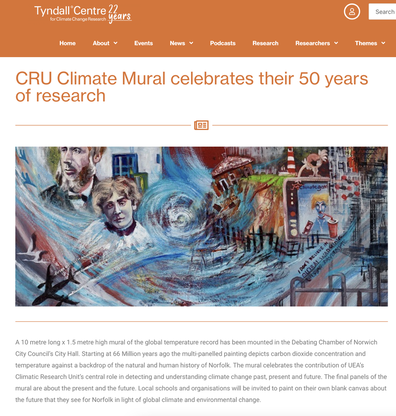
A 10 metre long x 1.5 metre high mural of the global temperature record has been mounted in the Debating Chamber of Norwich City Council’s City Hall. Starting at 66 Million years ago the multi-panelled painting depicts carbon dioxide concentration and temperature against a backdrop of the natural and human history of Norfolk. The mural celebrates the contribution of UEA’s Climatic Research Unit’s central role in detecting and understanding climate change past, present and future. The final panels of the mural are about the present and the future. Local schools and organisations will be invited to paint on their own blank canvas about the future that they see for Norfolk in light of global climate and environmental change.
Cold Regions Warming, Whyte Museum talk, November 17th 2022
The Crag & Canyon, Banff, 2 November 2022Keep finding some articles and advertising about exhibition in the local newspapers it’s nice. It makes a lot of interest to the exhibition.
2171 visitors since opened exhibition. Director Banff Museum Donna Livingston said, it’s very good for the shoulder time in Banff. Still not too many tourists around. The season just started. Usually, in December and winter times population in this region grows to 3-5 times. |
About 75 people came to the exhibition for a talk. It was great evening and it was nice to see so many people who is interested In the region problems. And for two weeks 2171 visitors!
|
Cold Regions Warming, Whyte Museum, Banff, October 2022-January 2023
Several web-sites and platforms advertising art-science exhibition |
Press release , For immediate release.
COLD REGIONS WARMING AND CONTEMPORARY CONSCIOUSNESS FALL EXHIBITIONS ON ENVIRONMENTAL ISSUES, OPEN AT THE WHYTE MUSEUM
OCTOBER 28TH, Banff, AB – October 7, 2022
|
On Friday, October 28th, 2022, the Whyte Museum of the Canadian Rockies will welcome new fall exhibitions with the opening of Cold Regions Warming and Contemporary Consciousness. Both exhibitions explore issues impacting our local and global environments while inspiring the viewer with a sense of advocacy and actionable change to take home.
Cold Regions Warming is an interdisciplinary collaboration of scientific fact and exquisite art between artist Gennadiy Ivanov, Global Water Futures, and scientists John Pomeroy and Trevor Davies. Contemporary Consciousness features the work of two Canadian artists, Alexandra Ewen and Joshua Jensen-Nagle, who explore impacts on our oceans and shores in contrasting ways. Please see the attached press release for further information on the exhibition opening and to request an interview. https://www.facebook.com/events/902759754445115?ref=newsfeed |
On Friday, October 28th, 2022, join the Whyte Museum of the Canadian Rockies for the opening of two fall exhibitions, Cold Regions Warming and Contemporary Consciousness, as we celebrate the research and artwork of Global Water Futures, scientists Trevor Davies and John Pomeroy, and artists Gennadiy Ivanoff, Alexandra Ewen, and Joshua Jensen-Nagle. Both exhibitions explore issues impacting our local and global environments while inspiring the viewer with a sense of advocacy and actionable change to take home.
“We are seeing the impact of dramatic changes in our environment every day,” says Whyte Museum CEO Donna Livingstone. “As a museum in a national park, in a World Heritage Centre, it’s important that we offer new ways of considering the global impacts on our landscape. We are grateful to be drawing on the knowledge and research of the Global Futures scientists and artists in opening this story.”
Cold Regions Warming is an interdisciplinary collaboration between artist Gennadiy Ivanov, Global Water Futures, and scientists John Pomeroy and Trevor Davies. Paintings, drawings, and videos depict locations in Canada where global warming has impacted glaciers, oceans, lakes, and rivers. Global Waters Futures is headquartered at the University of Saskatchewan in Saskatoon and aims to demonstrate global leadership in water science in colder regions.
Gennadiy V. Ivanov. Code Red for Peyto Glacier. 2021. Oil on canvas. 91 x 116 cm. Collection of the artist
From a scientific base, the group also addresses the needs of the national economy in adapting to change and managing the risks of uncertain water futures and extreme events. With the combination of scientific fact and exquisite art, the exhibition is designed to inform on various levels of appreciation.
Find more information on the event and to purchase tickets: www.whyte.org/events Facebook Event: https://fb.me/e/2otUsJeHg
To learn more about Whyte Museum exhibitions: www.whyte.org/exhibitions About Global Water Futures
Global Water Futures is a pan-Canadian research program that is funded in part by a $77.8-million grant from the Canada First Research Excellence Fund. The overarching goal of the program is to deliver risk management solutions - informed by leading-edge water science and supported by innovative decision-making tools - to manage water futures in Canada and other cold regions where global warming is changing landscapes, ecosystems, and the water environment.
Global Water Futures (GWF) aims to position Canada as a global leader in water science for cold regions and will address the strategic needs of the Canadian economy in adapting to change and managing risks of uncertain water futures and extreme events. End-user needs will be our beacon and will drive strategy and shape our science.
The UNESCO Chair in Mountain Water Sustainability was recently approved by UNESCO in Paris. This will be administratively based at the University of Calgary and Dr. John Pomeroy will serve as the principal chairholder at the University of Saskatchewan in Canmore.
“We consider the Whyte Exhibition “Cold Regions Warming” to be the first major activity of the new UNESCO Chair,” says Dr. Pomeroy. “We look forward to more collaborations in the future.”
Website
About the Whyte Museum of the Canadian Rockies
The Whyte Museum of the Canadian Rockies inspires discovery and wonder when people and the Rocky Mountains meet. Our founders Peter Whyte and Catharine (Robb) Whyte were local artists and philanthropists. Peter and Catharine wished to offer a place where people could gather and appreciate the culture and beauty of the area. Our programming is made possible through generous support from the Museum’s members, donors, and sponsors.
Facebook Twitter Instagram YouTube
Media Contacts
For more information or to request an interview, please contact:
Tera Swanson, Marketing and Communications Manager E: [email protected] T: 1-403-762-2291 (ext) 325
“We are seeing the impact of dramatic changes in our environment every day,” says Whyte Museum CEO Donna Livingstone. “As a museum in a national park, in a World Heritage Centre, it’s important that we offer new ways of considering the global impacts on our landscape. We are grateful to be drawing on the knowledge and research of the Global Futures scientists and artists in opening this story.”
Cold Regions Warming is an interdisciplinary collaboration between artist Gennadiy Ivanov, Global Water Futures, and scientists John Pomeroy and Trevor Davies. Paintings, drawings, and videos depict locations in Canada where global warming has impacted glaciers, oceans, lakes, and rivers. Global Waters Futures is headquartered at the University of Saskatchewan in Saskatoon and aims to demonstrate global leadership in water science in colder regions.
Gennadiy V. Ivanov. Code Red for Peyto Glacier. 2021. Oil on canvas. 91 x 116 cm. Collection of the artist
From a scientific base, the group also addresses the needs of the national economy in adapting to change and managing the risks of uncertain water futures and extreme events. With the combination of scientific fact and exquisite art, the exhibition is designed to inform on various levels of appreciation.
Find more information on the event and to purchase tickets: www.whyte.org/events Facebook Event: https://fb.me/e/2otUsJeHg
To learn more about Whyte Museum exhibitions: www.whyte.org/exhibitions About Global Water Futures
Global Water Futures is a pan-Canadian research program that is funded in part by a $77.8-million grant from the Canada First Research Excellence Fund. The overarching goal of the program is to deliver risk management solutions - informed by leading-edge water science and supported by innovative decision-making tools - to manage water futures in Canada and other cold regions where global warming is changing landscapes, ecosystems, and the water environment.
Global Water Futures (GWF) aims to position Canada as a global leader in water science for cold regions and will address the strategic needs of the Canadian economy in adapting to change and managing risks of uncertain water futures and extreme events. End-user needs will be our beacon and will drive strategy and shape our science.
The UNESCO Chair in Mountain Water Sustainability was recently approved by UNESCO in Paris. This will be administratively based at the University of Calgary and Dr. John Pomeroy will serve as the principal chairholder at the University of Saskatchewan in Canmore.
“We consider the Whyte Exhibition “Cold Regions Warming” to be the first major activity of the new UNESCO Chair,” says Dr. Pomeroy. “We look forward to more collaborations in the future.”
Website
About the Whyte Museum of the Canadian Rockies
The Whyte Museum of the Canadian Rockies inspires discovery and wonder when people and the Rocky Mountains meet. Our founders Peter Whyte and Catharine (Robb) Whyte were local artists and philanthropists. Peter and Catharine wished to offer a place where people could gather and appreciate the culture and beauty of the area. Our programming is made possible through generous support from the Museum’s members, donors, and sponsors.
Facebook Twitter Instagram YouTube
Media Contacts
For more information or to request an interview, please contact:
Tera Swanson, Marketing and Communications Manager E: [email protected] T: 1-403-762-2291 (ext) 325
Water News Online- Canadian Water Resources Association magazine Vol.41 | N.4
|
Transitions art-science window exhibition. 2-30 September 2022
Transitions art-science window exhibition now on!
Please come to Elm hill street, oldest Norwich street, to have a look a new paintings and drawings of the project. Also, some information about out Transitions team and expeditions to Canada. One of the painting (left side) touching the Norfolk coastal erosion problems, which is facing our region NOW! Its about Happisburgh beach which is crumbling very fast.
Second large painting based on my 3rd expedition to Canada this year and it calls 'It's a beetle-killed forest' about Jasper National Park in Alberta. Also you will see the original pastel drawing , which I have done during my trips to Canada in 2018 and 2022.
Please welcome and leave me some comments.
There is some QR-code which direct you to the Transitions project web-site and the Global Water Futures Transitions project.
Thanks to Professors John Pomeroy and Trevor Davies for support and such a great project! Very pleased, its happened and I hope will attract a lot of people from the city, city guests and tourists, also the art students and scientists.
Thanks to this family who gave me permission to exhibit this Transitions project on their window.
Please come to Elm hill street, oldest Norwich street, to have a look a new paintings and drawings of the project. Also, some information about out Transitions team and expeditions to Canada. One of the painting (left side) touching the Norfolk coastal erosion problems, which is facing our region NOW! Its about Happisburgh beach which is crumbling very fast.
Second large painting based on my 3rd expedition to Canada this year and it calls 'It's a beetle-killed forest' about Jasper National Park in Alberta. Also you will see the original pastel drawing , which I have done during my trips to Canada in 2018 and 2022.
Please welcome and leave me some comments.
There is some QR-code which direct you to the Transitions project web-site and the Global Water Futures Transitions project.
Thanks to Professors John Pomeroy and Trevor Davies for support and such a great project! Very pleased, its happened and I hope will attract a lot of people from the city, city guests and tourists, also the art students and scientists.
Thanks to this family who gave me permission to exhibit this Transitions project on their window.
The Yukon and Northwest Territories sign Bilateral Water Management agreements
Published 30/08/2022
|
3 mine paintings behind !
Wow. Very nice to read this an article. Very pleased to be a part such a great event. ‘Good Morning John and Gennadiy – we were able to set up the art in the venue. It is displayed in the large multi-purpose room of the Kwanlin Dun Cultural Centre where Ministers and delegates will be eating and mingling. But we also took the opportunity to use three of the pieces for a background photo opportunity during the signing of a bilateral water agreement between Yukon and NWT. Link below includes the photo with three pieces. The art has already been a great conversation starter! The Yukon and Northwest Territories sign Bilateral Water Management agreements The Government of Yukon signs water management agreements with the Government of Northwest Territories for the Peel and Liard river sub-basins. Read more: https://yukon.ca/.../yukon-and-northwest-territories-sign... Cheers, Heather’ |
Wolf Creek project produces groundbreaking research
|
Art in the Pub. @ Winterlong Brew Pub. Whitehorse, Canada, Summer 2022Our Transitions exhibition Conquers the space of Canada.
An Art-science Transitions project paintings from the first expedition guests can find and read captions at the Wintelong Brew Pub. It’s busy tourists time in Yukon and this paintings can tell the story of the climate change in this region , which facing a lot of problems this days like flooding and wildfires. Good to see it and thanks to the GWF , Professor Pomeroy and his students and technicians for organise it. Very proud. Latest news from the Yukon, Canada. 04.08.2022
From Professor Pomeroy: “Gennadiy. A great event on Wolf Creek. The Yukon Minister if Environment opened it and stayed. I have him a print of ‘Red Invasion of Wolf Creek’. It will hang in his office! Thank you for the art. It is changing the world for the better”. I want to say: great thanks for this and ‘invasion’ of our art-science project going to the right direction. |
|
I received the great response from Professor John Pomeroy and Yukon government to the Wolf Creek Research Basin event and the Art.
"Hello John, Sean and Erin – just wanted to send a quick note to thank you (and the team behind you!) again for the wonderful event out at the Wolf Creek campground yesterday. It was great to see so many people out enjoying the celebration: really interesting discussions with a nice mix of local residents, general public, staff and researchers. The food was amazing, the weather held … and the art was magnetic! On the art … it was definitely a highlight and a really great way to talk about climate change and water in the Yukon. Our Minister seemed to enjoy the event and was definitely happy to have received such a special piece of art. Again, I am so pleased that you are leaving pieces behind for the branch and I intend to share them with others within Yukon government as a way to share the work of GWF, the art of Gennadiy Ivanov, and most importantly, to remind our collective organization of how climate change is impacting our water/landscape." Heather Jirousek (she/her) Director Environment | Water Resources Branch I really want to say a big thanks to Professors John Pomeroy and Trevor Davies and his team of the great scientists and environmentalists for this opportunity to show our Transitions project artworks in Yukon, which helped to understand the problems not just in Canada , but with the climate around the world. We are have only one planet and all systems on the earth, like a human body, interconnected and interdependent. We MUST to look after our planet and help to regenerate and keep it safe for the future generations. |
NEW TRANSITIONS III CATALOGUE. MAY 2022. CANADA
Drama out of crisis. 2022-07-10 Norwich Arts centre
|
2022-07-10 Exhibition at the Norwich Art Centre. Publication at the 'Just Sprowston' , 9 Jul 2022.
Proud to be a part of the NEAC Annual Exhibition 23 June - 9th July 2022, London.
|
Proud to be a part of the NEAC Annual Exhibition 2022, London.
We're delighted to say that our 2022 Annual Exhibition is now OPEN! The show looks wonderful up on the walls and we encourage you to see it in person at Mall Galleries. We appreciate that travel is tricky this week, so the exhibition has been extended to 9 July to provide more opportunities to visit. The show also features a series of talks and demos by our member artists, and don't miss the NEAC Annual Lecture on 29 June. And of course, you can experience the show online in a variety of ways . . . Take a virtual tour: https://my.matterport.com/show/?m=6VjvQptw5KG |
artsPlace water exhibit blends science and art to create change. 2022-06-07 RMOTOTODAY.COM, BY ROCKY MOUNTAINS outlook
|
‘It’s a really friendly and clearly explained dialogue – and it came out when the CWRA meeting is in town so lots of exposure from residents, tourists and visiting scientists’- Professor Pomeroy.
“I hope people feel something when they see the artwork. I think it is one thing to read a scientific document that tells you about climate change and it is another thing to really feel what climate change is in your gut when you look at a painting. When people feel things, then that creates change in their life.”
CANMORE – Getting the message across on climate change can be a challenge, but the hope of the virtual water gallery is the blending of art and science can open the eyes of people to the natural world that is changing around us. “It was an amazing collaboration between artists and scientists who worked together during the pandemic to make works of art that expressed feelings and reactions to climate change,” said program director Nicole Fougere. “They document landscapes that are in transition right now.” The virtual water gallery launched in the summer of 2020 to bring together artists, water experts, knowledge keepers and the public to reflect on the challenges of climate change. Now, the Virtual Water Exhibit has transitioned into an in-person exhibition at artsPlace, running from May 21 to June 17. The move from a virtual exhibit to an in-person one was relatively easy for the gallery. “It is such a beautiful exhibit. It contains work by professional artists,” Fougere said. “It contains artwork by people who are scientists and artists, and it even has a section with artwork by children from the Bow Valley.” The goal of the exhibit was to bring individuals from different disciplines together to find solutions to the problems the world is facing. “The whole idea behind it is that it started as an online space in order to connect artists from across Canada, but also water experts from the Global Water Futures program,” said lead curator Louise Arnal, a postdoctoral fellow at the Centre for Hydrology. “The philosophy behind it is that we believe that sharing perspectives across communities of artists, Indigenous peoples, scientists and so on can really help us find solutions to the water challenges we are facing.” While science and art may seem like two disciplines that wouldn’t go together, the blending of the two can have a big impact on the individuals who experience the result. “People are more open to it now, and they are seeing the value of merging both worlds,” Arnal said. “It is at that interaction between the two worlds that new and creative and holistic ideas can emerge.” The blending of science and art can create a unique perspective that changes how a person views a situation, especially one as complex as climate change. “Scientists are sharing research using journal articles and participating in conferences, but these are for a portion of the population,” Arnal said. “Not everyone understands a scientific graph so being able to convey that through these collaborations and an artistic medium is a great way to bring this important information to a wider public.” The goal of the exhibit is to change the perspective of people, especially in a place like Canmore where residents can see the environmental changes first hand. Residents can now come and see in the exhibit what they are witnessing in their lives and how scientists are sharing their own visions of it. “I hope people feel something when they see the artwork. I think it is one thing to read a scientific document that tells you about climate change and it is another thing to really feel what climate change is in your gut when you look at a painting,” Fougere said. “When people feel things, then that creates change in their life.” After the exhibit opened, there was an immediate response from residents according to Arnal. “We are seeing the effects that this virtual water gallery is having on the local community,” Arnal said. “We got some fantastic feedback at the opening event, and this gives me hope that people living here are receptive to these events.” Visitors to the exhibit are also encouraged to fill out surveys that are funded through a government grant at artsPlace or online. These surveys monitor the changes of perspective to water challenges and climate change that the exhibit is causing. “Hopefully, that shows we are having a positive impact.” |
“Я надеюсь, что люди что-то почувствуют, когда увидят это произведение искусства. Я думаю, что одно дело читать научный документ, который рассказывает вам об изменении климата, и совсем другое - действительно чувствовать, что такое изменение климата, когда вы смотрите на картину. Когда люди что-то чувствуют, это приводит к переменам в их жизни”.
КЭНМОР. Донести информацию об изменении климата может быть непросто, но виртуальная водная галерея надеется, что сочетание искусства и науки может открыть людям глаза на мир природы, который меняется вокруг нас. “Это было удивительное сотрудничество между художниками и учеными, которые работали вместе во время пандемии, создавая произведения искусства, выражающие чувства и реакцию на изменение климата”, - сказала директор программы Николь Фужер. “Они документируют ландшафты, которые сейчас находятся в переходном периоде”. Виртуальная водная галерея была запущена летом 2020 года, чтобы объединить художников, экспертов по водным ресурсам, хранителей знаний и общественность для размышления о проблемах изменения климата. Теперь Виртуальная выставка воды превратилась в персональную выставку в artsPlace, которая продлится с 21 мая по 17 июня. Переход от виртуальной выставки к персональной для галереи был относительно легким. “Это такая красивая выставка. В нем представлены работы профессиональных художников”, - сказал Фужер. “Здесь собраны работы людей, которые являются учеными и художниками, и в нем даже есть раздел с работами детей из долины Боу”. Цель выставки состояла в том, чтобы объединить людей из разных дисциплин для поиска решений проблем, с которыми сталкивается мир. “Вся идея проекта заключается в том, что он начинался как онлайн-пространство для объединения художников со всей Канады, а также экспертов по водным ресурсам из Глобальной программы WaterFutures”, - сказала ведущий куратор Луиза Арнал, аспирант Центра гидрологии. ”Философия, лежащая в основе этого, заключается в том, что мы считаем, что обмен мнениями между сообществами художников, коренных народов, ученых и так далее действительно может помочь нам найти решения водных проблем, с которыми мы сталкиваемся". Хотя наука и искусство могут показаться двумя дисциплинами, которые не сочетаются друг с другом, их сочетание может оказать большое влияние на людей, которые испытывают результат. “Сейчас люди более открыты для этого, и они видят ценность слияния обоих миров”, - сказал Арнал. “Именно при таком взаимодействии между двумя мирами могут возникнуть новые, творческие и целостные идеи”. Сочетание науки и искусства может создать уникальную перспективу, которая меняет взгляд человека на ситуацию, особенно такую сложную, как изменение климата. “Ученые делятся исследованиями, используя журнальные статьи и участвуя в конференциях, но это для части населения”, - сказал Арнал. “Не все понимают научную графику, поэтому возможность донести это с помощью такого сотрудничества и художественной среды - отличный способ донести эту важную информацию до широкой общественности”. Цель выставки - изменить точку зрения людей, особенно в таком месте, как Кэнмор, где жители могут увидеть изменения в окружающей среде из первых рук. Теперь жители могут прийти и увидеть на выставке то, чему они стали свидетелями в своей жизни, и то, как ученые делятся своим собственным видением этого. “Я надеюсь, что люди что-то почувствуют, когда увидят это произведение искусства. Я думаю, что одно дело читать научный документ, который рассказывает вам об изменении климата, и совсем другое - действительно чувствовать, что такое изменение климата, когда вы смотрите на картину”, - сказал Фужер. “Когда люди что-то чувствуют, это приводит к переменам в их жизни”. По словам Арнала, после открытия выставки жители немедленно отреагировали на нее. “Мы видим, какое влияние оказывает эта виртуальная водная галерея на местное сообщество”, - сказал Арнал. “Мы получили несколько фантастических отзывов на открытии мероприятия, и это дает мне надежду, что люди, живущие здесь, восприимчивы к этим событиям”. Посетителям выставки также предлагается заполнить анкеты, которые финансируются за счет государственного гранта, на сайте artsPlace или онлайн. Эти опросы отслеживают изменения в отношении водных проблем и изменения климата, которые вызывает выставка. “Надеюсь, это показывает, что мы оказываем положительное влияние”. |
The Virtual Water Gallery exhibition @artsPlace Canmore, Canada, May 21-June 17, 2022
|
Incredibly busy opening night at the artsPlace Canmore VWG exhibition tonight. Lovely people, scientists and artists together. Just WOW. Thanks to the GWF Professor Pomeroy and Louise from the VWG for inviting me to be a part such a great and important project. @gwf_water #artscience #exhibition #canmore #artsplace #artscience
|
And some more photos from the Virtual Water Gallery exhibition in Canmore.
The Virtual Water Gallery presents an exhibit at artsPlace Canmore May 21 - June 17, 2022. This reception June 3 was the first time artists, scientists, Indigenous community members, and the public were able to come together. I wasn't to be able to visit reception in June, but seems like it was great! Nice to see my friends artists! What a lovely exhibition and achievement! Thank you Louise! Credits: Mark Ferguson Director of Communications Global Institute for Water Security Global Water Futures University of Saskatchewan |
Norwich eco-artist spreads climate change message through work. 07.11.2021An eco-artist says he wants to simplify the "complicated language" of science into art to spread the message of climate change. Gennadiy Ivanov, from Norwich, has just shown his work at COP26 in Glasgow. He said he wants to increase awareness of "retreating glaciers and floods" in places he has visited such as Canada.Art can deliver "everything about climate change, simpler, quicker and in a shocking way", he said.
"Ordinary people are sometimes not very interested in science - it can use very complicated, confusing language and boring graphs - so I'm trying to bring forward their message through visual art," said the painter, who is a Norfolk Arts Awards winner.He was at COP26 with Prof John Pomeroy, director of Global Water Futures at the University of Saskatchewan in Canada, and the University of East Anglia's Prof Trevor Davies, who he collaborates with. During the event, the artist, who Is originally from Russia, displayed eight pieces. "They told me this is the best simple exhibition that has told them more than any expensive display... that explains everything about climate change," he said. "Even some people who didn't believe in climate change, they have started to believe after seeing my work."I know it's important I must do this and I must say the truth and say what I feel." |
Cryosphere Pavilion COP26
|
|
|
|
folkfeatures.co.uk/making-art-matter-in-the-current-climate/#respondMaking art matter in the current climate November 3, 2021
Как художник из Бобруйска помогает спасать климат
С 31 октября по 12 ноября в шотландском Глазго проходит 26-я Конференция сторон Рамочной конвенции ООН по изменению климата (COP26). Участие в этом крупномасштабном форуме принимают более 100 руководителей государств и правительств из разных стран мира.
Главная цель конференции — возможность объединения разных стран для построения «зеленой» экономики и перехода к более чистым источникам энергии, масштабное сокращение выбросов для предотвращения серьезных климатических последствий. Рамочная конвенция ООН об изменении климата была принята 9 мая 1992 года и вступила в силу 21 марта 1994 года. В настоящее время участниками конвенции являются 196 стран и Евросоюз.
Участие в этом глобальном форуме принимает и наш земляк — художник Геннадий Иванов, ныне проживающий в британском Норидже. С ним мы пообщались по телефону сразу после открытия выставки его картин «Переходы», организованной в рамках конференции.
Геннадий Иванов уже несколько лет работает в уникальном новаторском партнерстве с канадским ученым-климатологом Джоном Помероем и британским ученым Тревором Дэвисом в рамках исследовательского проекта «Глобальное будущее воды», посвященного изменению климата. Это участие в научных экспедициях по изучению пресноводных ресурсов в арктических широтах Канады, которые подвержены самым высоким темпам потепления на планете.
— Меня привлекли к сотрудничеству, чтобы я как художник мог через изобразительное искусство донести проблемы изменения климата до широких кругов общественности, — отмечает Геннадий Иванов. — Катастрофические наводнения, засухи, изменения уровня воды в озерах и реках, лесные пожары, уменьшение ледяного покрова и быстрое таяние вечной мерзлоты. Мы работали на исследовательских площадках в Юконе, на Северо-Западных территориях, в Скалистых горах Альберты и Саскачеване. Передо мной стояла задача с помощью красок рассказать о невероятных пейзажах разрушаемой природы.
По словам Геннадия, интерес к теме изменения климата возник у него в 2017 году, когда он рисовал последствия эрозии почвы в прибрежной зоне Норфолка из-за поднявшегося уровня воды, заброшенные сельскохозяйственные угодья и покинутые дома.
— На конференции в Глазго представлены мои картины, сделанные в Канаде. Это работы маслом, пастели, на некоторые из них трудно смотреть, — говорит автор работ. — Думаю, что запечатленная художником реальность способна стать катализатором перемен. На конференции в Глазго я встретил представителей европейских молодежных организаций, блогеров и журналистов из Америки, Германии, Италии, Пакистана и Индии, студентов научной академии Королевского общества из Лондона, преподавателей американских университетов Аризоны и Массачусетса.
Геннадий Иванов рассказал, что в следующем году он планирует организовать выставку в Канаде. После презентации на COP26 он получил несколько приглашений принять участие в выставках в США, на Генеральной Ассамблее ООН в Нью-Йорке в следующем году и в штаб-квартире ЮНЕСКО в Париже, а также в Таджикистане и Индии.
Галина ЧИРУК
Фото предоставлено Геннадием ИВАНОВЫМ
https://komkur.info/obshchestvo/kak-khudozhnik-iz-bobrujska-pomogaet-spasat-klimatkomkur.info/obshchestvo/kak-khudozhnik-iz-bobrujska-pomogaet-spasat-klimat?fbclid=IwAR3S3_PCWzd6KrciYYq72e4yRFm851CDZ_UiSrtRiZ7KqFt1hIXObW6nHzY
Главная цель конференции — возможность объединения разных стран для построения «зеленой» экономики и перехода к более чистым источникам энергии, масштабное сокращение выбросов для предотвращения серьезных климатических последствий. Рамочная конвенция ООН об изменении климата была принята 9 мая 1992 года и вступила в силу 21 марта 1994 года. В настоящее время участниками конвенции являются 196 стран и Евросоюз.
Участие в этом глобальном форуме принимает и наш земляк — художник Геннадий Иванов, ныне проживающий в британском Норидже. С ним мы пообщались по телефону сразу после открытия выставки его картин «Переходы», организованной в рамках конференции.
Геннадий Иванов уже несколько лет работает в уникальном новаторском партнерстве с канадским ученым-климатологом Джоном Помероем и британским ученым Тревором Дэвисом в рамках исследовательского проекта «Глобальное будущее воды», посвященного изменению климата. Это участие в научных экспедициях по изучению пресноводных ресурсов в арктических широтах Канады, которые подвержены самым высоким темпам потепления на планете.
— Меня привлекли к сотрудничеству, чтобы я как художник мог через изобразительное искусство донести проблемы изменения климата до широких кругов общественности, — отмечает Геннадий Иванов. — Катастрофические наводнения, засухи, изменения уровня воды в озерах и реках, лесные пожары, уменьшение ледяного покрова и быстрое таяние вечной мерзлоты. Мы работали на исследовательских площадках в Юконе, на Северо-Западных территориях, в Скалистых горах Альберты и Саскачеване. Передо мной стояла задача с помощью красок рассказать о невероятных пейзажах разрушаемой природы.
По словам Геннадия, интерес к теме изменения климата возник у него в 2017 году, когда он рисовал последствия эрозии почвы в прибрежной зоне Норфолка из-за поднявшегося уровня воды, заброшенные сельскохозяйственные угодья и покинутые дома.
— На конференции в Глазго представлены мои картины, сделанные в Канаде. Это работы маслом, пастели, на некоторые из них трудно смотреть, — говорит автор работ. — Думаю, что запечатленная художником реальность способна стать катализатором перемен. На конференции в Глазго я встретил представителей европейских молодежных организаций, блогеров и журналистов из Америки, Германии, Италии, Пакистана и Индии, студентов научной академии Королевского общества из Лондона, преподавателей американских университетов Аризоны и Массачусетса.
Геннадий Иванов рассказал, что в следующем году он планирует организовать выставку в Канаде. После презентации на COP26 он получил несколько приглашений принять участие в выставках в США, на Генеральной Ассамблее ООН в Нью-Йорке в следующем году и в штаб-квартире ЮНЕСКО в Париже, а также в Таджикистане и Индии.
Галина ЧИРУК
Фото предоставлено Геннадием ИВАНОВЫМ
https://komkur.info/obshchestvo/kak-khudozhnik-iz-bobrujska-pomogaet-spasat-klimatkomkur.info/obshchestvo/kak-khudozhnik-iz-bobrujska-pomogaet-spasat-klimat?fbclid=IwAR3S3_PCWzd6KrciYYq72e4yRFm851CDZ_UiSrtRiZ7KqFt1hIXObW6nHzY
Glad to be nominated and to have the 2021 Norfolk Arts Award for my Transitions climate project
|
Winners of Norfolk arts award 2021 Revealed.
Wow. Looks fantastic. Thanks to Eloise O'Hare for drop me the EDP24 news paper. It will be a great memories for ever. https://www.edp24.co.uk/things-to-do/days-out/norfolk-arts-awards-2021-winners-8443728 |
Cold Regions Warming is an art-science perspective on climate change threats to the vast high latitude and high altitude cold regions of the world that provide freshwater to over half of humanity. Climate change causes increasing forest fire, thawing permafrost, melting glaciers, declining snow and ice cover, and more severe droughts and floods that are damaging the natural capital of the vast circumpolar and high mountain ecosystems and river basins that support our freshwater and oceans and therefore our lives, communities, wildlife, environment, and economies. A rescue will require the immediate mobilization of novel climate, human and water solutions for a great common endeavour, on a scale vastly exceeding that for any previous great cause in human history. Cold Regions Warming can help inspire this; based on Global Water Futures’ science and portraying the devastating impact of climate warming at research sites around the world, the art comprises pastels painted in the field, photographs, sound, music, videos and large oils of how climate change and water impacts are measured, and what these impacts are on the cryosphere. Coupled with the art-science presentations, it is suffused with the ambition that we can still ameliorate the very worst which, otherwise, is coming. the session will contribute to UNESCO’S 9TH Phase of IHP (2022-2029) “Science for a Water Secure World in a Changing Environment?
Organized by Global Water Futures/University of Saskatchewan and UNESCO.
Speakers: UNESCO Assistant Director General Dr. Shamila Nair-Bedouelle, Professor Trevor Davies, University of East Anglia, Artist Gennadiy Ivanov, Artist-in-Residence at Global Water Futures, Professor John Pomeroy, Director of Global Water Futures, University of Saskatchewan
Agenda:
Opening Comments
ICCI Representative 3 min
UNESCO Representative 4 min
Creative Connections for Climate and the Cryosphere
Prof Trevor Davies 4 mins
Making My Art Matter
Gennadiy Ivanov - 4 mins
The Message Behind the Art – Science Imperatives for the Cryosphere and Water Security
Prof John Pomeroy - 15 mins
http://iccinet.org/
COP26 Glasgow ,2021, paintings exhibition.
|
Oil on canvas painting, 60x80 cm, NFS. Prints available by order.
|
Norwich Cathedral artist-in-residence painting Dippy the dinosaur 26-29th July 2021
Four days incredible time as an artist in residence in the Norwich Cathedral. Three days oil painting and last day, today 29th, pastel drawing. Enjoyed the time , chat with people and kids, to hear so much impression from visitors. Always ‘wow-wow-wow’ !!! Great fun! Thanks to the Cathedral let me paint inside Dippy the dinosaur.
Pastel drawing on paper, 47x62 cm, NFS. Prints available by order.
|
2021-06-02 Setting up Transitions exhibition at the Undercroft gallery.
The Virtual Water Gallery site is UP now! https://www.virtualwatergallery.ca
Some screenshots from my the Virtual Water Gallery Launch presentation 29/04/2021
Dear Gennadiy,
You spoke well and your art was extremely powerful, more powerful due to your narrative. Thank you for doing this. We had close to 180 people on this and I am grateful that it went well. I think we will start to line up exhibitions now for post-pandemic world. Norwich, Glasgow, Banff, Saskatoon, Moscow and more!
It is a great honour to work with you.
Professor John Pomeroy, PhD, FRGS, FRSC
Canada Research Chair in Water Resources and Climate Change
Distinguished Professor, Dept. of Geography & Planning
Director:
CFREF Global Water Futures Programme
USask Centre for Hydrology
USask Coldwater Laboratory, Canmore, Alberta
University of Saskatchewan
Good afternoon,
Thank you all again so much for making the Virtual Water Gallery what it is today!
I am truly honoured to have shared this virtual watery journey with all of you!
The presentations today were of such high quality, we received some fantastic international feedback.
Thank you Chancellor McCreath and John for setting such a supportive scene for all of us to add our brushstrokes to!
And thank you to everyone working “behind the scenes” for being so engaged in making the gallery and the launch event happen!
In total, 275 people from 34 different countries registered to attend the launch event.
On the day, we had a 61% attendance rate.
169 (might be a bit more) attendees joined us virtually (not including the 16 panelists) from 15 different countries (lists of countries below).
This is a fantastic turnout!!!
Thank you all so much for promoting the event within your circles.
I also attach the launch event chat below.
The future may be grim in some respects.
But you’ve all shown the power of collaborations and of art-science initiatives to raise awareness and engagement, which will hopefully contribute to steering us towards a future we want to live in.
We will see what the future holds for us and this project.
I do certainly hope that our paths will cross non-virtually soon!
In the meantime, enjoy the gallery!
And please do let us know if you have any feedback on the gallery’s design and contents.
Thank you, merci!
Louise, Stacey, Martyn and John
Dear Gennadiy,
You spoke well and your art was extremely powerful, more powerful due to your narrative. Thank you for doing this. We had close to 180 people on this and I am grateful that it went well. I think we will start to line up exhibitions now for post-pandemic world. Norwich, Glasgow, Banff, Saskatoon, Moscow and more!
It is a great honour to work with you.
Professor John Pomeroy, PhD, FRGS, FRSC
Canada Research Chair in Water Resources and Climate Change
Distinguished Professor, Dept. of Geography & Planning
Director:
CFREF Global Water Futures Programme
USask Centre for Hydrology
USask Coldwater Laboratory, Canmore, Alberta
University of Saskatchewan
Good afternoon,
Thank you all again so much for making the Virtual Water Gallery what it is today!
I am truly honoured to have shared this virtual watery journey with all of you!
The presentations today were of such high quality, we received some fantastic international feedback.
Thank you Chancellor McCreath and John for setting such a supportive scene for all of us to add our brushstrokes to!
And thank you to everyone working “behind the scenes” for being so engaged in making the gallery and the launch event happen!
In total, 275 people from 34 different countries registered to attend the launch event.
On the day, we had a 61% attendance rate.
169 (might be a bit more) attendees joined us virtually (not including the 16 panelists) from 15 different countries (lists of countries below).
This is a fantastic turnout!!!
Thank you all so much for promoting the event within your circles.
I also attach the launch event chat below.
The future may be grim in some respects.
But you’ve all shown the power of collaborations and of art-science initiatives to raise awareness and engagement, which will hopefully contribute to steering us towards a future we want to live in.
We will see what the future holds for us and this project.
I do certainly hope that our paths will cross non-virtually soon!
In the meantime, enjoy the gallery!
And please do let us know if you have any feedback on the gallery’s design and contents.
Thank you, merci!
Louise, Stacey, Martyn and John
The gallery website: https://www.virtualwatergallery.ca
The Virtual Water Gallery presentation from 44.14 min.
|
|
Shrinking ice caps and glaciers could create water crisis, study finds
|
Creatively United Community / https://creativelyunited.org/event/the-power-of-visual-art/
|
https://creativelyunited.org/climate-artists-series/ Nice to be a part of the Creatively United Community. They are used to my painting 'THERE WAS THE GREEN FOREST' Next month I will give a talk 'The Power of Visual Art – Creative Solutions for a New World' Wednesday, October 14 @ 11:00 am - 12:00 pm Everyone welcome to be a part of this. |
Plein Air in Derbyshire Winster 20-23 July. landscape paintings by acrylic on canvas.
Creative Solutions For a New World / Climate Series
Creatively United for the Planet
Award-winning author; Chair of Water and Climate Security at the United Nations University Institute for Water, Environment and Health; and senior policy advisor, Bob Sandford, joins us again for a fascinating discussion with the much celebrated Dr. John Pomeroy, Canada Research Chair in Water Resources and Climate Change; Associate Director, Global Institute for Water Security; and Director of the Global Water Futures Program. Link to letter mentioned in the presentation: https://creativelyunited.org/enhanced... The effects of climate change are magnified in Canada’s North and other cold regions where global warming is changing landscapes, ecosystems and the water environments faster than any other region on Earth. The goal of the Global Water Futures Program is to forecast water futures and use leading edge science to deliver risk management solutions. Through this research, Canada will become a global leader in water science in cold regions and will address the strategic needs for the Canadian economy in adapting to change and managing risks associated with uncertain water futures and extreme events. This fascinating talk about water and the future of water by these leading experts is not to be missed!
Award-winning author; Chair of Water and Climate Security at the United Nations University Institute for Water, Environment and Health; and senior policy advisor, Bob Sandford, joins us again for a fascinating discussion with the much celebrated Dr. John Pomeroy, Canada Research Chair in Water Resources and Climate Change; Associate Director, Global Institute for Water Security; and Director of the Global Water Futures Program. Link to letter mentioned in the presentation: https://creativelyunited.org/enhanced... The effects of climate change are magnified in Canada’s North and other cold regions where global warming is changing landscapes, ecosystems and the water environments faster than any other region on Earth. The goal of the Global Water Futures Program is to forecast water futures and use leading edge science to deliver risk management solutions. Through this research, Canada will become a global leader in water science in cold regions and will address the strategic needs for the Canadian economy in adapting to change and managing risks associated with uncertain water futures and extreme events. This fascinating talk about water and the future of water by these leading experts is not to be missed!
Transitions exhibition at Canmore, Canada from 5th March 2020.
02/20/2020. Transitions exhibit combines science and art. Rocky Mountain Outlook Guide. p.42
Transitions exhibit combines science and art
CHELSEA KEMP
CANMORE– Melding science with art, a new progressive exhibit is set to take over Canmore to highlight the need for action in addressing the climate crisis.
The Transitions: Art-science Project on Climate Change exhibit has an opening reception at artsPlace on March 5 at 5:30 p.m.
“We have the ability to discuss as a community what climate change means, what it looks like and how it impacts all of us,” said Canmore’s arts and culture coordinator and co- curator Nicky Pacas. “This isn’t just a conversation about climate change— it’s how we understand the facts about it, how we can communicate that and how artwork is a really great medium for communicating ideas.”
Transitions is an on-going proj- ect between U.K. artist Gennadiy Ivanov, professor John Pomeroy of the University of Saskatchewan and the Canmore Cold Water Laboratory, and professor Trevor Davies of the University of East Anglia in the U.K. with Global Water Futures.
The trio has collaborated in com- pleting fieldwork exploring climate change and the exhibit fuses art and climate science to showcase the results.
“Gennadiy has been travelling with these professors and translating their sound scientific research through art- work,” Pacas said. “It gives an artistic visualization of climate change.”
The exhibit was made possible through a partnership between the Town of Canmore, Global Water
Futures and artsPlace. The Three pieces will be on display at the bigger,” she said, explaining that she
Sisters Gallery, the Civic Centre and artsPlace will feature Ivanov’s work along with 20 Bow Valley artists.
Pacas said she is grateful local artists are so willing to engage and participate in the show.
“We feel really lucky,” Pacas said. “They can talk about climate change from their perspective, from their home in their area in a really intimate space.”
Transitions was a great fit for Canmore, she added, because a lot of the landscapes Ivanov has been look- ing at and learning about are from the Bow Valley area and are featured in his works.
“Canmore seems like a great place to have this conversation as we have a community that is highly engaged with our changing climate,” Pacas said, adding that Transitions became an especially meaningful exhibit to host because Canmore council declared a climate emergency in 2019. “Art has this ability without statistics or words necessary to give us another way of thinking about these things.”
Artist and co-curator Pascale Ouellet said it was important to bring Transitions to Canmore because the town is already seeing the effects of the climate crisis first-hand.
The subject is often a divisive problem that puts people in two camps, she said, where they deny the problem versus those who are extremely concerned about the lasting ramifications.“It’s not a subject that has a grey shade, it’s black or white,” Ouellet said. She added she appreciates thatCanmore Civic Centre because it is a place of change.“It’s so relevant that’s where all the decisions are being made,” Ouellet said, explaining that it serves as the perfect reminder to not give up on fighting the climate crisis.Ouellet said it is exciting to be involved because Bow Valley artists have contributed work to the exhibit. She added that she was overwhelmed at the response from the community.“It’s something everybody wants to be apart of,” Ouellet said. “There’s very exciting art for the show.”Climate change is an important subject to tackle, Ouellet said, so she took a different approach to creating the show and met and discussed what the subject means to artists and how that could be presented to audiences.Transitions has proven to be a rewarding creative outlook, Ouellet said, serving as a platform for artists to get together and learn from each other.“Everybody has something to say and I enjoy that,” Ouellet said. “We have great visuals for the show.”It is inspiring to hear the artist’s motivation and research behind pieces that will be part of the show, she said, as well as the different perspectives that were taken in the process of creation.Ouellet added she hopes the show has the potential to return to the town as an annual exhibit because climate change is “a subject that will never grow old.”“This is a baby step towards some- thing that could become so muchhopes to see the exhibit grow and continue each year.Art is a universal language, Ouellet added, explaining that anyone can respond to what they see based on their life experience while encourag- ing people to explore outside their comfort zone.“It’s a good way to meet and talk about things that we may not want to talk about,” Ouellet said. “Especially for a difficult subject like the climate crisis.”ArtsPlace program manager Nicole Fougère said Transitions has proven to be a great opportunity to partner with the Town and help an important exhibit “come to life across the community.”Artists by their very nature are change-makers, she said, and art has a way of touching the deepest parts of identity.Transitions will help people expe- rience cutting edge science deeply through the unique perspective of art, she said.Science and art complement each other, Fougère explained, because both are “disciplines of innovations and invite risk-taking and big picture thinking and dreaming,” and the show will embody that principle.“I hope they [visitors] understand that change needs to happen fast,” Fougère said, adding that she hopes people are inspired to take action and do what is needed to help change their ways to ensure the planet is viable for future generations.Transitions: Art-science Project on Climate Change runs until April 2.
CHELSEA KEMP
CANMORE– Melding science with art, a new progressive exhibit is set to take over Canmore to highlight the need for action in addressing the climate crisis.
The Transitions: Art-science Project on Climate Change exhibit has an opening reception at artsPlace on March 5 at 5:30 p.m.
“We have the ability to discuss as a community what climate change means, what it looks like and how it impacts all of us,” said Canmore’s arts and culture coordinator and co- curator Nicky Pacas. “This isn’t just a conversation about climate change— it’s how we understand the facts about it, how we can communicate that and how artwork is a really great medium for communicating ideas.”
Transitions is an on-going proj- ect between U.K. artist Gennadiy Ivanov, professor John Pomeroy of the University of Saskatchewan and the Canmore Cold Water Laboratory, and professor Trevor Davies of the University of East Anglia in the U.K. with Global Water Futures.
The trio has collaborated in com- pleting fieldwork exploring climate change and the exhibit fuses art and climate science to showcase the results.
“Gennadiy has been travelling with these professors and translating their sound scientific research through art- work,” Pacas said. “It gives an artistic visualization of climate change.”
The exhibit was made possible through a partnership between the Town of Canmore, Global Water
Futures and artsPlace. The Three pieces will be on display at the bigger,” she said, explaining that she
Sisters Gallery, the Civic Centre and artsPlace will feature Ivanov’s work along with 20 Bow Valley artists.
Pacas said she is grateful local artists are so willing to engage and participate in the show.
“We feel really lucky,” Pacas said. “They can talk about climate change from their perspective, from their home in their area in a really intimate space.”
Transitions was a great fit for Canmore, she added, because a lot of the landscapes Ivanov has been look- ing at and learning about are from the Bow Valley area and are featured in his works.
“Canmore seems like a great place to have this conversation as we have a community that is highly engaged with our changing climate,” Pacas said, adding that Transitions became an especially meaningful exhibit to host because Canmore council declared a climate emergency in 2019. “Art has this ability without statistics or words necessary to give us another way of thinking about these things.”
Artist and co-curator Pascale Ouellet said it was important to bring Transitions to Canmore because the town is already seeing the effects of the climate crisis first-hand.
The subject is often a divisive problem that puts people in two camps, she said, where they deny the problem versus those who are extremely concerned about the lasting ramifications.“It’s not a subject that has a grey shade, it’s black or white,” Ouellet said. She added she appreciates thatCanmore Civic Centre because it is a place of change.“It’s so relevant that’s where all the decisions are being made,” Ouellet said, explaining that it serves as the perfect reminder to not give up on fighting the climate crisis.Ouellet said it is exciting to be involved because Bow Valley artists have contributed work to the exhibit. She added that she was overwhelmed at the response from the community.“It’s something everybody wants to be apart of,” Ouellet said. “There’s very exciting art for the show.”Climate change is an important subject to tackle, Ouellet said, so she took a different approach to creating the show and met and discussed what the subject means to artists and how that could be presented to audiences.Transitions has proven to be a rewarding creative outlook, Ouellet said, serving as a platform for artists to get together and learn from each other.“Everybody has something to say and I enjoy that,” Ouellet said. “We have great visuals for the show.”It is inspiring to hear the artist’s motivation and research behind pieces that will be part of the show, she said, as well as the different perspectives that were taken in the process of creation.Ouellet added she hopes the show has the potential to return to the town as an annual exhibit because climate change is “a subject that will never grow old.”“This is a baby step towards some- thing that could become so muchhopes to see the exhibit grow and continue each year.Art is a universal language, Ouellet added, explaining that anyone can respond to what they see based on their life experience while encourag- ing people to explore outside their comfort zone.“It’s a good way to meet and talk about things that we may not want to talk about,” Ouellet said. “Especially for a difficult subject like the climate crisis.”ArtsPlace program manager Nicole Fougère said Transitions has proven to be a great opportunity to partner with the Town and help an important exhibit “come to life across the community.”Artists by their very nature are change-makers, she said, and art has a way of touching the deepest parts of identity.Transitions will help people expe- rience cutting edge science deeply through the unique perspective of art, she said.Science and art complement each other, Fougère explained, because both are “disciplines of innovations and invite risk-taking and big picture thinking and dreaming,” and the show will embody that principle.“I hope they [visitors] understand that change needs to happen fast,” Fougère said, adding that she hopes people are inspired to take action and do what is needed to help change their ways to ensure the planet is viable for future generations.Transitions: Art-science Project on Climate Change runs until April 2.
|
Небольшая заметка о моем проекте в газете "Коммерческий Курьер" за 29 января 2020, Большое спасибо газете и Галине Чирук за поддержку! A small article in the Belarus Bobruisk news paper about Transitions project , Great thanks to Galina Chiruk and the Bobruisk news paper for support! |
Professor Pomeroy talk at COP25 in Madrid today, Wed 11th 2019. Very pleased and proud, what he shoved my paintings and mentioned my name in an important programme in the end. Great speech! Shocking and impressive!
|
Canada falling short of U.N.’s Sustainable Development Goals: New Report from Water Scientists
HAMILTON, ON.—Canada could lead the world in helping to achieve water sustainability but is falling short of reaching the goals set out by the United Nations (U.N.), according to a new report from scientists with the University of Saskatchewan-led Global Water Futures (GWF) program. The report, entitled Water Futures for the World We Want, takes aim at areas where the country is lacking in water resource management and scientific research, and outlines several recommendations for Canada to meet the 2030 goals outlined by the U.N. “As a proud partner of UNESCO and the U.N. Water Action Decade, we are continuously looking at ways in which we can lead the country in meeting our sustainable development goals as they relate to water,” said John Pomeroy, USask’s Canada Research Chair in Water Resources and Climate Change and GWF program director. “Canada could be a world leader on this issue, but we have to transform how we observe, predict and manage water to meet these goals and then share our solutions globally. This is a fitting role for Canada as a world leader in freshwater and hydrological science.” The report—released Nov. 19th in Hamilton, Ontario where 100 of Canada’s leading water scientists are gathered for a national GWF meeting—cites examples of shortcomings such as inadequate access to clean drinking water on First Nations (even when drinking water advisories are eliminated), declining water quality in lakes, rivers and streams across Canada, lack of wastewater treatment in parts of Canada, and severely stressed river basins such as the South Saskatchewan River where water extraction reaches very high levels in dry periods. As well, the report also highlights an absence of fully integrated co-operation between provinces and with the federal government on trans-boundary water issues. Canada, along with 192 other nations, committed to ensuring sustainability of water resources through its official adoption of the U.N. Sustainable Development Goals (SDGs). Collectively, these goals represent a roadmap towards a more resilient, just, and equitable society. While only one of the 17 SDGs (#6) is explicitly dedicated to achieving progress on water issues such as drinking water access, wastewater, pollution, and transboundary water resources management, a total of 40 targets across the other 16 goals are related to water. “If we are to show the world how to achieve water sustainability, Canada first needs to get our own house in order to achieve the water goal SDG #6,” said Dr. Corinne Schuster-Wallace, professor of water-related human health in the USask geography and planning department and co-author of the report. “Canada still has not reached universal access to reliable, potable water supplies. While the commitment to eliminating drinking water advisories in First Nation communities will go a long way to achieving this, many more aren’t even served by water treatment systems.” According to this and several other recent reports, Canada is also on the front line of rapid climate change, with temperatures warming at more than twice the global average and three times the global average in Canada’s North. “Catastrophic water-related experiences such as increasing frequency and severity of floods, drought, wildfires, and toxic algae blooms are creeping threats that undermine our quality of life, health, and safety,” said Bob Sandford, co-author of the report and EPCOR Chair in Water and Climate Security, United Nations University – Institute for Water, Environment and Health, which is hosted at McMaster University in Canada. “They also cost our economy big time, and those costs are rising.” Canada’s Parliamentary Budget Officer has said that the costs associated with reimbursing provinces and territories for natural disaster relief costs have increased by 660 per cent between 1970 and 2014, to an average annual cost of $410 million. The cost from extreme events between 2000 and 2017 exceeds $28 billion. “These estimates are overwhelmingly conservative given the inability to account for losses of life and homes, and the impacts on our consequent physical and mental health,” said Sandford. “Together, all of these issues conspire to threaten Canada’s own water sustainability.” The authors based their findings on an analysis of recent reports related to SDG targets, progress, and national and international challenges, along with GWF project reports and activities. With 39 GWF water research projects being conducted by hundreds of researchers from 18 universities across Canada, the report is a research-focussed look at the country’s current standing as it relates to the U.N.’s SDGs to date. “There are significant long-term benefits at stake, including the enhanced health and wellbeing of current and future generations, as well as expanded economic opportunity,” said Schuster-Wallace. “Ultimately, we have an opportunity beginning at the community level to help create a more just, equitable, and sustainable world for all. The alternative is, quite simply, unthinkable.” About the GWF report: The complete report—Water Futures for the World We Want: Opportunities for research, practice, and leadership in achieving SDG #6—is available online along with an executive summary, recommendations, graphics, and supplementary information on the website: www.gwf.usask.ca/sdgreport About USask-led Global Water Futures: The world's largest university-led freshwater research program, Global Water Futures is a seven-year, University of Saskatchewan-led research program established in 2016 and funded in part by a $77.8-million grant from the Canada First Research Excellence Fund to USask’s Global Institute for Water Security. The GWF research goal is to transform the way communities, governments and industries in Canada and other cold regions of the world prepare for and manage increasing water-related threats. The program is developed and funded in part with three key partners--the University of Waterloo, McMaster University, and Wilfrid Laurier University—and includes hundreds of faculty, researchers and support staff, hundreds of partners, and 18 Canadian universities. www.globalwaterfutures.ca For more information, contact: Mark Ferguson University of Saskatchewan GWF Communications 306-222-6915 [email protected] |
Dear GWF investigators, researchers, students, partners, stakeholders, and friends,
Global Water Futures (GWF) has just reached three years since its launch in September 2016. As 2019 has brought us exceptionally extreme impacts of climate change and developmental impacts on water, it is a good time to take stock of recent progress in GWF and our plans for the future. The tremendous skill, excitement, determination and drive of GWF researchers is certainly needed as Canada and the world grapple with a global water crisis. The coupled climate and water crises threaten the very fabric of our society and the integrity of our ecosystems.
Dr. John Pomeroy speaking at the Water Security for Canadians Workshop in Ottawa
Addressing these interlinked crises means that we need to solve water problems using novel approaches that draw upon both western science and traditional knowledge. To this end, GWF has six newly active Indigenous community water research projects, each of which was co-created and is co-led by an Indigenous investigator and a GWF university co-principal investigator. Adding to GWF’s 39 science projects and six core teams are several new Affiliated Projects from across Canada and around the world that bring greater strength and diversity to GWF. All are warmly welcomed.
Our remarkable 425-page Annual Progress Report is now complete and online – a big thank you to the GWF Secretariat led by Dr. Phani Adapa in producing this remarkable report and to all of you for contributing material for it. GWF continues to be the largest and most highly-cited water research program in the world. Over the past year, GWF members published 314 peer-reviewed journal articles, delivered 607 conference presentations, presented 192 invited, plenary and keynote lectures, published six books and book chapters, and published 54 other articles. In addition, 44 graduate and undergraduate theses were completed during this period. This is a superb record of research achievement and dissemination of scientific information across the world.
GWF has three formal seminar series as well as ad hoc seminars at the four partner universities – they are videoed and made available to the broader GWF community. Presented by the USask Global Institute for Water Security, The Distinguished Lecture Series is running now through October on Wednesday afternoons, bringing in top lecturers on breakthroughs in water security research. The Women and Water Lecture Series, in collaboration with the GWF Young Professionals group, will continue to inspire all scientists and promote greater gender equity in science. The second season of the Women and Water Lecture Series will run again this winter. Both of these series are recorded and broadcast live to all GWF researchers. The Knowledge Mobilization Webinar Series is running now and shares examples of successful initiatives in action, and discusses and troubleshoots common challenges that arise in KM across GWF.
Our remarkable 425-page Annual Progress Report is now complete and online – a big thank you to the GWF Secretariat led by Dr. Phani Adapa in producing this remarkable report and to all of you for contributing material for it. GWF continues to be the largest and most highly-cited water research program in the world. Over the past year, GWF members published 314 peer-reviewed journal articles, delivered 607 conference presentations, presented 192 invited, plenary and keynote lectures, published six books and book chapters, and published 54 other articles. In addition, 44 graduate and undergraduate theses were completed during this period. This is a superb record of research achievement and dissemination of scientific information across the world.
GWF has three formal seminar series as well as ad hoc seminars at the four partner universities – they are videoed and made available to the broader GWF community. Presented by the USask Global Institute for Water Security, The Distinguished Lecture Series is running now through October on Wednesday afternoons, bringing in top lecturers on breakthroughs in water security research. The Women and Water Lecture Series, in collaboration with the GWF Young Professionals group, will continue to inspire all scientists and promote greater gender equity in science. The second season of the Women and Water Lecture Series will run again this winter. Both of these series are recorded and broadcast live to all GWF researchers. The Knowledge Mobilization Webinar Series is running now and shares examples of successful initiatives in action, and discusses and troubleshoots common challenges that arise in KM across GWF.
The GWF 2nd Annual Science Meeting in Saskatoon was attended by 600 people
GWF benefits greatly from the GWF Young Professionals who stimulate the interaction, inclusion and participation of students and early career researchers in a variety of activities. An upcoming event that the GWF YP are helping to organise is the McMaster Water Week Research Showcase for Nov. 1. Such an event is highly recommended and reflects well on the students and faculty at McMaster for showing such water leadership.
On Mar. 22, GWF and the GWF YP helped to organize World Water Day events under the theme of “Leaving No One Behind” in Saskatoon, Waterloo, Hamilton and Canmore to celebrate the start of the seasonal acceleration of the hydrological cycle and to review water research at our institutions. USask’s Jay Famiglietti extended this to Washington, DC by contributing a keynote for events at the Pew Center. Congratulations on such (inter)national reach on World Water Day.
GWF partnered with the Forum for Leadership on Water, the Centre for Indigenous Environmental Resources, the POLIS Program on Ecological Governance and the UN University to convene a national discussion on water security at the Rideau Club in Ottawa on April 11th – Water Security for Canadians: Solutions for Canada’s Water Crisis. This event brought together water and climate scientists, policy experts, legislators, and water decision rightsholders and stakeholders. Panelists discussed the scientific evidence of the worsening water sustainability and climate-related water crisis in Canada, and the science and policy solutions needed to adapt to the new climate and water realities across the country. The discussion explored how to create a better, safer and more secure water world for ourselves and for our children, while positioning Canada as an international leader in global water security.
The GWF 2nd Annual Open Science Meeting in May in Saskatoon was a great success with close to 600 attendees, making it one of the largest water science meetings in Canadian history. Part of that meeting was at the spectacular and historic Wanuskewin Heritage Park where we learned about Indigenous water issues and engaged in cultural learning activities. Three keynotes from USA, UK and Germany on water and climate, ecosystems and water quality, and human dimensions, keynote talks from Chief Bobby Cameron of the Federation of Sovereign Indigenous Nations, President David Grimes of the World Meteorological Organisation, and Scott White, editor of The Conversationand a public talk by Professor Helen Baulch on Prairie water issues and challenges provided excellent, high level plenary sessions for the meeting. There were superbly run parallel sessions, poster sessions, lightening talks and opportunities for networking that showed the great advances being made in GWF, especially by our young professionals.
On Mar. 22, GWF and the GWF YP helped to organize World Water Day events under the theme of “Leaving No One Behind” in Saskatoon, Waterloo, Hamilton and Canmore to celebrate the start of the seasonal acceleration of the hydrological cycle and to review water research at our institutions. USask’s Jay Famiglietti extended this to Washington, DC by contributing a keynote for events at the Pew Center. Congratulations on such (inter)national reach on World Water Day.
GWF partnered with the Forum for Leadership on Water, the Centre for Indigenous Environmental Resources, the POLIS Program on Ecological Governance and the UN University to convene a national discussion on water security at the Rideau Club in Ottawa on April 11th – Water Security for Canadians: Solutions for Canada’s Water Crisis. This event brought together water and climate scientists, policy experts, legislators, and water decision rightsholders and stakeholders. Panelists discussed the scientific evidence of the worsening water sustainability and climate-related water crisis in Canada, and the science and policy solutions needed to adapt to the new climate and water realities across the country. The discussion explored how to create a better, safer and more secure water world for ourselves and for our children, while positioning Canada as an international leader in global water security.
The GWF 2nd Annual Open Science Meeting in May in Saskatoon was a great success with close to 600 attendees, making it one of the largest water science meetings in Canadian history. Part of that meeting was at the spectacular and historic Wanuskewin Heritage Park where we learned about Indigenous water issues and engaged in cultural learning activities. Three keynotes from USA, UK and Germany on water and climate, ecosystems and water quality, and human dimensions, keynote talks from Chief Bobby Cameron of the Federation of Sovereign Indigenous Nations, President David Grimes of the World Meteorological Organisation, and Scott White, editor of The Conversationand a public talk by Professor Helen Baulch on Prairie water issues and challenges provided excellent, high level plenary sessions for the meeting. There were superbly run parallel sessions, poster sessions, lightening talks and opportunities for networking that showed the great advances being made in GWF, especially by our young professionals.
GWF Artist in Residence Gennadiy Ivanov at Peyto Glacier, Banff
This summer, exhibitions of science and art reflecting some of GWF’s science and observatories were held in England and Belarus. “Transitions” is a transdisciplinary collaboration of GWF with UK-based artist Gennadiy Ivanov and Professor Trevor Davies (Univ. of East Anglia) . So far the project has focused on GWF sites in western and northern Canada. A magazine describing some of Mr. Ivanov’s first set of photographs, sketches, and paintings can be found here. Our hope is that this collaboration can take the science message from GWF and convey it in ways not possible with graphs and scientific papers. If you would like to collaborate on this project please contact me.
As I write this, a team from the GWF Strategic Management Committee is in Bengaluru, India for Future Earth’s WaterFuture Conference “Towards a Sustainable Water Future” of which GWF is a partner. We are providing a session on “Climate Impacts on Global Mountain Water Security”, several talks on knowledge mobilization and sustainable development goals and water and a plenary talk on “Losing our Cool: Water Predictions for the Warming Cold Regions”. We intend to work with scientists from India and elsewhere to promote global water security and help to address the acute water crisis that is evolving in the Indian sub-continent. Next are our scientific contributions to the World Meteorological Organisation for its High Mountain Summit in Geneva later in October and the Arctic Earth Systems Modelling Workshop in Reykjavik, later in November.
It is an honour to be involved with such talented and brilliant scientists, to have strong support from the Canada First Research Excellence Fund and our funding partners and to have such superb administrative and institutional support that keeps GWF running. GWF has become a remarkable, unprecedented movement that is working out the very challenging solutions for the water crisis, both at home and abroad. We need to “keep going” to show how humanity can improve its water future. The need for this has never been greater.
Professor John Pomeroy, FRSC
Canada Research Chair in Water Resources and Climate Change
As I write this, a team from the GWF Strategic Management Committee is in Bengaluru, India for Future Earth’s WaterFuture Conference “Towards a Sustainable Water Future” of which GWF is a partner. We are providing a session on “Climate Impacts on Global Mountain Water Security”, several talks on knowledge mobilization and sustainable development goals and water and a plenary talk on “Losing our Cool: Water Predictions for the Warming Cold Regions”. We intend to work with scientists from India and elsewhere to promote global water security and help to address the acute water crisis that is evolving in the Indian sub-continent. Next are our scientific contributions to the World Meteorological Organisation for its High Mountain Summit in Geneva later in October and the Arctic Earth Systems Modelling Workshop in Reykjavik, later in November.
It is an honour to be involved with such talented and brilliant scientists, to have strong support from the Canada First Research Excellence Fund and our funding partners and to have such superb administrative and institutional support that keeps GWF running. GWF has become a remarkable, unprecedented movement that is working out the very challenging solutions for the water crisis, both at home and abroad. We need to “keep going” to show how humanity can improve its water future. The need for this has never been greater.
Professor John Pomeroy, FRSC
Canada Research Chair in Water Resources and Climate Change
|
|
|
Exhibition at The Forum in Norwich looks at the impact of climate change
PUBLISHED: 18:53 25 July 2019 | UPDATED: 08:34 26 July 2019
Artist links with scientists to tell climate change story Exhibit at Norwich Cathedral a communication of science and art from Canada and the UK.
MARK FERGUSON
Jul 17, 2019

NORWICH - What does climate change look like?
For U.K.-based artist Gennadiy Ivanov, answering that question has become part of his life’s work.
Ivanov said he was Inspired to create after a series of expeditions and collaborations with two renowned climate scientists, where they traveled to the shrinking home of the polar bear, the receding landscape of large glaciers, even the melting ground where permafrost once existed.
“I’m trying to find my own approach to communicate this change with the public,” said Ivanov, an accomplished artist who grew up in Belarus and now makes his home in Norwich. “I wanted to connect with scientists to do it the right way and to see what they were seeing.”
It was his connection with Dr. Trevor Davies, professor emeritus with the School of Environmental Sciences at the University of East Anglia in Norwich, and Dr. John Pomeroy, director of the Global Water Futures program and Canada Research Chair in Water Resources and Climate Change at the University of Saskatchewan, that led Ivanov on a journey to see some of the most extreme examples of climate change, both at home and abroad.
“I believe that I can start an effective dialogue on the subject through an exhibition of paintings,” said Ivanov. “I am now producing on an iconic symbol of the Earth system’s vulnerability to climate change. I see this vulnerability close to my home in East Anglia. I see it in Canada.”
Davies and Ivanov examined the nearby Norfolk coastline – where erosion and rising water levels are having a profound effect.
“It’s important to me that this project has excellent science,” said Davies. “Ivanov sees science in a visual way, and where we live now there are big floods and a lot of coastal erosion. The change is clear, and Ivanov is doing his part to share this story through art. It’s really incredible.”
Ivanov accompanied Pomeroy on a cross-Canada expedition in the spring of 2019 to see the effect climate change is having on colder regions.
During the expedition, Ivanov visited renowned research sites where he saw huge mountain glaciers receding at record rates, melting permafrost in Canada’s north where warming is happening three times faster than the global average, and a research site at Wolf Creek in the Yukon Territory where snow was melting earlier than ever before.
“The snow at Wolf Creek has never melted before April, and we have records going back to the early 1900s,” said Pomeroy of the site. “It’s incredible how fast everything is changing.”
Pomeroy was delighted to have Ivanov reach out to him in an attempt to find new ways to communicate with the public. He said watching Ivanov create sketches, paintings, videos and even music on the nature of climate change has been inspiring.
“Art is such a powerful way to show the world what is happening,” said Pomeroy. “As a scientist, I am always looking for new ways to share research, and what he has created is beautiful and terrifying – a great conversation starter.”
Through July 29, Ivanov’s interpretations through art are on display at The Hostry, Norwich Cathedral in an exhibit entitled Climate Change: Impacts in Norfolk and Canada. Davies, Pomeroy and Ivanov will all be in attendance at the gallery and available for interviews between July 17 – 18.
-30-
For more information or to arrange interviews, please contact:
Mark Ferguson
Communications Specialist
Global Institute for Water Security
University of Saskatchewan
+1 306 222 6915
[email protected]
water.usask.ca | globalwaterfutures.ca
Gennadiy Ivanov
Artist
For U.K.-based artist Gennadiy Ivanov, answering that question has become part of his life’s work.
Ivanov said he was Inspired to create after a series of expeditions and collaborations with two renowned climate scientists, where they traveled to the shrinking home of the polar bear, the receding landscape of large glaciers, even the melting ground where permafrost once existed.
“I’m trying to find my own approach to communicate this change with the public,” said Ivanov, an accomplished artist who grew up in Belarus and now makes his home in Norwich. “I wanted to connect with scientists to do it the right way and to see what they were seeing.”
It was his connection with Dr. Trevor Davies, professor emeritus with the School of Environmental Sciences at the University of East Anglia in Norwich, and Dr. John Pomeroy, director of the Global Water Futures program and Canada Research Chair in Water Resources and Climate Change at the University of Saskatchewan, that led Ivanov on a journey to see some of the most extreme examples of climate change, both at home and abroad.
“I believe that I can start an effective dialogue on the subject through an exhibition of paintings,” said Ivanov. “I am now producing on an iconic symbol of the Earth system’s vulnerability to climate change. I see this vulnerability close to my home in East Anglia. I see it in Canada.”
Davies and Ivanov examined the nearby Norfolk coastline – where erosion and rising water levels are having a profound effect.
“It’s important to me that this project has excellent science,” said Davies. “Ivanov sees science in a visual way, and where we live now there are big floods and a lot of coastal erosion. The change is clear, and Ivanov is doing his part to share this story through art. It’s really incredible.”
Ivanov accompanied Pomeroy on a cross-Canada expedition in the spring of 2019 to see the effect climate change is having on colder regions.
During the expedition, Ivanov visited renowned research sites where he saw huge mountain glaciers receding at record rates, melting permafrost in Canada’s north where warming is happening three times faster than the global average, and a research site at Wolf Creek in the Yukon Territory where snow was melting earlier than ever before.
“The snow at Wolf Creek has never melted before April, and we have records going back to the early 1900s,” said Pomeroy of the site. “It’s incredible how fast everything is changing.”
Pomeroy was delighted to have Ivanov reach out to him in an attempt to find new ways to communicate with the public. He said watching Ivanov create sketches, paintings, videos and even music on the nature of climate change has been inspiring.
“Art is such a powerful way to show the world what is happening,” said Pomeroy. “As a scientist, I am always looking for new ways to share research, and what he has created is beautiful and terrifying – a great conversation starter.”
Through July 29, Ivanov’s interpretations through art are on display at The Hostry, Norwich Cathedral in an exhibit entitled Climate Change: Impacts in Norfolk and Canada. Davies, Pomeroy and Ivanov will all be in attendance at the gallery and available for interviews between July 17 – 18.
-30-
For more information or to arrange interviews, please contact:
Mark Ferguson
Communications Specialist
Global Institute for Water Security
University of Saskatchewan
+1 306 222 6915
[email protected]
water.usask.ca | globalwaterfutures.ca
Gennadiy Ivanov
Artist
TRANSITIONS EXHIBITION / THE HOSTRY NORWICH CATHEDRAL 18TH JUNE-28TH JULY 2019
ThE LAKE DISTRICT PLEIN AIR 2019.06.24-28
My Cumbria The Lake District artworks collection. Lakes, waterfalls and the views from the mountains. Love this place so magical, so big, gave me so much inspiration and I left it in my heart and soul forever!
Windermere 1,2 small oils
Waterfalls near Ambleside - The Bridge and cascade-3,4 -small oils
Pastels:
The waterfalls lower bridge
the View to Windermere from the hill
Mountains
The view to Ambleside and the windermere lake
The Sweden bridge near Ambleside walks paths
The Coniston Water
Young Norfolk Arts Festival A celebration of creativity and performance,
|
Talk: Transitions - Climate Change / 4 june, 7.30pm /
The Chapel, 64 Park Lane, Norwich
Tuesday 4 June 2019
Trevor Davies and group member Gennadiy V. Ivanov gave an illustrated talk to a packed room about their recent Science/Art project - Transitions, addressing the subject of global, and local, climate change.
Alan Waters, Leader of Norwich City Council, thanks the speakers and highlights local initiatives with a Norwich 2040 vision.
Art works created by Gennadiy V. Ivanov during the trip to Canada and since will be on show in the Hostry, Norwich Cathedral, from 18 June - 28 July 2019.
We are pleased that Trevor Davies and group member Gennadiy Ivanov are to give an illustrated talk about their recent Science/Art project – Transitions, addressing the subject of global, and local, climate change.
Please do arrive in time for the 7.30pm start to ensure you secure a seat!
https://www.norwich20group.co.uk/next-meeting-tuesday-4-june-talk-transitions-climate-change/
Further information:
North Norfolk recently declared a climate emergency; quickly followed closely by the House of Commons. This is hot on the heels of the first phase of an exciting Norfolk project to increase public
engagement by fusing art with the science of climate change.
Norfolk artist Gennadiy Ivanov and Trevor Davies, former Pro Vice Chancellor for Research and Director of the Climatic Research Unit at UEA, have combined to represent aspects of climate change
and its impacts in visual art in order to increase awareness in a wider section of people. They have just returned from Canada, a country which is amongst those most greatly affected by climate
change.
Gennadiy Ivanov had already produced paintings related to sea-level rise and coastal erosion in Norfolk when he approached Professor Davies, who says “I was impressed by Gennadiy’s paintings.
He interpreted and visualized coastal erosion in a way which I found striking, and I thought that his impressionistic images could have a wider impact”.
From Gennadiy Ivanov’s perspective, he knew that Norwich was a hot-bed of climate research and wanted advice on how best to develop his work in the climate change theme. “Professor Davies
explained the principles of climate change and its impacts and convinced me that, together, we could produce a real fusion of science and art in this project. Everyone we spoke to in Norfolk was
enthused by the project, including those who had experience of art in education as a means of getting over a story to those who might not otherwise be interested”.
The real breakthrough came when Professor Davies contacted a colleague in Canada, Professor John Pomeroy, who had spent time at UEA in the 1990s, and with whom co-operation had since
continued. Professor Davies explained that “John is Director of a very effective and important research project in Canada called Global Water Futures (GWF). It is addressing the major climate
change related events which Canada is experiencing: more severe floods, droughts, fires, recession of snow and ice-cover, and perma-frost melting. I felt that witnessing the impacts of these changes
in landscapes which were very different to those in Norfolk could give scope Gennadiy to produce even more striking pictures”.
The two have just returned from a research trip in Canada in which Gennadiy Ivanov was able to join in GWF activities at a number of research sites in the Yukon, North West Territories, and the Rockies
in Alberta. He says “I am very grateful for GWF support and feel enormously privileged to have witnessed the incredibly hard work put in by the scientists, involving sophisticated instrumentation
in remote and difficult terrain. Sometimes the only way in was by helicopter or ski-plane. It made me realise the effort put in by scientists to understand and the effects of climate change and that
Trevor Davies and group member Gennadiy V. Ivanov gave an illustrated talk to a packed room about their recent Science/Art project - Transitions, addressing the subject of global, and local, climate change.
Alan Waters, Leader of Norwich City Council, thanks the speakers and highlights local initiatives with a Norwich 2040 vision.
Art works created by Gennadiy V. Ivanov during the trip to Canada and since will be on show in the Hostry, Norwich Cathedral, from 18 June - 28 July 2019.
We are pleased that Trevor Davies and group member Gennadiy Ivanov are to give an illustrated talk about their recent Science/Art project – Transitions, addressing the subject of global, and local, climate change.
Please do arrive in time for the 7.30pm start to ensure you secure a seat!
https://www.norwich20group.co.uk/next-meeting-tuesday-4-june-talk-transitions-climate-change/
Further information:
North Norfolk recently declared a climate emergency; quickly followed closely by the House of Commons. This is hot on the heels of the first phase of an exciting Norfolk project to increase public
engagement by fusing art with the science of climate change.
Norfolk artist Gennadiy Ivanov and Trevor Davies, former Pro Vice Chancellor for Research and Director of the Climatic Research Unit at UEA, have combined to represent aspects of climate change
and its impacts in visual art in order to increase awareness in a wider section of people. They have just returned from Canada, a country which is amongst those most greatly affected by climate
change.
Gennadiy Ivanov had already produced paintings related to sea-level rise and coastal erosion in Norfolk when he approached Professor Davies, who says “I was impressed by Gennadiy’s paintings.
He interpreted and visualized coastal erosion in a way which I found striking, and I thought that his impressionistic images could have a wider impact”.
From Gennadiy Ivanov’s perspective, he knew that Norwich was a hot-bed of climate research and wanted advice on how best to develop his work in the climate change theme. “Professor Davies
explained the principles of climate change and its impacts and convinced me that, together, we could produce a real fusion of science and art in this project. Everyone we spoke to in Norfolk was
enthused by the project, including those who had experience of art in education as a means of getting over a story to those who might not otherwise be interested”.
The real breakthrough came when Professor Davies contacted a colleague in Canada, Professor John Pomeroy, who had spent time at UEA in the 1990s, and with whom co-operation had since
continued. Professor Davies explained that “John is Director of a very effective and important research project in Canada called Global Water Futures (GWF). It is addressing the major climate
change related events which Canada is experiencing: more severe floods, droughts, fires, recession of snow and ice-cover, and perma-frost melting. I felt that witnessing the impacts of these changes
in landscapes which were very different to those in Norfolk could give scope Gennadiy to produce even more striking pictures”.
The two have just returned from a research trip in Canada in which Gennadiy Ivanov was able to join in GWF activities at a number of research sites in the Yukon, North West Territories, and the Rockies
in Alberta. He says “I am very grateful for GWF support and feel enormously privileged to have witnessed the incredibly hard work put in by the scientists, involving sophisticated instrumentation
in remote and difficult terrain. Sometimes the only way in was by helicopter or ski-plane. It made me realise the effort put in by scientists to understand and the effects of climate change and that
- sometimes it is necessary for them to use modes of transportation which emit global warming gases in order to better prepare us for the future”.
Три в одном в бобруйском театре: выставка художника Геннадия Иванова, концерт «SKYNET» и Эдвина Поупа

Три в одном в бобруйском театре: выставка художника Геннадия Иванова, концерт «SKYNET» и Эдвина Поупа
Выставка художника Геннадия Иванова, приехавшего навестить Бобруйск из Туманного Альбиона, концерт бобруйской музыкальной группы «SKYNET» с программой «Атлантида» и выступление британского саксофониста Эдвина Поупа – такими были три основные составляющие творческого вечера 17 мая в театре имени Дунина Марцинкевича.
Гости знакомились с пастелями, фоторепродукциями работ известного художника, побывавшего с научной экспедицией в арктических широтах Канады, дружно аплодировали виртуозно исполненным композициям Эдвина Поупа и группы «SKYNET». А еще счастливчики из зрительного зала получили приятные подарки от артистов – альбомы, майки с логотипом и буклеты.
Шутки со сцены, чарующие звуки саксофона, знакомые многим бобруйчанам скайнетовские песни «Герда» и «Каханая»… А в итоге зрители зарядились прекрасным настроением на весь пятничный вечер и, пожалуй, на весь уик-энд.
Тем же вечером состоялось и небольшое интервью «Коммерческого» с музыкантом из Великобритании. Молодой британский гость рассказал, что родился и вырос в небольшом городке Борнмуте, расположенном на юге Англии. Его отец был любителем играть на барабанах, так с раннего детства Эдвин и рос под отцовские композиции. А затем было музыкальное отделение в школе, учеба в университете Ливерпуля.
Как оценивает сам Эдвин, его карьера сейчас стремительно идет на взлет. Живет в Лондоне, выступает там в пабах. Выступал на концертных площадках во многих странах: Ирландии, Нидерландах, Дании, Франции, Хорватии, Бельгии, уже дважды побывал в Беларуси.
- Моя самая большая аудитория, - рассказывает Эдвин Поуп, - перед которой довелось играть и петь, составляла около 55 тысяч человек. Это был незабываемый концерт в доках Ливерпуля. Но мне доставляет большое удовольствие выходить на сцену и в небольших залах с публикой, которая ценит мою музыку. К примеру, как в Бобруйске.
По словам Эдвина, он считает себя романтиком, но романтиком другого типа, не в традиционном понимании этого слова. Если он захочет сделать кому-то приятное, то предпочтет не дарить цветы, а сделает презент в виде билета на концерт или путешествие, оплаченной брони отеля.
Ему нравится быть в артистической среде, среди музыкантов, художников, танцоров.
- Это те люди, которые меня отлично понимают. Ведь кроме игры на саксофоне, я люблю в парках Лондона рисовать граффити и носить прикольные вещи. Если надеваю носки, то они с забавными птичками.
- Что у музыканта в ближайших планах после выступления в Бобруйске?
- Планирую, что это будет музыкальное турне, которое начнется в сентябре. Серия выступлений в европейских городах, а затем к декабрю начнутся концерты в Америке.
Как заметили зрители на концерте в Бобруйске, в словарном запасе Эдвина есть слова на русском: привет и спасибо. А еще он говорил, что любит бобруйских зрителей. Когда у него уточнили, всегда ли и всем ли зрителям он так говорит, в ответе Эдвин был краток: «Да»! И в его искренности нельзя усомниться.
Галина ЧИРУК
Фото Виктора ШЕЙКИНА
Выставка художника Геннадия Иванова, приехавшего навестить Бобруйск из Туманного Альбиона, концерт бобруйской музыкальной группы «SKYNET» с программой «Атлантида» и выступление британского саксофониста Эдвина Поупа – такими были три основные составляющие творческого вечера 17 мая в театре имени Дунина Марцинкевича.
Гости знакомились с пастелями, фоторепродукциями работ известного художника, побывавшего с научной экспедицией в арктических широтах Канады, дружно аплодировали виртуозно исполненным композициям Эдвина Поупа и группы «SKYNET». А еще счастливчики из зрительного зала получили приятные подарки от артистов – альбомы, майки с логотипом и буклеты.
Шутки со сцены, чарующие звуки саксофона, знакомые многим бобруйчанам скайнетовские песни «Герда» и «Каханая»… А в итоге зрители зарядились прекрасным настроением на весь пятничный вечер и, пожалуй, на весь уик-энд.
Тем же вечером состоялось и небольшое интервью «Коммерческого» с музыкантом из Великобритании. Молодой британский гость рассказал, что родился и вырос в небольшом городке Борнмуте, расположенном на юге Англии. Его отец был любителем играть на барабанах, так с раннего детства Эдвин и рос под отцовские композиции. А затем было музыкальное отделение в школе, учеба в университете Ливерпуля.
Как оценивает сам Эдвин, его карьера сейчас стремительно идет на взлет. Живет в Лондоне, выступает там в пабах. Выступал на концертных площадках во многих странах: Ирландии, Нидерландах, Дании, Франции, Хорватии, Бельгии, уже дважды побывал в Беларуси.
- Моя самая большая аудитория, - рассказывает Эдвин Поуп, - перед которой довелось играть и петь, составляла около 55 тысяч человек. Это был незабываемый концерт в доках Ливерпуля. Но мне доставляет большое удовольствие выходить на сцену и в небольших залах с публикой, которая ценит мою музыку. К примеру, как в Бобруйске.
По словам Эдвина, он считает себя романтиком, но романтиком другого типа, не в традиционном понимании этого слова. Если он захочет сделать кому-то приятное, то предпочтет не дарить цветы, а сделает презент в виде билета на концерт или путешествие, оплаченной брони отеля.
Ему нравится быть в артистической среде, среди музыкантов, художников, танцоров.
- Это те люди, которые меня отлично понимают. Ведь кроме игры на саксофоне, я люблю в парках Лондона рисовать граффити и носить прикольные вещи. Если надеваю носки, то они с забавными птичками.
- Что у музыканта в ближайших планах после выступления в Бобруйске?
- Планирую, что это будет музыкальное турне, которое начнется в сентябре. Серия выступлений в европейских городах, а затем к декабрю начнутся концерты в Америке.
Как заметили зрители на концерте в Бобруйске, в словарном запасе Эдвина есть слова на русском: привет и спасибо. А еще он говорил, что любит бобруйских зрителей. Когда у него уточнили, всегда ли и всем ли зрителям он так говорит, в ответе Эдвин был краток: «Да»! И в его искренности нельзя усомниться.
Галина ЧИРУК
Фото Виктора ШЕЙКИНА

Не перестаю удивляться нашим бобруйчанам, которые, даже проживая далеко за пределами Беларуси, по-прежнему остаются самыми активными участниками жизни нашего города. Не забывают Бобруйск, постоянно открывают для себя и окружающих что-то новое. И знакомят всех нас со своими открытиями. К примеру, Геннадий Иванов, известный художник, много лет проживающий в британском Норвиче. Мы знаем его как талантливого творческого человека, автора многочисленных картин, организатора художественных выставок как в Британии так и в родном Бобруйске, автора книг, пробующего себя в различных литературных жанрах. Но теперь мы можем увидеть Геннадия Иванова и в новом ракурсе! Вместе с учеными-климатологами он занялся изучением мировых экологических проблем! С международной экспедицией климатологов в апреле 2019 года Геннадий Иванов совершил путешествие в арктические широты Канады.
С результатами участия в этой экспедиции, конечно же, Геннадий Иванов захотел познакомить земляков и британцев. Так родилась идея двух художественных выставок: первая откроется 17 мая в Бобруйске в городском театре имени Дунина-Марцинкевича, вторая состоится 19 июня в Великобритании в Норвиче.
Для бобруйчан Геннадий Иванов готовит и дополнительный сюрприз: выступление на бобруйской сцене вместе с коллективом SKYNET британского музыканта Эдвина Поупа. Кстати, Бобруйск и бобруйскую сцену Эдвин Поуп открыл для себя также с помощью нашего земляка Геннадия Иванова.
- Эта задумка мероприятия в театре - соединить воедино три составляющие: творчество художника, творчество музыкантов и результаты исследования ученых - рассказывает Геннадий Иванов. - А главная цель - привлечь общественность к проблемам изменения климата на Земле, поиску решений выхода из экологического кризиса.
По словам Геннадия, он постарался с помощью пастели и бумаги рассказать о невероятно красивом волшебном арктическом мире. Той Арктике, где луна отражается в ледниках, белые полярные медведи разгуливают по льдинам, на снегу можно обнаружить сияющее холодное синее яйцо арктической птицы, а в небе плавают голубые айсберги. Но самое важное - не в красотах природы!
- Арктика сейчас стала полем битвы транснациональных компаний, - обращает наше внимание художник. - Никто не задумывается, какой катастрофой может обернуться эксплуатация этого удивительно прекрасного и, к тому же, безусловно, хрупкого полярного мира.
Экспедиция была организована британским восточно-английским университетом с университетами по изучению воды и климата в Канаде. Увы, таяние арктических ледников, даже небольшое исчезновение снежного покрова на полюсах влечет за собой неисчислимые беды человечеству: наводнения, тайфуны и засухи в средних широтах. Летние пожары, ледяной дождь зимой, миллионы сломанных деревьев – все это звенья одной цепи, отголосок гибнущей Арктики.
Исследовательская экспедиция работала в Юконе, Северо-Западных территориях и Скалистых горах в Альберте. Члены экспедиции проделали невероятно тяжелую работу в отдаленной и труднодоступной местности. Иногда единственным возможным средством передвижения были только вертолет или лыжный самолет.
- Я горжусь тем, что был рядом с учеными в такие важные моменты. Конечно, художники не смогут остановить ход жизни и закрыть программу по «утилизации» Арктики. Но мы можем обратить внимание людей на эту проблему, - считает Геннадий Иванов. – А для этого искусство и наука должны объединяться. Чтобы через творчество художников донести до общественности выводы ученых и их предостережения.
Галина ЧИРУК
Фото предоставлено Геннадием Ивановым
С результатами участия в этой экспедиции, конечно же, Геннадий Иванов захотел познакомить земляков и британцев. Так родилась идея двух художественных выставок: первая откроется 17 мая в Бобруйске в городском театре имени Дунина-Марцинкевича, вторая состоится 19 июня в Великобритании в Норвиче.
Для бобруйчан Геннадий Иванов готовит и дополнительный сюрприз: выступление на бобруйской сцене вместе с коллективом SKYNET британского музыканта Эдвина Поупа. Кстати, Бобруйск и бобруйскую сцену Эдвин Поуп открыл для себя также с помощью нашего земляка Геннадия Иванова.
- Эта задумка мероприятия в театре - соединить воедино три составляющие: творчество художника, творчество музыкантов и результаты исследования ученых - рассказывает Геннадий Иванов. - А главная цель - привлечь общественность к проблемам изменения климата на Земле, поиску решений выхода из экологического кризиса.
По словам Геннадия, он постарался с помощью пастели и бумаги рассказать о невероятно красивом волшебном арктическом мире. Той Арктике, где луна отражается в ледниках, белые полярные медведи разгуливают по льдинам, на снегу можно обнаружить сияющее холодное синее яйцо арктической птицы, а в небе плавают голубые айсберги. Но самое важное - не в красотах природы!
- Арктика сейчас стала полем битвы транснациональных компаний, - обращает наше внимание художник. - Никто не задумывается, какой катастрофой может обернуться эксплуатация этого удивительно прекрасного и, к тому же, безусловно, хрупкого полярного мира.
Экспедиция была организована британским восточно-английским университетом с университетами по изучению воды и климата в Канаде. Увы, таяние арктических ледников, даже небольшое исчезновение снежного покрова на полюсах влечет за собой неисчислимые беды человечеству: наводнения, тайфуны и засухи в средних широтах. Летние пожары, ледяной дождь зимой, миллионы сломанных деревьев – все это звенья одной цепи, отголосок гибнущей Арктики.
Исследовательская экспедиция работала в Юконе, Северо-Западных территориях и Скалистых горах в Альберте. Члены экспедиции проделали невероятно тяжелую работу в отдаленной и труднодоступной местности. Иногда единственным возможным средством передвижения были только вертолет или лыжный самолет.
- Я горжусь тем, что был рядом с учеными в такие важные моменты. Конечно, художники не смогут остановить ход жизни и закрыть программу по «утилизации» Арктики. Но мы можем обратить внимание людей на эту проблему, - считает Геннадий Иванов. – А для этого искусство и наука должны объединяться. Чтобы через творчество художников донести до общественности выводы ученых и их предостережения.
Галина ЧИРУК
Фото предоставлено Геннадием Ивановым
Картины известного художника Геннадия Иванова стали достоянием ДШИ № 1 им. Е.К.Тикоцкого
|
5 октября ГУО «Детская школа искусств №1 им. Е.К.Тикоцкого г. Бобруйска» посетил известный бобруйский художник, проживающий в Англии, Геннадий Иванов.
Целью визита нашего земляка было представление своих картин, которые он передал в дар школе. В картинах проиллюстрированы известные места Бобруйска: улица Пролетарская, Бобруйская крепость, река Березина. На некоторых картинах изображены пейзажи мест из зарубежных стран. Самая большая картина презентации – «Мечта бабочки». Всего было представлено семь работ, все они стали собственностью и достоянием школы. Мероприятие закончилось концертом учащихся и учителей школы, который получил высокую оценку нашего выдающегося земляка. https://bobr.by/news/culture/155698.htmlbobr.by/news/culture/155698.html Семь картин подарил бобруйской школе художник из Англии |
Уважаемый и почётный гость посетил на днях детскую музыкальную школу №1 им. Е. К. Тикоцкого. Это был английский художник Геннадий Иванов, который вырос в Бобруйске, учился в училище №15 (сейчас – художественный колледж).
5 октября Геннадий Иванов подарил школе семь своих картин, которые ранее выставлялись в художественном музее Бобруйска. На них изображен наш город – улица Пролетарская, крепость, Березина, а также пейзажи из других мест мира. Самая большая картина – «Мечта бабочки».
Эти полотна знаменитого автора наверняка будут вдохновлять воспитанников школы, которые в благодарность дали в честь гостя концерт.
https://komkur.info/kultura-i-dosug/sem-kartin-podaril-bobrujskoj-shkole-khudozhnik-iz-anglii
5 октября Геннадий Иванов подарил школе семь своих картин, которые ранее выставлялись в художественном музее Бобруйска. На них изображен наш город – улица Пролетарская, крепость, Березина, а также пейзажи из других мест мира. Самая большая картина – «Мечта бабочки».
Эти полотна знаменитого автора наверняка будут вдохновлять воспитанников школы, которые в благодарность дали в честь гостя концерт.
https://komkur.info/kultura-i-dosug/sem-kartin-podaril-bobrujskoj-shkole-khudozhnik-iz-anglii
Бобруйский художник из Британии подарил картины музыкальной школе №1
Пятого октября в детскую музыкальную школу №1 им. Е.К.Тикоцкого приезжал известный художник, проживающий в Англии, Геннадий Иванов. Бобруйск для Геннадия – родной город. Здесь он вырос. Учился в профессионально-техническом училище №15 (ныне – художественный колледж). Стал известным художником. «ВБ» не раз писал о нем – можно почитать, например, здесь.
Торжественное мероприятие по случаю приезда художника открыла преподаватель сольфеджио Марина Богуш. Затем Геннадий Иванов представил картины, которые решил подарить школе.
– Еще три года назад эти картины выставлялись в художественном музее Бобруйска, – рассказал мастер. – Написаны пастелью. В картинах иллюстрируются известные места Бобруйска, такие как улица Пролетарская, Бобруйская крепость, река Березина. Другие работы – пейзажи некоторых мест мира. И самая большая картина презентации – «Мечта бабочки».
Всего на мероприятии было представлено семь работ. Все они стали собственностью и достоянием школы.
Закончилось торжество небольшим концертом учащихся.
N2018G exhibition at the Forum
Bedlam:Triangle exhibition 2018 5th-29th july the Undercroft gallery Norwich.
THE ART OF WET. H2O EXHIBITION,THE UNDERCROFT GALLERY,NORWICH
This is a call out to selected artists to take part in a show themed around the subject of Water in any of its forms.
When: June 2018
Where: The Undercroft Gallery, St Peters Street, Norwich NR2 1NH
Who: Selected artists who have something to say about Water.
What: An exhibition of thought provoking works on a Water theme curated by Julia Cameron and Simon Marshall.
The work on show will be inspired by water, reflect the many properties of water, how artists respond to water and how water influences our lives. Amongst the many forms of water artists may consider are water vapour, steam, snow, ice and ice but they are free to explore any aspect of H2O that might be part of their practice. Work may be in any medium, including but not exclusive to any 2D, 3D, Installation, Video/Film, Sculpture, Textiles, Performance Art. Each artist may put in up to three pieces. One of the aims of the exhibition is to give the opportunity to show large work and develop ideas that need space, if you have large work or a bigger idea to develop this venue is ideal! The work would ideally be new for the show unless it is part of an ongoing process or developing series and experimental or collaborative work would be welcome. The work would be promoted through social media and other relevant channels. There will be a Private View - with date and details to be revealed as they are confirmed!
When: June 2018
Where: The Undercroft Gallery, St Peters Street, Norwich NR2 1NH
Who: Selected artists who have something to say about Water.
What: An exhibition of thought provoking works on a Water theme curated by Julia Cameron and Simon Marshall.
The work on show will be inspired by water, reflect the many properties of water, how artists respond to water and how water influences our lives. Amongst the many forms of water artists may consider are water vapour, steam, snow, ice and ice but they are free to explore any aspect of H2O that might be part of their practice. Work may be in any medium, including but not exclusive to any 2D, 3D, Installation, Video/Film, Sculpture, Textiles, Performance Art. Each artist may put in up to three pieces. One of the aims of the exhibition is to give the opportunity to show large work and develop ideas that need space, if you have large work or a bigger idea to develop this venue is ideal! The work would ideally be new for the show unless it is part of an ongoing process or developing series and experimental or collaborative work would be welcome. The work would be promoted through social media and other relevant channels. There will be a Private View - with date and details to be revealed as they are confirmed!
2017-10-25 Norwich Cathedral Hostry festival
After the resounding success of 2016, The Hostry Festival continues to grow in reputation. 2017 sees us programming our 7th festival, focussing on the development of our four core projects, enabling them to deliver even better results not only during the extended full two weeks of the festival but throughout the year: THE NORFOLK ARTS AWARDS, In association with the EDP, Norfolk’s Oscars paying tribute to the world of the arts each year. Rebecca Chapman’s TOTAL ENSEMBLE THEATRE COMPANY, inclusive Theatre at its very best. James Colman’s PAINT OUT, visual artists paint out Norwich over 5 fabulous days & Nights and our Festival Central Production this year is a revival of Jean Cocteau’s THE EAGLE HAS TWO HEADS, without doubt one of the most highly charged romantic French love stories ever told.
Other festival highlights include: Oscar academy winning actress and new festival patron HAYLEY MILLS In Conversation on stage, includes book signing & Q&A. NEVER TOO LATE, in association with Mustard TV, profiling people of retirement age who have bravely undertaken new hobbies for the first time ever.
STUFF OF DREAMS THEATRE COMPANY present their new play Anglian Mist. Another new commission is a CLASSICAL YOUTH MUSIC CONCERT AT THE BLAKE STUDIO, Norwich School. BBC RADIO NORFOLK broadcast WOMEN IN ARTS FORUM, live from Norwich School For Girls, as well as a BBC Festival Special 4 hour show live from the Hostry building. There’s a stunning JULIAN OF NORWICH tribute concert, with the co-founders of world renowned Chickenshed Theatre.
DR DAVID STARKEY LECTURE’s at the festival for the first time. CURTAIN UP, a delicious new musical review. THE ACTOR IN BUSINESS, on how to become a professional actor. AND HAYLEY MOYSES & FRIENDS MUSIC CONCERT celebrates singers and song writing from Norfolk.
It all takes place over an especially extended full 2 weeks in the Autumn half term.
Pick up tickets in person at the Theatre Royal Box Office, ring our dedicated box office (01603) 598676 and join us facebook and Twitter throughout the summer.
See you at our festival launch night on Monday 4th September, 7-9pm and then at one or many more of our events at the Autumn Festival Of Norfolk 15 -29 October.
Best wishes,
Stash Kirkbride & Peter Barrow
Co-Founders of The Hostry Festival at Norwich Cathedral.
Bought to you by the PBSK Partnership,
A not-for-profit, community interest project. [email protected]
Hanging up the Hostry festival play mural
Other festival highlights include: Oscar academy winning actress and new festival patron HAYLEY MILLS In Conversation on stage, includes book signing & Q&A. NEVER TOO LATE, in association with Mustard TV, profiling people of retirement age who have bravely undertaken new hobbies for the first time ever.
STUFF OF DREAMS THEATRE COMPANY present their new play Anglian Mist. Another new commission is a CLASSICAL YOUTH MUSIC CONCERT AT THE BLAKE STUDIO, Norwich School. BBC RADIO NORFOLK broadcast WOMEN IN ARTS FORUM, live from Norwich School For Girls, as well as a BBC Festival Special 4 hour show live from the Hostry building. There’s a stunning JULIAN OF NORWICH tribute concert, with the co-founders of world renowned Chickenshed Theatre.
DR DAVID STARKEY LECTURE’s at the festival for the first time. CURTAIN UP, a delicious new musical review. THE ACTOR IN BUSINESS, on how to become a professional actor. AND HAYLEY MOYSES & FRIENDS MUSIC CONCERT celebrates singers and song writing from Norfolk.
It all takes place over an especially extended full 2 weeks in the Autumn half term.
Pick up tickets in person at the Theatre Royal Box Office, ring our dedicated box office (01603) 598676 and join us facebook and Twitter throughout the summer.
See you at our festival launch night on Monday 4th September, 7-9pm and then at one or many more of our events at the Autumn Festival Of Norfolk 15 -29 October.
Best wishes,
Stash Kirkbride & Peter Barrow
Co-Founders of The Hostry Festival at Norwich Cathedral.
Bought to you by the PBSK Partnership,
A not-for-profit, community interest project. [email protected]
Hanging up the Hostry festival play mural
2017-10-05 Art of revolution at the Bang & Olufsen store, Norwich

bandonorwich.wordpress.com/2017/06/22/interview-gennadiy-ivanov-mafa/?fbclid=IwAR1-pCf47VY6VAa_4WKmSeAkf2zoDr41_Hl_fCXtml7f4GRo7s99iwfs5-ohttps://bandonorwich.wordpress.com/2017/06/22/interview-gennadiy-ivanov-mafa/?fbclid=IwAR1-pCf47VY6VAa_4WKmSeAkf2zoDr41_Hl_fCXtml7f4GRo7s99iwfs5-o
|
INTERVIEW:
|
2017-10-04 Floral emotions exhibition at the Madder market Theatre, Norwich
The hostry festival in norwich , brochure, 2017
http://www.hostryfestival.org/wp-content/uploads/2017/07/Hostry-Festival-BROCHURE.pdf
http://www.hostryfestival.org
http://www.hostryfestival.org
Publication in catalogues, Norwich 2017
Proud to be at the few new catalogues.
N20 artists group catalogue
The Hostry festival brochure , the cover and in the middle the mural for the Eagle has two heads play.
Look very good. I am very happy.
N20 artists group catalogue
The Hostry festival brochure , the cover and in the middle the mural for the Eagle has two heads play.
Look very good. I am very happy.
Геннадий Иванов вошел в тройку лучших художников года Норфолка и занял первое место в области изобразительного искусства
EDP People’s Choice Awards Finalists Are Revealed 07:00 23 September 2016 Emma Knights Arts Correspondent Artist Gennadiy Ivanov, Performer Hayley Evenett, And Comedy Duo The Nimmo Twins Are In The Running For Best Individual.
• Top three for best individual (in no particular order)
Artist Gennadiy Ivanov - the Norwich-based artist organised the thought-provoking exhibition Asylum, which was at the Undercroft behind Norwich Market in the summer. It saw artists explore ideas around asylum and migration
Hayley Evenett, co-founder of REDuck ProDUCKtions - since moving to Norwich in 2015 Hayley has starred in A Midsummer Night’s Dream and many other productions, and she has also co-founded REDuck ProDUCKtions which aims to promote new writing and creativity.
The Nimmo Twins – the comedy duo comprising Owen Evans and Karl Minns are legendary for their Norfolk-inspired shows. They recently performed their latest show to sell-out audiences at Norwich Playhouse and Norwich Theatre Royal.
Artist Gennadiy Ivanov - the Norwich-based artist organised the thought-provoking exhibition Asylum, which was at the Undercroft behind Norwich Market in the summer. It saw artists explore ideas around asylum and migration
Hayley Evenett, co-founder of REDuck ProDUCKtions - since moving to Norwich in 2015 Hayley has starred in A Midsummer Night’s Dream and many other productions, and she has also co-founded REDuck ProDUCKtions which aims to promote new writing and creativity.
The Nimmo Twins – the comedy duo comprising Owen Evans and Karl Minns are legendary for their Norfolk-inspired shows. They recently performed their latest show to sell-out audiences at Norwich Playhouse and Norwich Theatre Royal.
2016-07-03 The Urban Art Fair in Norwich
2016-05-27 OutPost studio Holders exhibition
|
The Community
An OUTPOST studio holders show There was a duplicate Facebook event already, but it was set to private, this one is public (as is the exhibition!), please forward the event on to your networks. 28 May - 5 June, Thursday to Sunday, 12 - 6pm Opening: Friday 27 May, 6 - 9pm Gildengate House Rob Bellman | Cameron Black | William Black | Anna Brass | Kaavous Clayton | Charlie Crampton | Nicky Deeley | Nicholas Denney | Jules Devonshire | Charlie Duck | Paul Fenner | Mark Wilsher | Beatie Fox | Matthew Forster | Michael Goddard | Daniel Gregory | Andy Hornett | Genna Ivanov | Henry Jackson Newcomb | Michael James Lewis | Davide Lakshmanasamy | Oscar Laughridge | Alice Lee | Tom Little | Kate Murphy | Michael Page | Nick Powell | Matthew Robinson | Alida Sayer | Mark Scott - Wood | Anita Staff | Tazelaar Stevenson | Sophia Shuvalova | Laragh Spearman | David Sullivan | Townley & Bradby | Performance by Nicky Deeley, Mike Page and Taz Stevenson Saturday 4 June, 11:30am Anglia Square All welcome |
Visit our exhibition:
'Beneath the Surface'
14th - 29th May 2016. 11.00am - 5.00pm
The Undercroft Gallery,
Market Square
Norwich
NR2 1NH 'Like' us for more information!
Photos of work by each of our artists.
"The curation of any exhibition is not an easy task. How do you combine the varied work or grasp the immensity of the artists' ideas? In what way should you put the pieces together? It's a big task! Each artist is living in their own world and with their own fantasies.
Each artwork has its own storie: there is always a story to be found beneath the layers of paint or bronze. Often , even a small mark or a smear of paint can tell more then a thick book! We live in a world that is on the edge of fact and fiction. What is beneath the surface of life? The surface highlights the life of every person, every artist, every creature. There, on the surface, are our emotions, ideas, discoveries, pain, life experiences and history. The truth is not obvious, it comes as a revelation. The truth is not on surface: it is hidden.
We invite you to look beneath the surface and find the truth, and there is our story! Then you can go on to create your own".
Gennadiy Ivanov (artist & curator of the exhibition)
Each artwork has its own storie: there is always a story to be found beneath the layers of paint or bronze. Often , even a small mark or a smear of paint can tell more then a thick book! We live in a world that is on the edge of fact and fiction. What is beneath the surface of life? The surface highlights the life of every person, every artist, every creature. There, on the surface, are our emotions, ideas, discoveries, pain, life experiences and history. The truth is not obvious, it comes as a revelation. The truth is not on surface: it is hidden.
We invite you to look beneath the surface and find the truth, and there is our story! Then you can go on to create your own".
Gennadiy Ivanov (artist & curator of the exhibition)
Art in norwich march-september 2016
https://issuu.com/mariondemello/docs/art_in_norwich_whole_14_march_pages/1?e=1625333/30000297
2015-07-06 WAR AND PEACE EXPOSITION
http://thekompass.rbth.co.uk/event/war-and-peace-art-exhibition-norwich-attracts-hundreds-1103
1&2 July 2015 The Royal Norfolk Show. Exhibiting at the show.
www.royalnorfolkshow.co.uk
Had an interview with Claire Kidman and exhibiting artist Christine Stockwell for the Future Radio about War and Peace exhibition. The program will be at the radio Sunday between 5-6pm, 11pm and Tuesday at 9 am.
http://futureradio.co.uk
New travel sketch book from Gennadiy ivanov. 2000-2015 Pastels and drawings
Highly commented prize. 'DREAMS, HURT, HOPE & HAPPINESS'
2015/05/26 The Forum, The big Draw
|
It was very nice and creative atmosphere at the Forum today. I have done one sketch on paper of the Guitarist and the couple oil paintings of the models dressed to The Tudor's time costumes . 15 minutes quick sketch and 2 hours finalise painting by memories. Thanks to organisers and the models for the patient.
http://www.mustardtv.co.uk/browse/norwich-makes-its-mark-on-the-worlds-biggest-drawing-festival/ |
|
The relationship between art and food is as old as life itself.
The change to the Neolithic way of life led to food as pleasure with family and friends within a comfortable surrounding with drawings scratched onto the walls. Ever since cave painters and carvers made images, it was of their prey and the process of catching, preparing and sharing food. From antiquity to the present, artists have represented food, drink, harvest and hunger. Princely feasts provided a means of celebrating food on crafted tableware and a reason for showing off art, which often glorified the diner host. An apple in medieval paintings might symbolize condemnation or salvation. The relationship between food and art is at best one of harmony and well-being through the sharing of a sensual experience involving the stomach and the senses like strawberries and daffodils. Meals like art are often designed to be pleasing to the eye. Many artists such as Matisse and Picasso paid for their meals with paintings. In the 70's and early 80's artists exhibited at Daniel Spoerris Eat Art Gallery working with food as material. More recently Rothko and Hirst completed works for the interior decor of restaurants. The owner of Pied-à-Terre Restaurant have taken the food and art concept a step further by appointing an artist in residence. The Art On The Move exhibition at Brigade represents a contemporary example of this relationship. Both art and food represent an outlet for expression, are influenced by culture and change culture. Colour in art and food influence our experience. It is no co incidence that the cooking and presentation of food is often called culinary art. Much work by food stylists and photographers goes into making food visually appealing. Images of food in art represent aesthetic concerns, social habits, demographics, domestic relations and historical trends. |
18.04.2015 Set up paintings at the brigade restaurant. london, tooley street
|
Click on the link to youtube video to programm "The Picture of World"
Interview to RTR-Belarus in London 2014-11-12 |
|
The Fringe festival, The Undercroft gallery, Norwich 2014-10-11
|
|
|
|
|




